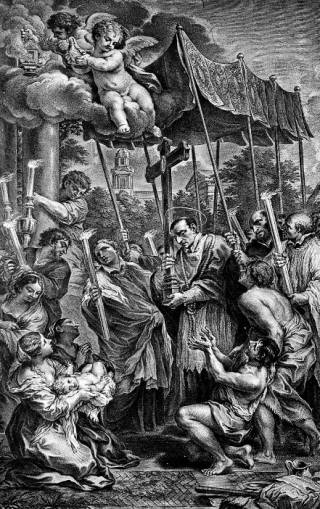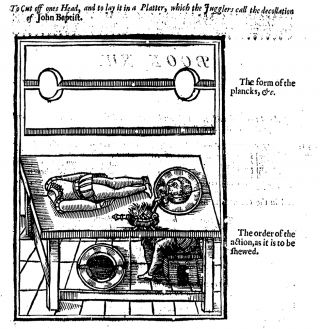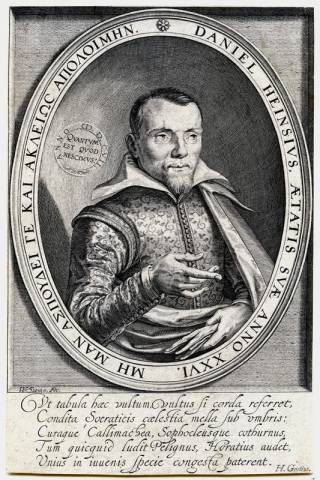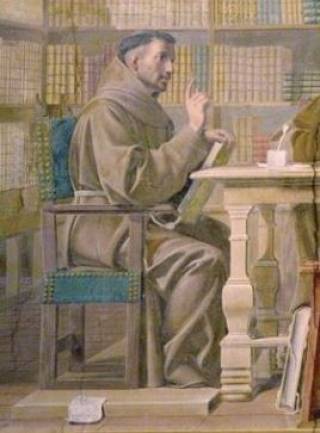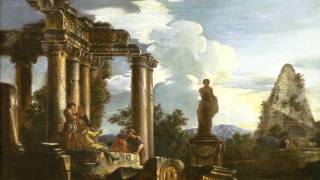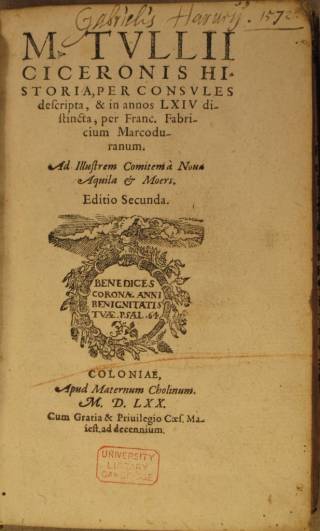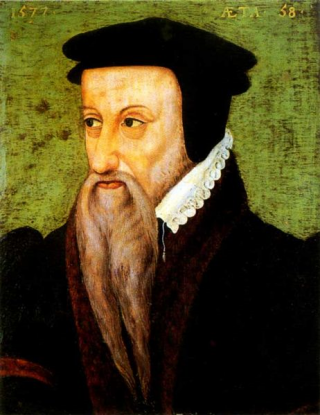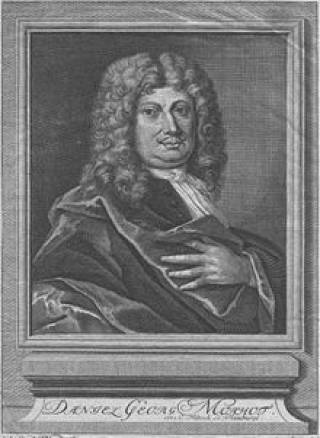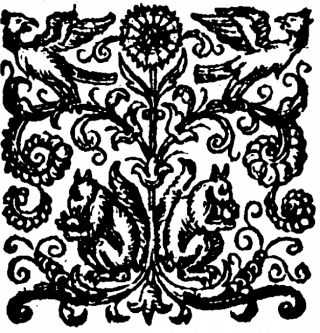
Baroque Latinity
an AHRC-funded research network
May 2019 – March 2022
The funded period of this project has come to an end, but the website remains active. The PI and Co-I welcome any contributions, in the form of short essays on 'Baroque Latinity' or items for the bibliography.
Principal Investigator
- Prof. Gesine Manuwald, Dept of Greek & Latin, UCL
Gesine Manuwald is Professor of Latin in the Department of Greek and Latin at University College London (UCL). Her main research interests are Roman drama, oratory and epic as well as Neo-Latin literature. She has co-edited Neo-Latin Poetry in the British Isles (2012), is one of the editors of the Bloomsbury Neo-Latin Series and the main editor of Brill’s Research Perspectives in Latinity and Classical Reception in the Early Modern Period; she is the President of the Society for Neo-Latin Studies (SNLS).
https://www.ucl.ac.uk/classics/people/full-time-staff/gesine-manuwald
Co-Investigator
- Dr Jacqueline Glomski, Centre for Editing Lives & Letters (CELL), UCL
Jacqueline Glomski is Honorary Senior Research Associate in the Centre for Editing Lives & Letters at University College London. Her present work focuses on Baroque Neo-Latin prose writing, especially seventeenth-century treatises on libraries and book collecting. She is the co-editor of, and contributor to Seventeenth-Century Fiction: Text & Transmission (2016) and Acta Conventus Neo-Latini Monasteriensis: Proceedings of the Fifteenth International Congress of Neo-Latin Studies (2015). She has also contributed to A Guide to Neo-Latin Literature (2017) and Der neulateinische Roman als Medium seiner Zeit / The Neo-Latin Novel in its Time (2013). Dr Glomski is a fellow of the Royal Historical Society; she is Vice-President of the Society for Neo-Latin Studies.
https://www.livesandletters.ac.uk/people/jacqueline-glomski
Participants
- Prof. Jan Bloemendal, Huygens Institute for the History of the Netherlands, Royal Netherlands Academy of Arts and Sciences, Amsterdam NETHERLANDS / Ruhr University, Bochum GERMANY
Jan Bloemendal studied Classics, Dutch Studies, and Theology. Currently, he is a senior researcher at the Huygens Institute for the History of the Netherlands (Royal Netherlands Academy of Arts and Sciences), and Privatdozent at Ruhr University-Bochum, and specializes in Neo-Latin drama and Erasmus studies. He is the Secretary to the Amsterdam edition of the Erasmi Opera Omnia (ASD) and general editor of the Brill series 'Drama and Theatre in Early Modern Europe'. He co-edited Brill's Encyclopaedia of the Neo-Latin World (2014).
https://de.wikipedia.org/wiki/Jan_Bloemendal- Prof. Paul Gwyne, Interdisciplinary Studies, American University of Rome ITALY
Paul Gwynne is Professor of Medieval and Renaissance Studies at The American University of Rome. His areas of research focus on fifteenth- and sixteenth-century Europe, the rise and diffusion of Italian Humanism and the reception of the classical tradition. These subjects are reflected in a number of articles and chapters in books as well as a trilogy of monographs which review the production of neo-Latin poetry in Rome from 1480-1600: Poets and Princes: The Panegyric Poetry of Johannes Michael Nagonius (Turnhout: Brepols, 2013); Patterns of Patronage in Renaissance Rome: Francesco Sperulo: Poet, Prelate, Soldier, Spy (Oxford: Peter Lang, 2015); Francesco Benci: Quinque martyres (Leiden: Brill, 2017). With Bernhard Schirg he is the editor of the collection of essays: The Economics of Poetry: Efficient Production of Neo-Latin Poetry 1400-1720 (Oxford: Peter Lang, 2018).
https://aur.edu/node/217- Dr Jason Harris, Centre for Neo-Latin Studies, University College Cork IRELAND
Jason Harris is a Lecturer in History and the Director of the Centre for Neo-Latin Studies in University College Cork, Ireland. He is also the founder and director of the Schola Latina and Conventiculum Corcagiense in Cork, promoting active use of Latin as a research tool. His own research is focused on the intellectual culture of early-modern Europe, drawing upon philological and anthropological approaches to history in order to illuminate Neo-Latin Latin texts. He is particularly interested in Irish Latin writers and in the intellectual circle surrounding Abraham Ortelius. Currently, he is writing a book about the practical impact of Neo-Latin stylistic debates upon the prose style of Irish Latin writers.
http://publish.ucc.ie/researchprofiles/A019/jharris
https://www.ucc.ie/en/cnls/- Prof. Yasmin Haskell, Faculty of Arts, University of Western Australia
Yasmin Haskell FAHA (PhD Sydney, 1996) is Cassamarca Foundation Chair in Latin Humanism at the University of Western Australia, Perth. She has published on Renaissance and later Neo-Latin literature, especially by Jesuits, and its connections with the history of science, medicine and emotions. From 2010-18 she was Foundation Chief Investigator, then Partner Investigator, of the Australian Research Council Centre of Excellence for the History of Emotions: 1100-1800, and from 2017-2018, Chair of Latin and Director of the Institute of Greece, Rome and the Classical Tradition at the University of Bristol. She is author of Loyola’s Bees: Ideology and Industry in Jesuit Latin Didactic Poetry (OUP, 2003) and Prescribing Ovid: The Latin Works and Networks of the Enlightened Dr Heerkens (Bloomsbury, 2013), and editor (with Christopher Allen and Frances Muecke) of Charles-Alphonse De Arte Graphica (1664) (Droz, 2005), Diseases of the Imagination and Imaginary Disease in the Early Modern Period (Brepols, 2011), Latinity and Alterity in the Early Modern Period (Brepols, 2011) (with Juanita Ruys), and most recently, with Raphaele Garrod, of Changing Hearts: Performing Jesuit Emotions Between Europe, Asia and the Americas (Brill, 2019). Professor Haskell serves on several editorial and advisory boards, including ‘Bibliotheca Latinitatis Novae’ (Leuven) and the Journal of Jesuit Studies (Brill) and its associated book series ‘Jesuit Studies’ and ‘Jesuit Latin Library’. Her current research interests include Latin in the Enlightenment and Latin written by Jesuits/ ex-Jesuits during the Suppression of the Society of Jesus. She is writing a synoptic monograph about Jesuit Latin poetry and education.
https://research-repository.uwa.edu.au/en/persons/yasmin-haskell- Dr Luke Houghton, Dept of Greek & Latin, UCL
Luke Houghton is an Honorary Research Fellow of the Department of Greek and Latin at University College London. He also teaches Classics and is Keeper of the Scholars at Rugby School. He previously taught at a number of UK universities (including Glasgow, Reading, UCL and Birkbeck), and has held visiting fellowships at the British School at Rome, the Warburg Institute in London, and the Ludwig Boltzmann Institute for Neo-Latin Studies in Innsbruck. He is the author of Virgil's Fourth Eclogue in the Italian Renaissance (CUP, 2019), and has edited Perceptions of Horace (with Maria Wyke; CUP, 2009), Neo-Latin Poetry in the British Isles (with Gesine Manuwald; Bloomsbury, 2012), and Virgil and Renaissance Culture (with Marco Sgarbi; ACMRS/Brepols, 2018). A new Anthology of British Neo-Latin Literature, edited with Gesine Manuwald and Lucy R. Nicholas, is forthcoming from Bloomsbury Academic. His main interests are Neo-Latin poetry and the reception of Roman authors (especially Virgil, Horace, Ovid and the elegists) in later art and literature.
https://www.ucl.ac.uk/classics/people/honorary-positions/luke-houghton- Prof. Sarah Knight, School of Arts, University of Leicester
Sarah Knight teaches, edits, translates and writes about sixteenth- and seventeenth-century literature, especially English and Latin works. Professor Knight is particularly interested in early modern student life across Europe, and has published widely on the associations between poetic and rhetorical composition, and educational experience. She has a related interest in the impact of multilingualism on early modern writing, especially how authors represent linguistic difference in English, French, Italian and Latin, and other languages. She has edited and translated works ranging from the mid-fifteenth to the seventeenth centuries, including Leon Battista Alberti's Momus and the accounts of Elizabeth I's visits to Oxford in 1566 and 1592, and is currently editing John Milton's student speeches (the Prolusiones) and his Epistolae Familiares, and Fulke Greville's two English tragedies Alaham and Mustapha.
https://www2.le.ac.uk/departments/english/people/sarahknight- Dr David McOmish, Institute for Advanced Studies, University of Edinburgh / School of Humanities, University of Glasgow
David McOmish is a Research Fellow at the Institute for Advanced Studies in the Humanities at the University of Edinburgh and an Honorary Research Fellow in the School of Humanities at the University of Glasgow. A former engineer and classicist, he has spent the last ten years researching the institutional and literary settings of the new sciences in the early modern period, especially within European and Scottish universities. He has recently published several articles on the Scientific Revolution in Scotland, Italian intellectual culture and its transformative impact on pre-Enlightenment Scotland, and more generally on the role of scientific poetry and Aristotelian literature in the classrooms of Europe and Scotland. His current project at Edinburgh is producing a comprehensive bibliography of all texts used for instruction in mathematics and cosmology at the University of Edinburgh across the 17th century
www.iash.ed.ac.uk/profile/dr-david-mcomish- Dr Victoria Moul, Dept of Greek & Latin, UCL
Victoria Moul is a Reader in Early Modern Latin & English at UCL. She works on the Latin-vernacular bilingualism of literary culture in early modern Europe, with a particular focus upon poetry between c. 1550 and 1720. She has published widely on both English and neo-Latin poetry, as well as classical translation and imitation in this period. Recent publications include the Cambridge Guide to Neo-Latin Literature (2017) and a series of articles on Cromwell’s forgotten poet laureate, Payne Fisher. She is currently running a large Leverhulme Trust-funded project surveying for the first time post-medieval Latin verse in English manuscript sources dating from between 1550 and 1720. Her next book, English and Latin Poetry in Early Modern England, will be published by CUP, probably in 2021.
www.ucl.ac.uk/classics/people/full-time-staff/victoria-moul- Dr Lucy Nicholas, Dept of Classics, King's College London / Warburg Institute, University of London
Dr Lucy Rachel Nicholas teaches classical and post-classical Latin and Greek at King’s College London and the Warburg Institute. She is especially interested in projects which bridge the fields of Neo-Latin and Reformation History. Her doctoral thesis comprised a translation and contextual analysis of a Latin treatise on the Eucharist by the sixteenth century English humanist and Cambridge classical scholar, Roger Ascham. Aspects of this have been published as ‘Roger Ascham’s Defence of the Lord’s Supper’, Reformation, vol. 20 (2015) and Roger Ascham’s ‘A Defence of the Lord’s Supper’: Latin Text and English Translation (Brill, 2017). She is currently in the final stages of assembling an edited volume entitled Roger Ascham and his Sixteenth-Century World (Brill, forthcoming) and co-editing two Neo-Latin Anthologies on Britain and Europe (Bloomsbury, forthcoming). She has also written on Thomas More, and her chapter on the Latin Utopias of the early modern period will soon be available in the forthcoming Oxford Handbook of Thomas More’s Utopia (OUP, eds. C. Shrank and P. Withington). Her role as Latin Editor on the Thomas Nashe Project and her participation in the Baroque Latinity Network have brought her into close contact with the writing of Thomas Nashe and Gabriel Harvey. Her current research focuses on the Latin works of Johannes Sturm and Walter Haddon.
https://kcl.academia.edu/LucyNicholas- Prof. Jan Papy, Seminarium Philologiae Humanisticae, KU Leuven BELGIUM
Jan Papy, PhD Classics (1992) and MPhil (1996), is Professor Ordinarius of Latin and Neo-Latin Literature at the University of Leuven. His research focuses on Renaissance Humanism and Neo-Latin literature, with special attention to Renaissance philosophy, the cultural history of the Low Countries, and the history of universities and history of science. In 2003 he was Laureate of the Belgian Royal Academy of Sciences. He has published numerous articles on Justus Lipsius, Erasmus, Vives, and Petrarch. Together with Karl Enenkel he edited Petrarch and his Readers in the Renaissance (Leiden-Boston: Brill, 2006). Last year, he coordinated an exhibition and edited a collection of studies on the Louvain Collegium Trilingue (Louvain: Peeters, 2017). For his exhibition ‘Erasmus' Dream’, he was awarded the Year Price 2018 of Science Communication by the Royal Flemish Academy of Belgium for Science and the Arts. He equally received the Martin Burr Award by the Henry Sweet Society for the History of Linguistic Ideas.
He has been co-editor of Humanistica Lovaniensia: Journal of Neo-Latin Studies (Leuven University Press) (2004–2017) and of Lias: Journal of Early Modern Intellectual Culture and its Sources (Peeters Publishers, Leuven-Paris) (2009–2019). He is currently co-editor of the series Supplementa Humanistica Lovaniensia (Leuven University Press) and member of the editorial board of ‘Erasmus Studies’ (Brill Publishers Leiden).
A full list of his publications is available on:
http://lirias.kuleuven.be/cv?Username=U0016670
Website of the Leuven Seminarium Philologiae Humanisticae:
https://www.arts.kuleuven.be/sph/members/00016670- Prof. Florian Schaffenrath, Ludwig Boltzmann Institute for Neo-Latin Studies, Innsbruck AUSTRIA
In the field of Neo-Latin studies, Florian Schaffenrath is especially interested in epic poetry. For his PhD thesis, he published an edition of the poem Columbus of Father Ubertino Carrara SJ (Rome 1715), an epic poem in twelve books about the first voyage of Christopher Columbus to the New World. He has published shorter articles that deal inter alia with Petrarch’s Africa and Sannazaro’s De partu Virginis. As a member of the research group ‘Geschichte der lateinischen Literatur in Tirol’ (published in 2012), Schaffenrath is also interested in the regional history of Neo-Latin literature. He has edited several texts and published numerous articles on the subject of the Tirol. Schaffenrath is a member of the ‘International Association of Neo-Latin Studies’ (IANLS) and of the ‘Die Neulateinische Gesellschaft’ (DNG). At the LBI for Neo-Latin Studies he was a key researcher in the ‘Politics’ line, before he went to Freiburg University with a Alexander-von-Humboldt fellowship. In August 2014 he finished his Habilitation, on Cicero's Philippics, and in September 2014 Schaffenrath succeeded Stefan Tilg as director of the LBI for Neolatin Studies.
https://neolatin.lbg.ac.at/team/florian-schaffenrath- Dr Paul White, Dept of Classics, University of Leeds
I work on Neo-Latin poetry, commentaries and print culture, with a primary focus on the French sixteenth century. In relation to baroque Latinity, there are two strands to my current research: one concerns the vogue for adoxographical works in praise of ‘nothing’ written in response to Jean Passerat’s De nihilo; the other is a larger project on Neo-Latin love elegy collections, part of which focuses on the relation between this genre and mannerism and baroque in vernacular lyric.I have published articles on poetry, education, authorship and print culture in Latin and French vernacular contexts, and am the author of books on the early modern reception of Ovid’s Heroides (Ohio State University Press, 2009), on the classical editions and commentaries of the Paris-based printer and author Jodocus Badius Ascensius (OUP, 2013), and on the reception of the elegist Gaius Cornelius Gallus in the Renaissance (Routledge, 2019).
https://ahc.leeds.ac.uk/languages/staff/1237/dr-paul-white
Research Themes
- Research Themes
Baroque (c. 1580–c. 1720) is important as the earliest aesthetic – and cultural – movement to have global impact since it was spread through dynastic ambition, mercantilism, and missionary fervour. Latin, as a supranational language, played a major role in propagating this style. In literature, Baroque was characterized by rhetorical devices, especially through exaggerated forms such as paradoxes, anachronisms, antitheses, and oxymora that roused the emotions and engaged the senses. Interfacing with vernacular literature, the Neo-Latin literature of the seventeenth century contributed not only to the development of drama, but to the rise of the novel, as well as to the evolution of more traditional forms such as the epic and the epigram. Beyond belles lettres, Latin supplied lyrics to musical compositions of the time and was employed in the visual arts. In politics, Latin served as the language of treatises and contracts; in religion, it furthered the Roman Catholic Counter-Reformation. It became the language of international scientific communication, used to announce and explain new discoveries. The ability to write in the common European language of scholarship was an indicator of educational achievement in an age when rhetorical and grammatical competence was demanded.
Our network, Baroque Latinity, aims to engage with the current revival of Baroque studies by addressing Baroque both as a literary style, one that distorted the norms based on the Greeks and Romans that had been systematized in the Renaissance, and as an artistic period, a complex stage in the development of post-Renaissance classicism.
During our workshops, we will address the following major questions:
1. How does writing in Latin relate to the concept of the Baroque?
2. Is there a unity to be found in the corpus of Neo-Latin texts that spans the close of the Renaissance and the emergence of the Neo-Classical age?
3. How can we describe the technical and aesthetic sophistication of Baroque Latinity?
4. How is Latin used to express the new ideas of the Baroque era – in politics, commerce, science, and art; and, what role does Latin play in the functioning of the new international intellectual movements of the time?
5. How successful is Latin at maintaining its dominance as an international language during the Baroque period – both within and outside of Europe?
Baroque Latinity - Topics
- Baroque Science: A discussion of the book by Ofer Gal and Raz Chen-Morris (Chicago University Press, 2013)
David McOmish
University of Edinburg/University of GlasgowAlthough it was first published in 2013, Baroque Science by Ofer Gal and Raz Chen-Morris continues to generate lively debate amongst historians of science. The book (or project – the book under review was a product of a series of funded projects and workshops at the University of Sydney) attempts to show that some of the major developments of the new sciences in the seventeenth century are inextricably linked to broader, contemporary baroque culture. Gal and Chen-Morris argue that this culture is characterised by an increasing lack of confidence in human senses and a self-aware, imperfect reliance upon abstraction and imagination. A particular focus of the book is upon emphasising the tensions that arose among a series of prominent actors when considering these limitations. In Gal and Chen-Morris' account of these actors (especially Kepler, Galileo, and Descartes), a shattered sense of confidence in the efficacy of human perception brings a paradoxical mix of, and an increasing confidence in the ability of the imagination to approach an approximation of external reality. The alienation from former certainties of Aristotelian reasoning and the truth of human sense perception, which the book demonstrates is found in Baroque art, is likewise found in science and philosophy. Despite its focus upon a limited number of authors and works, the book constructs a compelling interpretation and explanation of an especially significant intellectual development. In doing so, it lays the groundwork for, and encourages future scholarly activity.
Kepler and Newton bookend the temporal framework within which Gal and Chen-Morris' Baroque Science takes place. However, their account is not a simple chronological narrative of the rise of the new science in the seventeenth century. Chen-Morris and Gal divide the book into three main areas: observation (pp. 1-114); mathematization (pp. 115-230); and passions (pp. 231-82). These sections provide the interpretative lens through which both authors trace the outlines of the development of ideas across the period. The change in the way human sight was understood is the compelling story at the centre of the observation section of the book. Kepler is introduced as the game-changing figure in this regard, in his work on optics. Much has been said about Kepler's optics, but Gal and Chen-Morris present a fresh, clear-sighted understanding of how the new optical theories affected contemporaries who had been raised on the old Aristotelian theories of human sensory functions. The instrumentalisation and naturalisation of the eye, the construction of analogous, artificial aids to its function (telescopes, microscopes) all contribute in Gal and Chen-Morris' account to a collapse in confidence in the interpretative powers of the unmediated eye. The response of key actors to this challenge is at the heart of this work and at the heart of its definition of 'baroque' science. The mathematisation of nature in this context represents a necessary attempt to enforce an abstract template onto a messy natural world, whose parameters we fail to understand – as opposed to using mathematics to recognise with precision the reality of nature (pace Galileo's maxim on the laws of nature written in mathematical language). The final chapter then follows naturally, with an exploration of how Descartes understood the role of imagination in this post-Aristotelian world. The intellectual incompatibility of 'dead-end' neo-Stoic wisdom and the inquisitiveness and uncertain path of the New Sciences are highlighted to reveal the challenge that the baroque posed (pp. 272-73). Imagination becomes a ladder out of the pit of extreme scepticism in the face of knowledge of sensory limitations and an untameable (mathematically) nature. Anyone who has spent a considerable part of their time with Latin writers from the late sixteenth and early seventeenth century will instantly recognise and understand the universe Gal and Chen-Morris describe here. The cohabitation in one mind of wisdom-based and observation-based data, unresolved and in opposition, yet both clearly understood, is a defining characteristic of seventeenth-century Latin literature.
This debate is particularly relevant to our own efforts on the Baroque Latinity project. It provides an important framework to apprehend and evaluate when considering the broader literary world of seventeenth-century Latin Literature of which the works of Baroque Science are a part. Chen-Morris and Gal lay useful foundations for development. One of the limitations of the book, which the authors themselves acknowledge, is the focus upon a narrow canon of works and authors. However, this limitation offers opportunity for development. It offers an opportunity to re-examine many of the familiar texts (Somnium, Sidereus Nuncius, Ptolemaic and Copernican Commentaries, and so on) of this period with a renewed baroque emphasis on choice of genre, recurring terms, lexical evolution, and other linguistic and literary conventions. More significantly, this book should be understood as a siren call to use those conventions to examine the 'vast sleeping tomes' (Frances A. Yates, ‘The Hermetic Tradition in the Renaissance’, in Art, Science, and History in the Renaissance, pp. 255-74. at 272), which explain what gave rise to and what followed from the work of Kepler, Galileo, and Newton.
This final consideration takes us back to an ongoing discussion within our project group: to what extent can we trace some of the more prominent literary and stylistic developments of 'Baroque Latinity' back to the key transformative phenomena shaping discourse in the quickly evolving intellectual culture of seventeenth-century Europe (and its expanding political and geographical horizons)? What does Kepler's Somnium share in common with Vermeer's art (Gal and Chen-Morris use Vermeer's work as the art analogue, pp. 1-7)? Can the literary, intellectual, and artistic common ground be reasonably attributed to a shared Baroque culture? If so, how? Moving beyond value judgements of good and bad literature/art/science, towards an understanding of the manner in which their shared intellectual conceptions were created is the path that Gal and Chen-Morris suggest is one well worth taking. It is true that the book's focus is upon the happy few who are now well known, but they clearly set out a template that can be reused. A renewed research focus upon the underlying linguistic mechanics of scientific knowledge in this specific and well-defined episteme, located firmly within a Latin context, is a clear desideratum. Baroque literature's expansive bookshelves present the Latinist with incredible opportunities to develop Gal and Chen-Morris' work. As well as the direct route to comparison, there is the dialectical route, with a focus upon the antecedent influences, and the possibility to discern real intellectual and related literary development. Yates' above comments in relation to Kepler, Newton, and Galileo were focused upon this discursive, dialectical, and formative relationship between new texts and their immediate antecedents. Take, for example, the commentary tradition in the medieval schools, which existed as a cornerstone of the generic canon of scholastic literature. In form, these commentaries change little over a considerable period of time. Many of the same 'authority' authors and texts persist into this Baroque period. However, the choice of core text, the changing nature of its authority, the lexical evolutions of its textual semina, the repeated occurrence of key phrases and terms, and the influence of their generic conventions upon knowledge formation are products of the cultural environment in which they were formed. A Baroque Latinity focus provides a great opportunity to bring some further definition to the intellectual culture whose beginning and progress Gal and Chen-Morris discuss.
- The Jesuit Latin 'baroque'
The term ‘baroque’ was originally applied to the artistic commissions of the Jesuits, to a style characterized by movement, drama, grandeur and opulence, one that sought to evoke emotions of surprise and awe to inspire and confirm Catholic piety. It has of course come to be associated more broadly with all sorts of literature from the seventeenth century that has little to do with the Jesuits, at least directly, with texts ranging from the sensational and ostentatious to the ingenious and puzzling, from culteranismo to conceptismo. [1] What might ‘baroque’ mean specifically in the context of Jesuit Latinity? Writers of the Society of Jesus produced plenty of neo-Latin poetry and prose from the late sixteenth to late eighteenth centuries that might be variously described as florid, sentimental, histrionic, or – choose your baroque poison! — arch and ‘argutial’. But does rhetoricality or theatricality, compression or wit, or a self-conscious anti-classicism define the Jesuit Latin baroque? Is a finer categorization possible or necessary? To play Devil’s advocate, does it make sense to speak of Jesuit Latin ‘(neo-)classicism’, ‘mannerism’ or ‘rococo’?
There are dangers in the periodization of Jesuit neo-Latinity, and certainly in the facile pairing of literary and artistic styles, and yet the order’s close collaboration with prominent baroque artists, engravers and architects is not without significance. Bernini and Rubens immediately spring to mind but we can also point to the Society’s enthusiastic exploitation of the Renaissance genre of the emblem book. The imagery of their 100th-anniversary Imago primi saeculi, published in Antwerp in 1640, fits the ‘baroque’ bill well enough: elaborate, organic cartouches frame curious scenes of nature and art featuring industrious putti. Marc Fumaroli has read this magnificent folio as a virtual space, inviting the imaginative reconstruction by the reader of a temple with six chapels, overlaid on a drama in five acts on the life of the Society. The exuberance, abundance and apparent boastfulness of the Imago left it wide open for attack by the Augustinian ‘Messieurs’ of Port Royal, and the Jesuits’ ‘Asianic’ Neo-Latin became the foil for a vernacular ‘Atticism’ that prided itself on Gallic simplicity and humility (in the prose of de Sacy and Pascal, for example). [2]
The Latin prose of the Imago is the work of many hands. The collective (anonymous) authors plead haste in bringing the volume together in time for the order’s birthday party, and the ‘lengthy and even overwhelming prose texts in all six books are intertwined with numerous rhetorical and poetical exercises: exercitationes oratoriae, encomiastic poetry, elegies, ludi poetici, and, at the end of each section, a number of emblems’.[3] To the Jansenists, no doubt, epideictic rhetoric gone mad! But what of the gently riddling, mostly elegiac, poems that accompany the engravings – Sidronius Hosschius and Jacobus Wallius seem to have been responsible for these -- are they baroque? There is a playful cleverness here, to be sure, but one that is undergirded by a restrained classical elegance. And while the poems may be appreciated at face value, as Putnam has shown, the intertextuality with classical poets is by no means superficial. There are direct references to Virgil, Horace, and Ovid in the mottoes, and allusions primarily to Virgil, Catullus, and Propertius in the verses.[4]
Would it be possible to classify as ‘baroque’, then, that Jesuit Latin in which we find a concentration of silver Latin (and post-classical) models? The Paciecidos libri xii (1640) by the Portuguese Bartolomeu Pereira, on the martyrdom in Nagasaki of his heroic relative, Francesco Pacheco, was published in the same year as the Imago primi saeculi. Like most Jesuit epic it is constructed on a bedrock of Virgil, but the walls of its twelve books are stuccoed over with marvels, monsters, personified virtues and vices, and gods of the East Asian as well as Roman pantheon. Literary influences range from Lucan and Prudentius through to the vernacular Camões. Yet Pereira’s literary eclecticism, if not his extravagance, is foreshadowed in at least one late Renaissance Jesuit epic, Francesco Benci’s Quinque martyres (Rome 1592), on the five Jesuits martyred at Cuncolim, Southern India, in 1586, a ‘Virgilian’ poem liberally daubed with Lucretius, Lucan and Juvencus, Vida and Fracastoro. And if later eighteenth-century Jesuit Latinists were, on the whole, more chastely classical, perhaps less inclined to mix and match literary models than, e.g., the Milanese mathematician Tommaso Ceva, in his Lucretian-Horatian satire-cum-didactic Philosophia novo-antiqua (1704), we can still find traces of post-classical, neo-Latin, and even vernacular authors in the didactic and epic poetry of suppressed Jesuits José Manuel Peramás, Rafael Landivar and Emmanuel de Azevedo.
‘Art born from art’ (rather than nature) is one way to think about literary as well as artistic mannerism. Ernst Curtius preferred the term ‘mannerist’ to describe literature of any and all historical periods featuring a ‘thousand forms of unnaturalness’.[5] But ‘unnatural’ seems to me too reductive a description of the literary practice of the greatest Jesuit Latin writers of the seventeenth century -- Jeremias Drexel (1581-1638), Jakob Bidermann (1578-1639), Herman Hugo (1588-1629), Casimir Sarbievius (1595-1640), Jakob Balde (1604-1668) Jakob Masen (1606-1681), and Tommaso Ceva (1648-1737) -- however much they drew attention to literary (and literal) art, tied knots in their classical intertexts, and shuttled between allegory and history, word play and world. So... is it baroque? When Praz writes lyrically, even rapturously, about a ‘seventeenth-century frame of mind’, to explore and redeem the much-maligned poetry of Richard Crashaw, he is also implicitly redeeming the ‘baroque’ from the clutches of ‘mannerism’ and ‘Marinism’. If the Seicento traded, on the one hand, in symbols, conceits, ambiguities, and formal mannerisms it could be transported, too – says Praz -- in spiritual ecstasies, such as that of (Bernini’s) St Teresa, and stirred by profound emotion. Praz’s intincts are aesthetic and belletristic, however, and I think we lose sight of what is distinctive in Jesuit Latinity if we judge it solely in these terms, let alone against the standards of contemporary visual art.[6]
I’m not saying that Jesuits weren’t influenced by, and probably even more, influenced international literary trends in the Seicento. The craze for agudeza was fanned by writers such as Emmanuele Tesauro and Baltazar Gracian.[7] And ‘baroque’ is a convenient descriptor for some of the more sumptuous specimens of seventeenth-century Jesuit Latin writing. The didactic poetry and prose of the Neapolitan Jesuits Niccolò Giannettasio, Francesco Eulalio Savastano and Tommaso Strozzi is studded with exotic flora and fauna, marvellous ekphrases and epyllia, and infused with poetic sugar and chocolate.[8] In his De mentis potu sive de cocolatis opificio, Strozzi, for example, celebrates the posthumous union of chocolate tree and vanilla nymph in these sensual, if not erotic, verses:
Illam languiduli circum zephyrique jocantesque
Aurillae allambunt, dulcique per oscula furto,
Fragrantem rapiunt animam, vectamque volucri
Remigio alarum vicina per avia fundunt.
Hanc tenera arcano Cacai virgula suctu
Haurit, & extinctae illecebras, ac munera Nymphae
Agnoscens, laeto vegetat sua germina succo.
The languid little zephyrs and playful breezelets lick her, and with these sweet stolen kisses snatch her fragrant soul, and with the swift oarage of wings carry and pour it over the fields nearby. A tender little twig of Cacao drinks her in suck, and recognizing the charms and favours nymph, quickens his buds with happy sap.
If Strozzi’s style sometimes borders on the tasteless, it is never insipid![9]
Perhaps the greatest seventeenth-century Jesuit dramatist, Jakob Bidermann, in his epic on the massacre of Bethlehem, Herodiados libri iii,[10] presents us with a pathetic scene of frustrated filial piety which is as macabre as anything in Marino’s Strage:
Mater
An moritura taces? Ne ad Haemum respicis? Haemus
Hîc tuus, Haemus ego. Genitrix mea, negligis Haemum?
Audiit illa Haemi iam paenè emortua nomen,
Atque oblita sui, solito de more parabat
Stringere complexu venientem. At brachia nusquam
Quae collo inijcerentur, erant. Iterumque retentat,
Atque iterum truncos humeros orbata lacertis,
Ac manibus defecta movet. Tum denique solos
Omnibus e membris sibi sensit Elysa relictos
Semianimis oculos: Hos illa reclusit ad Haemi
Nomen, & adspecto satiata recondidit Haemo.
“Mother, or are you silent because you are about to die? And do you not see your Haemus? Here is your Haemus. I am your Haemus. Mother who bore me, do you not know your Haemus?” She, now almost dead, heard the name of Haemus, and forgetting herself, she prepared tightly to embrace him as he approached. But arms that could be cast around his neck were nowhere. And again she tries, and again she shrugs her maimed shoulders, lacking forearms and hands. Then, at last, Elysa perceives that, of all her organs, only her semi-conscious eyes remain: and she opens these at the name of Haemus, and closes them, content with the sight of Haemus”. (Book 1, §47)
The Germans Bidermann, Balde, Drexel, Bisselius and Masen look ‘baroque’ from any angle, and were virtuosic and versatile writers across a range of genres, from poetry and plays to novels. Masen produced a series of textbooks on poetic and prose composition and on the ars nova argutiarum. But I would like to suggest that teaching is the real key to this literature, one that opens more doors to Jesuit Latinity (let alone spirituality) than ‘baroque’. In the above passage from Bidermann, the didactic repetition of ‘Haemus’ (nomen-omen), and the faint recollections of the failed embraces of Orpheus and Eurydice and Venus and Aeneas, have all the hallmarks of an exemplary school exercise, no doubt designed to appeal to an audience of boys in the ‘Humanities’ or ‘Rhetoric’ class who were familiar with the Virgilian intertexts.[11] In my forthcoming book, Jesuits at Play: Latin Poetry and Team Spirit in the Early Modern Society of Jesus, I am exploring the ‘ludic’ elements of early modern Jesuit education and culture, elements which infuse the literary productions of the Society from Foundation to Suppression.[12]
© Yasmin Haskell
Cassamarca Chair of Latin Humanism
University of Western Australia, Perth
[1] Louis Martz and more recently e.g. Anthony Raspa have argued for the influence of Ignatius’s Spiritual Exercises on English Renaissance poets of the late sixteenth and early seventeenth centuries. See below on Mario Praz’s reading of Richard Crashaw’s verse in the light of contemporary Jesuit Latin.
[2] ‘Classicism and the Baroque: The Imago primi saeculi and Its Detractors’, in Art, Controversy and the Jesuits: The Imago Primi Saeculi (1640), ed. John W. O’Malley, S.J. (Philadelphia: St Joseph’s University Press, 2015), pp. 57-88.
[3] Marc Van Vaeck, Toon Van Hoodt and Lien Roggen, ‘The Imago primi saeculi Societatis Iesu as Emblematic Self-Presentation and Commitment, in Art, Controversy and the Jesuits, 127-410, at p. 127.
[4] ‘Introductions to the Latin, Greek, and Hebrew Poetry’, in Art, Controversy and the Jesuits, 411-22, at 411-14.
[5] European Literature and the Latin Middle Ages, trans. Willard R. Trask (Princeton 1953; new edition 1990), 282.
[6] Praz condemns Marino for being Italian (!), ‘hampered by tradition (to be an Italian poet meant being a Tuscan poet), being himself a refiner of the far-fetched compliments of the Petrarchan school, rather than a revolutionary, could be baroque only half-heartedly. The yoke of tradition weighed less heavily on the painters…’ (p. 252). Crashaw, however, is compared in his better moments to Rubens, Murillo and El Greco.
[7] Praz elicits many convincing connections between Crashaw’s in poetry and that of Jesuit epigrammatists and lyricists from Sarbiewski to Cabilliau.
[8] Giannettasio’s poetry is accompanied by glorious engravings by the baroque artist, Francesco Solimena.
[9] Later he will describe the delivery of a cup of restorative chocolate to St Rose of Lima by her guardian angel, in terms which are simultaneously erotic and suggestive of the mass: ‘she eagerly immerses her mouth and whole mind into the wounds of the betrothed, and drawing deep, sucks the sweetness and life from the Deity, by which she lulls the seethings of her mind and the fever, and her limbs’ (suffixi in vulnera sponsi / Os animumque omnem vivax demergit; & alto / Delicias haustu, vitamque e Numine sugit: / Queis animi, febrisque aestus, ac membra soporat; 1689, 71).
[10] Published 1622 but composed at the turn of the century.
[11] In fact the poem was dedicated to the seven-year-old Prince Philip William, Elector Palatine. See further Y. Haskell, ‘Child Murder and Child’s Play: The Emotions of Children in Jakob Bidermann’s epic on the Massacre of the Innocents (Herodiados libri iii, 1622), International Journal of the Classical Tradition 20 (2013): 83-100.
[12] For a foretaste, see my ‘Latinitas Iesu: Neo-Latin Writing and the Literary-Emotional Communities of the Old Society of Jesus’, in Oxford Handbook of the Jesuits, ed. Ines Zupanov.
- Milton, 'Elegia Tertia': a Baroque Latin Poem?
Milton, ‘Elegia Tertia’: a baroque Latin poem?
by Sarah Knight
Milton wrote the sixty-eight lines of ‘Elegia Tertia’ as a Cambridge undergraduate, to mark the death of the famous scholar, preacher, translator and bishop Lancelot Andrewes (1555-1626). Andrewes is framed as the speaker’s priority amidst several other upsetting preoccupations: ‘[a]t te praecipue luxi dignissime praesul’ (but mainly I mourned for you, most worthy of bishops; line 13). I first wrote about the poem in an essay published nearly a decade ago, but was conscious of reading it differently in 2020 for two reasons. First, for the purpose of the April ‘Learned Baroque’ workshop, I was considering whether Milton’s Latin exemplifies particular figurative and rhetorical qualities that might be called ‘baroque’, weighing the value of over a century’s-worth of art historical scholarship on this aesthetic category, in particular, against the awareness that Milton and his contemporaries would not have recognised the category themselves.
The second reason for reading the poem differently in 2020 was that although I had suggested ‘Elegia Tertia’ as a text for discussion long before Covid-19 had spread, I remembered on re-reading that it starts with an outbreak of plague. Andrewes’ death is first mentioned thirteen lines after an account of the 1625-26 epidemic in which his brothers Thomas and Nicholas had died, and epidemics also affected the poem’s author several times during his life: as a Cambridge student; when plague struck again a decade later; and in his last decade, when he stayed during the ‘Great Plague’ of 1665-66 with his wife and family in Chalfont St. Giles. A Londoner, like Milton, Andrewes was buried in St. Saviour’s Church, now Southwark Cathedral, and given the context, it seemed appropriate that during the workshop, St. Giles Cripplegate, where Milton is buried, was distantly visible in the background of a colleague’s computer screen.
Most discussions of Milton and the baroque have tended to concentrate on the English poetry, especially Paradise Lost (1667). E.M.W. Tillyard, who, with his wife Phyllis, had edited and translated much of Milton’s student Latin writing, compared Milton in 1938 to ‘Rubens, that other great neo-classic exuberant of the seventeenth century’. Tillyard found an illustrative example in Book 6, when the angels ‘[m]ain promontories flung, which in the air/Came shadowing’ upon the ‘rebel host’ (lines 639-656), which he describes as ‘reminding of a great baroque painting’. In Milton and the Baroque (1980), too, Murray Royston argues that the war in heaven is ‘a solemnly conceived scene of immense vigour and turmoil, a baroque clash of forces such as Rubens would have delighted to paint’. Falling chronologically between Tillyard and Royston, one of the few scholars to consider Milton’s Latin writing in terms of baroque aesthetics is M.M. Mahood, who cites ‘Elegia Tertia’ in her Poetry and Humanism (1950). For Mahood, though, the painterly comparison is with an image of ecclesiastical apotheosis rather than epic confrontation: ‘Milton’s vision of Lancelot Andrewes’s triumphal entry into the roseate light and rose-scented air of a vinous heaven might, translated into tempera, adorn the cupola of any baroque church’. Mahood’s note cites lines 51-64 of the poem, where the speaker dreams of Andrewes being welcomed by ‘the heavenly host, who clap their jewel-studded wings’ ([a]gmina gemmatis plaudunt caelestia pennis; line 59), in a lush multi-sensory vision in which sight, sound and fragrance are all evoked. The speaker instructs us here to ‘See’ (Ecce; line 53) with him the vision of the bishop of Winchester (praesul Wintonius). If we imagine how a ‘great baroque painting’ or painter would render the ‘starry brightness that gleamed on [Andrewes’] radiant face’ (Sydereum nitido fulsit in ore iubar; l. 54), the Rubens comparison here might be with a painting like the ‘Apotheosis of James I’ (c. 1632-4) on the ceiling of the Banqueting House at Whitehall, in which a thin nimbus of light, not quite a halo, surrounds the King’s white-grey hair, as he looks upwards towards a red-and-gold crown.
Royston points to the war in heaven in the English epic as the ‘baroque clash of forces such as Rubens would have delighted to paint’, but lines 9-12 of ‘Elegia Tertia’ also depict a brutal conflict in ‘Belgia’ (line 12) that Rubens in fact did go on to paint a few years after working on the Whitehall Stuart apotheosis. Milton’s subtitle, ‘In obitum Praesulis Wintonenis’ (On the death of the bishop of Winchester), makes explicit the poem’s commemoration of the loss of a famous individual, but the first part of the poem depicts more widespread fatalities caused by disease – the 1625-26 plague – and war. Ryan Hackenbracht has argued that several of these elements help to establish what he calls the poem’s ‘apocalyptic tone’. The art historian Gauvin Alexander Bailey has argued that ‘[b]aroque art was born out of calamity’, citing the many seventeenth-century outbreaks of plague and the Thirty Years War as particularly significant crises for its development. Milton’s poem represents just one of many outbreaks across Europe in that decade that were also captured, sometimes directly, sometimes allegorically, by contemporary painters including Poussin (e.g. ‘The Plague at Ashdod’, 1630) and Van Dyck, working in Sicily when the plague struck (see, for instance, his 1624 ‘Saint Rosalie Interceding for the Plague-stricken of Palermo’). The account of the plague in ‘Elegia Tertia’ is followed by the description of deaths of ‘lost leaders’ (amissos . . . duces; line 12) and ‘heroes’ (heroum; line 11) for whom ‘all Belgia wept’ ([f]levit . . . tota Belgia; line 12) in the earlier stages of the Thirty Years War (1618-48). Rubens depicted this conflict in his great allegorical painting ‘Consequences of War’ (1637-38), commissioned by Ferdinando II de’ Medici for the Palazzo Pitti in Florence. Milton’s poem individualises death in war, not least by representing these losses as personally affecting for the speaker: he cannot stop thinking about them, as we see from the repetition of the plangent verb ‘memini’ (I remembered) at lines 8 and 11. In a more abstract, allegorized manner, however, Rubens uses figurative art to show how war impedes art. Surrounded by other mythological and agonized human figures, including a Fury with her blazing torch, Mars crushes a book underfoot.
An intensely visual poem, ‘Elegia Tertia’ begins with a command to notice the speaker’s sadness and to look at the ‘imago’ (image) of what has caused it. Even if the spectacle is only present in the speaker’s imagination, this ‘imago’ and the emotions it has provoked are presented as inseparable. The first two words of the poem are ‘[m]oestus eram’ (I was grieving), and the speaker’s solitude heightens this feeling: he is ‘sitting silently’ (tacitus. . . sedebam), ‘without any company’ (nullo comitante; line 1), ‘and with many sad things clinging to [his] mind’ ([h]aerebantque animo tristia plura meo; line 2). We have seen how, when the vision of Andrewes first appears, the speaker commands the reader to ‘see’ (ecce; line 53), and at the very start, too, we are told to ‘look’ (en; line 3) with him at an ‘image of deadly catastrophe’ (funestae cladis imago) that has ‘suddenly arisen’ ([p]rotinus . . . subiit), an ‘imago’ that Libitina, the Italian goddess of funerals and corpses, has ‘made on English soil’ ([f]ecit in Angliaco . . . solo; line 4). The picture Milton prompts the reader to contemplate is of both Libitina and ‘dira mors’ (line 6), an early version of the ‘Grim Death’ Satan meets at the gates of hell at the end of Book 2 of Paradise Lost. This ‘dira mors’ is a social leveller calling the tune of its own danse macabre, having ‘entered the towers of princes’ (procerum ingressa est. . . turres; line 5) and ‘beaten down walls heavy with gold and jasper’ (pulsavit . . . auro gravidos et iaspide muros; line 7). Although critical discussions of Milton and the baroque have tended to focus on Paradise Lost, we find in this early Latin poem as well two of baroque art’s most characteristic aspects: suffering bodies graphically imagined, and the representation of an afterlife in richly idealised terms.
Further reading:
Gauvin Alexander Bailey. Baroque and Rococo. London: Phaidon. 2012. Quotation from page 33.
Sheila Barker. ‘Poussin, Plague, and Early Modern Medicine’. Art Bulletin 86.4 (2004): 659-689.
Gordon Campbell and Thomas N. Corns. John Milton: Life, Work, and Thought. Oxford: Oxford University Press. 2008.
Roland Mushat Frye. Milton’s Imagery and the Visual Arts: Iconographic Tradition in the Epic Poems. Princeton: Princeton University Press, 1978.
Ryan J. Hackenbracht. ‘The Plague of 1625-26, Apocalyptic Anticipation, and Milton’s Elegy III’. Studies in Philology 108.3 (2011): 403-438. Quotation from p. 427.
Sarah Knight, ‘Juvenes Ornatissimi: The Student Writing of George Herbert and John Milton’. In Neo-Latin Poetry in the British Isles, ed. by Luke Houghton and Gesine Manuwald. London: Bloomsbury Academic/Bristol Classical Press, 2012. Pp. 51-68.
M.M. Mahood. Poetry and Humanism. London: Cape. 1950. Quotation from page 203.
P.E. McCullough. ‘Andrewes, Lancelot (1555-1625), bishop of Winchester’. Oxford Dictionary of National Biography Online. Oxford University Press. January 2008.
Murray Royston. Milton and the Baroque. London: Macmillan. 1980. Quotation from page 119.
Xavier F. Solomon. Van Dyck in Sicily 1624-1625: Painting and the Plague. London: Silvana. 2012.
E.M.W. Tillyard. The Miltonic Setting, Past and Present. London: Chatto & Windus. 1938. Quotations from page 70 and 100.
- Baroque Rome in Maffeo Barberini's Verse Letter to Lorenzo Magalotti
Baroque Rome in Maffeo Barberini's Verse Letter to Lorenzo Magalotti
by
Stephen Harrison
Fellow and Tutor in Classics, Corpus Christi College, Oxford
Professor of Latin Literature, University of Oxford
Maffeo Barberini (1568-1644, Pope Urban VIII 1623-44) was a talented Latin poet whose verse was collected and widely published before and (especially) during his pontificate. He was also a central figure of Roman Baroque culture, painted by Caravaggio as a young cleric and later patron to Bernini during his papacy; he first favoured and then condemned Galileo and the poet Marino. One of the most attractive of his poems is a 147-hexameter epistle of the period 1609-11 (when Barberini was already a cardinal and bishop) to his friend Lorenzo Magalotti (1584-1637). Magalotti was then serving in the papal Curia as referendary of the Tribunals of the Apostolic Signatura (i.e. as a canon lawyer concerned with papal petitions), was later appointed as Urban’s own Cardinal Secretary of State (1623-28), and ended his career as bishop of Ferrara (1628-37).
The poem is framed as an invitation by Barberini to his friend to leave behind the business of the Curia in Rome and come for relaxation to the papal estate at Castel Gandolfo in the Alban Hills 25 km south-east of Rome, the site of the ancient city of Alba Longa. This estate was acquired by Clement VIII in 1596; Urban himself as Pope was later to convert the castle there into the extant papal palace, until recently a summer retreat for Popes and now a museum, with magnificent gardens and spectacular views over Rome and Lazio.
The poem looks back to Augustan Rome, combining a number of recognisably Horatian features (the hexameter epistle format, the invitation to a friend in high office to relax, the commendation of the country) with further classical frameworks. But it also focuses firmly on Baroque Rome, especially in lines 78-90 (my translation):
Quam iuuat intuitu magnas discernere moles
Urbis! Ab Esquiliis celsa testudine culmen
Porrigit eximii species miranda sacelli, 80
Quod tibi, Christi parens, almi lux prima pudoris,
Addictum posuit studium pietasque dicauit.
Qua coluit puroque colit te pectore Paulus:
Cuius opus pulchro surgens in colle Quirini
Se domus extollit, regali condita sumptu. 85
Excelsi tholus en templi se proximus infert
Sideribus, pia quod vasto molimine cura
Pontificum struxit Petro. Te Paule loquetur
Posteritas, laudemque tuis hanc laudibus addet:
Nam tibi debetur tantae pars maxima molis. 90
[What a pleasure it is to make out with one’s gaze the great masses
Of the city! From the Esquiline the wondrous appearance of the outstanding shrine
Stretches out its tower with its interlocking roof,
Which was established for you, mother of Christ, first luminary of motherly chastity,
By faithful devotion, and dedicated by piety, with which Paul
Has worshipped you and worships you now in his pure heart;
Whose own work, his House, projects itself high, rising
On the fair Quirinal hill, founded with funding on a royal scale.
Nearby the dome of the lofty Church enters the view, so close to the stars,
Which the pious care of the popes has built with vast effort for Peter.
Posterity will speak of you, Paul, and will add this praise to your praises:
For such a great part of this great mass is owed to you.]
In these lines we see the view of the city of Rome from Castel Gandolfo with its emphasis on the recent and current building projects of Pope Paul V (Camillio Borghese, 1550-1621, pope 1605-21). The stress on Paul’s worship at the papal basilica of Santa Maria Maggiore on the Esquiline (80-4) alludes to the current construction there (1606-1612) by Flaminio Porzio of Paul’s Borghese Chapel, while the reference to the house on the Quirinal (85-6) points to the papal Palazzo Qurinale, begun by Gregory XIII in 1583 and being extended by Porzio for Paul at the time of writing, and the description of St Peter’s (89-90) marks Paul’s extensive works there, including Carlo Maderno’s massive main façade with Paul’s huge and still prominent building inscription of 1612.
This commendation of the current papal building programme understandably praises the master of both the poem’s author and its addressee; but this praise too has classical affinities, echoing the poet Statius’ praise of the emperor Domitian’s Roman monuments in the late first century CE and the lauding of Augustus’ extensive buildings in the city in the contemporary poems of Virgil, Horace, Propertius and Ovid. Here we see Paul V represented as both following and outdoing the Roman emperors; it is no accident that in an earlier line (61) the pope is presented as princeps, evoking one of the key pagan imperial titles, just as pontifex maximus, the emperor’s title as formal head of the state religion, was then as now the key formal Latin designation of the pope’s own office. The imperial dwellings and pagan temples erected by the Roman rulers of antiquity are here implicitly outdone by the modern works of the Christian sovereign of Rome, something which Barberini himself would later continue in his own papacy.
[This blog draws on work in progress on Urban’s Latin poetry]
Further Reading
Maphaei S.R.E.Card.Barberini nunc Urbani Papae VIII Poemata (Paris, Typographia Regia: 1642).
P.Rietbergen, Power and religion in baroque Rome. Barberini cultural policies (Leiden-Boston: 2006) 95-142.
- Poems and Pipelines: Latin Verse on the Fountains in and around Baroque Rome
Poems and Pipelines:
Latin Verse on the Fountains in and round Baroque Rome
by Paul Gwynne
Professor of Medieval and Renaissance Studies at The American University of Rome
Throughout the sixteenth century a number of leading Italian clerics vied with each other in the creation of sumptuous villas and gardens in and around Rome. The sprawling ruins littering the Roman campagna inspired them to emulate the magnificent building projects of ancient Rome.(1) From their readings in the classical authors, and particularly in the descriptions of villa life in the letters of Cicero and Pliny and the verse of Horace, Virgil and Statius, these cardinals knew that water, ‘splashing into fountains or dripping into dank grottoes amid groves of plane trees’ was an essential feature of these estates.(2) With the rediscovery in 1429 of a manuscript of Frontinus, De aquis, interest in the ancient aqueduct system was revived and, slowly but surely, the piecemeal restoration of the ancient waterways began.(3) In 1560s Cardinal Ippolito II d’Este (1509-1572) dammed the river Aniene near the famous cascades to provide sufficient pressure for the water gardens he was planning at Tivoli; contemporaneously Cardinal Alessandro Farnese (1520-1589) diverted the Aquae Tepula and Julia to bring water to Grottaferrata; in addition, he realised a water regulation system for Lago di Vico which irrigated the surrounding land and fed the fountains of his country retreat at Caprarola. Just as the Roman poet Statius (45-96 CE) had offered panegyrics on the hydraulics of the villa of Manlius Vopiscus at Tibur (Silva, 1.3) or the baths of Claudius Etruscus on the Quirinal (Silva, 1.5), so the court poets of these ‘Renaissance princes of the Church’ lauded contemporary achievements. For example, the sixteenth-century Brescian poet Lorenzo Gambara (c. 1500-1586) published the following verses on a grotto with fountain at the Villa Rufina (now Falconieri), erected c. 1550 high in the hills above Frascati:
IN FONTEM ALEXANDRI RVFINI EPISCOPI MELPHIENSIS IN AGRO TVSCVLANO
Rupe sub hac vaga lympha fui sine nomine, sed nunc
Rufina e domini nomine lympha vocor.
Ille etenim sparsos latices collegit, et undas
Auxit, et extructo fornice clausit aquas. (4)
[ON THE FOUNTAIN OF ALESSANDRO RUFFINI, BISHOP OF MELFI, IN THE FIELDS OF FRASCATI. Beneath this rock, I was once a wandering stream without a name; but now I am named Rufina water after my master; for that illustrious man collected the scattered springs, increased their flow and, when a vault had been constructed, enclosed the waters.]
Poems on fountains belong to a virtually unbroken tradition which stretches back to the compilation of The Greek Anthology and form a distinct genre with its own tropes and vocabulary. Despite their rhetoric, these poems can supply a wealth of information for the water historian. For example, here Gambara’s verses allude to the hydraulic works undertaken by Alessandro Ruffini, Bishop of Melfi (ob. 1579). In 1549 the enterprising bishop obtained the privilege to drain the swamps of the Val di Chiana in the Papal States; the work, undertaken intermittently throughout the 1550s, was successfully brought to a conclusion in 1560 by the celebrated engineer, architect and mathematician Rafaello Bombelli (1526-1573). Presumably, Bombelli was also responsible for the supply of water to the grotto at Villa La Rufina celebrated here in this elegiac quatrain. Indeed, the verse accurately records the water mechanics, albeit obliquely. The water was collected in a large cistern which fed the grotto fountain via two channels (‘I was once a wandering stream et cetera’). Although the fountain grotto fell into disrepair during the extensive refashioning of the Villa in the seventeenth and eighteenth centuries, an inscription of Gambara’s poem still survives (now placed above the entrance to the ruined grotto) and provides and enduring monument to this lost world. (5)
GROTTAFERRATA
In the same anthology Lorenzo Gambara also published a verse description of the Farnese palace at Caprarola in 1000 hexameters with a dedication to his patron Cardinal Alessandro Farnese, known to his contemporaries as Il Gran Cardinale. This poem was thoroughly revised and considerably lengthened to 1500 lines and republished twelve years later in 1581 in a separate edition but with the same dedication. Both versions of the poem are panegyrics on the Farnese family, and Cardinal Alessandro Farnese in particular, under the guise of a celebration of the family’s country retreat 58 kilometres north of Rome at Caprarola. We should also note that in addition to the epyllion on Caprarola there are twelve epigrams on the various fountains that the cardinal constructed at his country retreat both at Caprarola and at Grottaferrata. Here are two examples in different meters on the fountain at Grottaferrata:
IN FONTEM CRYPTAE FERRATAE.
SEPTENOS peteret colles cum Iulia lympha,
Quos vetus intortis Albula scindit aquis:
Capta loci insignis forma est, beneolentis et horti,
Et rupis, platani quam levis umbra tegit.
Dixit et, hic mihi certa domus: vos tecta valete
Regia: cumque tuo Thybride Roma vale.
[ON THE FOUNTAIN AT GROTTAFERRATA. When the water-nymph Iulia was heading towards the seven hills, which ancient Albula cleaves in its twisting stream, she was captivated by the beauty of this remarkable place and the perfumed garden, which the gentle shade of a plane tree and rocky cliff shields, and said, ‘This is certainly my home; farewell royal halls, and farewell Rome and your Tiber’.]
Aliud.
Florentes rigat hos hortos aqua Iulia, nec non
Tepula, quae quondam peterent cum celsa Quirini
Moenia, et alluerent septem, ceu flumina, colles,
Erravere diu iam saevo a milite fractis
Fornicibus, has per valles, nemorumque recessus.
At postquam in partem sedes haec regia cessit
FARNESIO, cum Romanam non posset ad urbem,
Ad patriosque lares dulces perducere lymphas;
Hoc rarum construxit opus, geminosque reduxit
In liquidum hunc fontem latices, hortosque locumque
Pictura ornatum, signisque, et marmore, et auro,
Silvarum nymphis una cum fonte dicavit. (6)
[Another. The Aqua Julia waters these flowering gardens, and the Tepula, which once sought the lofty walls of Rome and washed against the seven hills like a river; when the arches had been broken by a savage army, these waters long wandered across these valleys and through woodland haunts. Then this royal seat came into the possession of Farnese; since he could not bring these sweet waters to the city of Rome he led them to their ancestral home; he built this rare work, and brought back twin streams into this fountain, and dedicated both the gardens and place decorated with colourful marble and statues and gold, together with the fountain, to the woodland nymphs.]
When Cardinal Alessandro Farnese took possession of the dilapidated Abbey of Grottaferrata in 1564, one of his first acts was to restore the aqueduct and the water supply to the abbey and build a new fountain in the abbey’s grounds, with designs probably supplied by the architect Jacopo Barozzi da Vignola (1507-1573), who was working almost exclusively for the cardinal at this date and was charged with even the most minor architectural commissions. (7)
The source of the Aqua Julia had originally been tapped by Agrippa and merged with the Aqua Tepula in a new conduit somewhere near the twelfth milestone of the Via Latina; that is, not far from Grottaferrata. Farnese revisited Agrippa’s original project. Thus in his patronage of the abbey we see Alessandro Farnese presenting himself as heir to Agrippa. The poet similarly presents the Cardinal restoring the damage done by the heathen invaders in the dark ages; albeit in idyllic pastoral mode.
THE POET
Very little is known about our author, Lorenzo Gambara (Laurentius Gambara).(8) What little is known of his life can be summarized as follows. Gambara was born at Brescia, probably in the early decades of the sixteenth century, although the exact date of his birth is unknown. After graduating from the University of Padua he transferred to Rome where he entered the service first of Cardinal Alessandro Farnese, and later of Pope Gregory XIII Boncompagni (1572-1585). He died in 1586. Mention in the correspondence of intellectuals of the stature of Fulvio Orsini (1529-1600), Paolo Manuzio (1512-1574) and Annibale Caro (1507-1566) attests to his participation in the highest academic circles across the Italian peninsula. He was a prolific poet and translator, his interest focusing primarily upon pastoral. He translated Bion and Moschus from Greek into Latin verse and made a free verse translation of Longus’s prose romance Daphnis and Chloe. His fame today, however, rests largely upon his ‘brief epic’, four books on Christopher Columbus’s first voyage to the Americas: De navigatione Christophori Columbi, first published in 1581 and again (with dramatic revisions), in 1583 and 1585 and 1586.
THE POEM CAPRAROLA
Gambara’s poem Caprarola recounts the visit to Rome by two Sicilian shepherds; their tour of the Farnese properties in the city and subsequent expedition to Caprarola. This itinerary is a thinly-veiled excuse to celebrate Farnese magnificence. The narrative is simple. Having seen the Farnese sites of Rome, the travellers decide to visit Caprarola where they arrive at sunset and discover Cardinal Alessandro Farnese himself (in pastoral guise as the head gardener Lycormas), creating a bower around the Aegocrene fount.
Mox superant placidum collem, Tuscumque Lycormam
Texentem inveniunt frondosa umbracula fontem,
Fontem Aegocrenes circum, rigidaque secantem
Silvestres serra truncos, scissisque flagella
Summa immittentem foecunda ex arbore ramis,
Insita ut e proprio trunco, tunc fertilis arbos
Ignotas frondes, ignotaque poma sub auras
Efferret, decora hortorum, silvaeque virentis. (9)
[They soon climb the gentle hill and discover Tuscan Lycormas weaving a leafy arbour around a fountain, the Aegocrene, and cutting forest logs with a hard saw and grafting fecund vine-shoots into the branches cut from lofty treetops, so that having been implanted from their own trunk, then a fertile tree would bear unknown branches and unknown fruits under the breezes, the glory of the garden and green forest.]
The Greek title Aegocrene (Αἰγόκρήνης) translates, somewhat prosaically, into English as the ‘Fountain of the Goat’ and alludes to the fanciful etymology of the town and villa: ‘Caprarola’ (capra meaning ‘goat’ in Italian). The ‘goat fountain’ formed the centrepiece of the new gardens. (10) It was situated to the north of the palace in the area of woodland rising up the hillside behind the villa (near where the Palazzina would later be constructed). Erected in 1562, the fountain had as its focus a terracotta statue of the she-goat Amalthea, who suckled the infant Jupiter, concealed from his father in the Greek island of Crete. According to different versions of the myth she was later transformed into the constellation Capricorn and her horns became the fabled ‘cornucopia’, or ‘horns of plenty’. The statue was surrounded by putti whom the goat suckled, her ‘milk’ being the water of the fountain. The name recalls the Hippocrene (‘Fountain of the Horse’) on Mount Helicon, sprung from a blow from the hoof of the mythological horse Pegasus, and the source of all poetic inspiration. An epigram by Gambara combines these various elements:
IN FONTES HORTORVM CAPRAROLAE EPIGRAMMA
Quum folia haec inter iaculatur Capra liquores,
Atque Irim vario lympha colore refert.
Non mirum, hanc caelo sidus pluviale locavit
Iuppiter, et pluvias fundere posse dedit. (11)
[EPIGRAMS ON THE FOUNTAINS OF THE GARDENS AT CAPRAROLA. When the nanny-goat spurts water amid these leaves, the water also renders a rainbow in myriad hues. Little wonder, Jupiter placed her as a rainy constellation in the heavens, and granted her the ability to pour forth the rains.]
Although Farnese’s ‘goat fountain’ was clearly intended to rival the Hippocrene fountain of Cardinal Ippolito II d’Este’s new villa and gardens at Tivoli, the iconography of the fountain was probably inspired by Cicero who wrote to his friend Atticus, asking him to describe his rustic shrine to the nymph Amalthea so Cicero might copy it on his own country estate south-east of Rome, at Arpinum. (12)
The idea of poetic inspiration from water is taken up in the tour of the gardens. This begins with lunch at the so-called Fountain of Aphrodite adjacent to the Summer Garden:
His visis, linquunt auro radiantia tecta;
Ad viridesque hortos accliuo tramite tendunt. [...]
Et sese sistunt alto sub fornice fontis:
Hic ubi iam Leuce panem, generosaque vina
Addiderat mensis, atque hoedi integra ferebat
Uiscera, fumantesque epulas: tum lance patenti
Apponit lac concretum, post fraga, favumque
Mopsopii mellis: comites dehinc fonte nitenti
Saepe manus, saepe ora lavant; mirantur et ipsam
Marmoream effigiem latices effundere ad auras,
Haud aliter quam flumen aquae loca saxea subter
Delabens montis, cum valles venit ad imas,
Visceribus terrae latices prorumpit ad auras,
Diuersosque suo gignit de gurgite riuos.
Inde alacres dapibus fontis vescuntur ad undam;
Atque epulas inter vario sermone fruuntur. (13)
[When they had toured the apartments, they exit the gleaming halls and head up a sloping path toward the gardens in bloom. […] And they stop in their tracks under the fountain’s high vault. Here Leuce had placed bread and wines of noble stock upon the table and brought them the complete innards of a kid and hot food; then she places clotted milk in a wide dish, with wild strawberries on top, and Mopsopian honeycomb; the companions then wash their hands and faces in the clear fountain and marvel at the marble image spurting water into the air; as when a stream gushing down a stony mountainside, flows into deep valleys, the waters burst into the air from deep inside the earth and the spring gives birth to different rivers from its source. They then dine eagerly by the fountain side and enjoy their repast amid varied conversations.]
While the tourists dine at the fountain, they are entertained by a song, a long interlude in 47 elegiac couplets (94 verses), on the various fountains situated across the gardens. I cite a section from the opening:
DVM te muneribus tantis FARNESIVS heros,
Et te tam largo munere donat aquae:
Quid tibi fons animi est? num te felicior alter?
Num te Castalii laetior vnda fluit?
Praecipue dum Roma potens te inuisit, et omnis
Ausonia, atque omnis Gallia, et Hesperia.
Miraturque nouos fructus, atque aurea poma,
Et virides hortos, quos tua lympha rigat;
Et varios latices, et te pulcherrime, qui tam
Sub gelido nitidas fornice claudis aquas.
Haec loca erant olim saxosis aspera dumis;
Et nunc sunt pictis aurea porticibus.
Et qua custodes fluuiorum et faucibus vndas
In stagna effundunt dulcia, tophus erat.
Hic vbi nunc Dryadum rorantia cernitis antra,
Cliuosum ornabant marmora nulla locum.
His olim arebant incultis collibus herbae,
Nullaque de celsa rupe cadebat aqua.
Et qua nunc per stagna natant fluitantia pisces,
Abrupti moles saxea montis erat.
Quaque suis Capra vberibus diffundit in auras
Tot liquidos latices, scrupea silua fuit.
Imposuitque suo nomen de nomine monti:
Ex eodem pagus nomine nomen habet.
Tergemini infantes hic simae colla iacentis
Prensant, et palmis vbera plena premunt.
Hinc lympha exiliens frondes ferit ictibus altas,
Lambit et aetherei lucida signa poli.
Et quoties quatiunt frondosa cacumina lymphae
Effusae, quamuis sit sine nube dies;
Apparet toties vario perfusa colore
Insidens Iris frondibus arboreis.
Hanc circum foliis strepitant, caueisque salignis,
Et canere hos latices velle videntur aues.
Te non est fons lucidior, nec pulchrior vllus:
Iam cedat rutila Lydius Hermus aqua. (14)
[While the Farnese hero presents you with such great gifts and presents you with such a generous gift of water, what do you think, fountain? Is there another more blessed than you? Do the waters of the Castilian spring flow more plentiful? Especially while powerful Rome visits you and all Italy, all France and the west. They marvel at the new fruits, and golden apples and the lush gardens which your waters irrigate; and various fountains, and beautiful you, who enclose the clear waters with a cool arch. These places were once rough with prickly bushes, but now they gleam with painted porticoes. There was once tufa where the guardians of the fountains pour water into sweet pools. Marble did not decorate the steep place where now you see the Dryads’ damp haunts. The plants were thirsty in these uncultivated hills and no water cascaded from the lofty crag. Where fish now swim through flowing ponds, there used to be the stony mass of an excavated mountain. And where the nanny goat now shoots these clear waters from her udders into the air, there was once a forest composed of jagged rocks; and she gave her name to this mountain and the village also is named after her. Snub-nosed triplets hanging round her neck grasp and press the full udders with their hands. Jets of water spurting forth strike the high branches and wash the bright constellations of the heavenly sky and whenever these jets of water shake the leafy roof, although there is no cloud in the sky, a rainbow lying in wait among the leafy trees appears drenched in all the different colours. Birds chirp amid the leaves around this fountain and in a wicker enclosure, and seem to want these waters to sing. No fountain is more limpid than you, none more beautiful; and Lydian Hermus with its golden stream now gives place.]
For the Sicilian visitors the Farnese properties present a series of never-ending marvels. The poet notes the natural phenomenon of the multi-coloured rainbow refracted from the cascading waters. The fountains not only provide cool respite from the summer’s heat, but its waters also surpass the fabled rivers of antiquity, such as the gold-bearing river Hermus of Aeolis. Examples can be multiplied as the party continue their exploration of the estate.
These few examples should remind us that the Italian Renaissance Garden was just as complex in its iconographical programme, as the decoration of the interior of the villa which it surrounds and accompanies. The vogue for neo-Latin poetry made these estates vivid and real for a wide reading public across Europe (and beyond) and still allows a rare glimpse into this lost world; if channelled into the water historians’ documentary field this verse can also provide a deep and unexpected pool of shimmering delights.
NOTES
1 Ribouillault 2019 367-386.
2 Coffin 1991 28-57; 29.
3 Rinne 2019 324-341.
4 Gambara 1569 120.
5 Cogotti 2018 25-27.
6 Gambara 1581 58-59.
7 Robertson 1992 171.
8 Asor Rosa 1999 53-54.
9 Gambara 1581 14.
10 Romana Liserre 2008 73-86.
11 Gambara 1569 38.
12 Cic. Att. 1.16.
13 Gambara 1581 38-39.
14 Gambara 1581 40-41.
BIBLIOGRAPHY
Asor Rosa, A. 1999: ‘Lorenzo Gambara’, Dizionario Biografico Italiano, 52, 53-54.
Coffin, D. 1979: The Villa in the Life of Renaissance Rome, Princeton University Press.
Coffin, D. 1991: Gardens and Gardening in Papal Rome, Princeton University Press.
Cogotti, M. 2018: Villa Rufina Falconieri a Frascati: Il Gardino, Gangemi.
Colalucci, F. 2013: ‘Il Quirinale di Ippolito D’Este: ricostruzioni virtuali e reali’ in Marina Cogotti and Francesco Paolo Fiore (eds), Ippolito II D’Este: cardinal, principe, mecenate, De Luca, 139-162.
Facies, S. 1571: In fontes Caprarolae Alexandri Farnesii cardinalis, Naples, Biblioteca Nazionale, MS VE60.
Gambara, L. 1569: Poemata, Antwerp: Christopher Plantin.
Gambara, L. 1581: Caprarola, Rome: Francesco Zanetti.
Ribouillault, D. 2019: ‘The Cultural Landscape of the Villa in Early Modern Rome’ in Pamela M. Jones, Barbara Wisch and Simon Ditchfield (eds), A Companion to Early Modern Rome, Brill, 367-386.
Rinne, K. 2019: ‘Renovatio Aquae: Aqueducts, Fountains, and the Tiber River in Early Modern Rome’, in Pamela M. Jones, Barbara Wisch and Simon Ditchfield (eds), A Companion to Early Modern Rome, Brill, 324-341.
Robertson, C. 1992: ‘Il Gran Cardinale’: Alessandro Farnese, Patron of the Arts, Yale University Press.
Romana Liserre, F. 2008: Grotte e Ninfei nel ‘500. Il modello dei giardini di Caprarola, Gangemi.
- Epidemic, Saint, and Epic Poetry: Verse Hagiography in the Baroque Period
Epidemic, Saint, and Epic Poetry: Verse Hagiography in the Baroque Period
by Patryk Ryczkowski
Institut für Sprachen und Literaturen, Bereich Gräzistik / Latinistik
Leopold-Franzens-Universität Innsbruck
In a time of the crisis, such as the Covid-19 pandemic that we are facing nowadays, Latin poetry can be of most instructive value. One illuminating example is the Hagiopoea (1611) by the French author Sébastien Rouillard, a hagiographic epic in three books devoted entirely to Carlo Borromeo (1538–1584), the archbishop of Milan (from 1564). As the city was confronted with a plague disease, he provided his people with moral support – regardless of his own health, he offered himself to gain the indulgence for their sins and thus to overcome the epidemic:
Ac quamquam graveolens inter diapasmata virus
Corrugare solet nares et mixta sereno,
Sancte Pater, possunt offendere nubila coelo
Totque inter festas geniali schemate pompas
Vix forte illius sit amoena recensio cladis,
Quam meminisse subit stomachum lymphaticus horror,
Et turbare piget tristi haec solemnia luctu,
Attamen et nobis prosunt quod Numinis irae
Et quod in his steterit potior victoria Carli,
Ipsius haec liceat suffire piamina lauris.
Iam sexagenum sextum mediaverat annum
Phoebus, ad Erigones furias sua spicula vibrans,
Cum (tolerante Deo) dira seu morte luendum
Tunc ultura nefas, Carli aut visura triumphos,
Exciit Alecto Furiarum e gurgite pestem. [...]
Cum Mediolani video te Carle frequentes
Ducere per vicos ambacti examina cleri [...]
Suppetiasque Dei queribunda voce rogantem:
Parce devs, miserere devs, iam parce popello –
Sons ego, solus ego tantorum (heu!) causa malorum:
Ah, peccata luam solus! […] (Seb. Roll. Hag., p. 74–75, 77).
[Holy father, though among powdered herbs one acrid smell can make the nose wrinkled and the clear sky can be spoiled by dull clouds, and though during these many festive celebrations a pleasant survey on this plague hardly can be made in a joyful manner (rather frenzied dread fills the stomach while remembering it), and it pains to disturb these ceremonies with a sorrowful lamentation, because God’s wrath, nevertheless, can be of advantage for us and because it will let Carlo’s great victory stand firmly, his atonements are to be fumigated with the means of laureate poetry.
The Sun was already in the middle of the sixty sixth year and agitated his arrows because of Erigone’s fury: then, with God’s permission, Alecto, one of the Furies, threw from the abyss a plague. It was to purge the sins and so to give a punishment by the dreadful death – or rather to grant the triumphs of Carlo. Then I saw you, Carlo, as in the populous streets of Milan you leaded the crowd of dependent clergy and with the plaintive voice you asked God for assistance: Indulge, God; have mercy, God, and indulge the common people – I am guilty and only I am the reason of all these great (heu!) sufferings – ah, only I will purge the sins!]
In the above passage, the narrator relates to the pestis echoing the mediaeval plague (so called Black Death). According to him, one of the subsequent waves struck the city in the middle of the year 1566 (though regarding the description of Carlo’s reaction as it is also illustrated in other accounts, it seems most likely that he deals with the events of the year 1576). He has already mentioned the pestis while discussing the foundation of the house for the girls who became orphans:
Cumque olim Insubricae Phlegethontia pestis Echidnae
(Tristia sandapilis polyandria iugibus implens)
Orbasset plures utroque parente puellas, […]
Hos tecto excepit, cuius Victoria nomen:
Impavidi memorat Carli de morte triumphum.
Dein ubi placata satiati Numinis ira,
Desiit Alecto foedam spirare mephitim [...] (Seb. Roll. Hag., p. 62).
[As once Echidna’s plague from the blazing river of the underworld, which filled sad tombs and the coffins for poor as well, deprived plenty of girls of both parents, he provided them with the house: it was named Victoria because it remembers the triumph of fearless Carlo over the death. Afterwards, as soon as the wrath of satisfied God was appeased, Alecto stopped to breath out the severe and poisonous exhalations]
Both passages clearly state that the plague eventually ceased and ascribe this success to Borromeo. Hence, long after his death, he was asked to aid Milanese people during another outbreak in the years 1629–1630: he gave his nephew and successor, Federigo Borromeo, inspiration on how to lead the Church at this grave time. Apart from his merits in consolidating the Counter-Reformation, Carlo became recognized as a plague saint.
The cited verses of Hagiopoea belong to the description of the epidemic and contribute to the long speech in favour of Carlo’s canonization which is contained in poem’s second book. The first book goes back to the very first attempts to proclaim Carlo a saint for the whole Church: although his cult was allowed in the region of Lombardy and Milan, the narrator concentrates on the canonization procedure – the speech, which touches upon the epidemic, is held during the final gathering of the cardinals. The conclusion is reached in the last book that also alludes to the objections against the cult of saints and their prompt canonization. In this way, it is linked to the Counter-Reformation debate and the actual problem of the so-called beati moderni, the figures who died recently and were worshipped without a formal recognition. The poem ends with the festivities following the papal announcement of Carlo’s sanctity.
Indeed, in a time of a disease outbreak, the Catholic world seeks the help of God and turns to the mediators with God – the blessed and saints. Their unshakeable faith brought them special graces, therefore they were asked by devout believers to intercede on their behalf. This mechanism is vivid in the Church since its very beginnings. Nevertheless, in the course of time, it changes from the simple proclamation of sanctity to the complex and carefully regulated ecclesiastical procedure that gives or denies approval and thus concludes a process which always starts with spontaneous veneration. As the proliferation of the cult of saints, also under the impact of the beati moderni, became unmanageable, in 1634 Pope Urban VIII had to intervene: his bull Caelestis Hierusalem Cives established a stricter framework for the often somewhat arbitrary worship. This construction has endured to our times and still forms the core of every beatification and canonization. It also put under papal control hagiographic literature, which, as an expression of piety, certainly helped to generate, and influenced, and enhanced the practice of cultic worship. Following the invention of the printing press, these writings could reach not only the narrow circles of an educated elite from the upper social classes, but also a wider audience craving for texts about saints – this trend is evident given the amount of the prints and handwritten texts from different parts of Europe.
The Hagiopoea is just one very instructive example of Baroque hagiographic epics. It blends two objectives: firstly, it describes in a way known from mediaeval hagiographic poetry and other (also early modern) sources the life, deeds, and miracles of the saint. However, the description forms only one part of a more complex narrative which, secondly, is concerned with the formal steps leading to the canonization and thus formalizing the cult in the whole Church. What makes it even more fascinating, is the publication date: it came out few years after Carlo’s death (1584), nine years after the permission granted for the cult in his province of Lombardy (1602) and just one year after his canonization (1610) – and, most importantly, a few years before the regulations of Urban VIII were issued. Therefore, the Hagiopoea appears as a literary example of the formalization of saint-making and the production of hagiography just before the pope took exclusive control over these processes. At the same time, it deals with the figure who died shortly enough to be remembered by the pope, who made him a saint, and possibly by the poet, who composed the poem. As such, it is to be placed between the early hagiographic tradition, which was still taking its shape, and the already established beliefs confirmed by the canonization.
Furthermore, given the poem’s focus on God’s Providence and sanctity, the plague is showed in the typical epic manner (as a disease brought to people by the gods) and thus explained as God’s wrath. This conventional justification necessarily accentuates Carlo’s merits which develop his reputation for sanctity, perfectly fitting the hagiographic scope of the poem. It represents another approach than, for instance, a late mediaeval poem on the very similar plague, the allegorical piece De iudicio Solis in conviviis Saturni by Simon of Couvin (1350). Simon also uses the motive of a poisonous substance causing the epidemic – it is prepared and disseminated by the gods. However, he programmatically disputes the relation between God’s wrath and the disease: he tends rather to a more scientific attitude and seeks the direct explanation in the adverse planet conjunction. Even if he offers universal truth and still reflects God’s overwhelming influence, he does not presuppose saints’ intervention, since he chooses to write a didactic poem about current events. In regard to this difference in the objective of both texts, Borromeo’s epic serves well its hagiographic context even as it explores the plague theme.
In Baroque epics on saints, the account of their life, deeds, and miracles, which is a standard element of every vita (even in metric form), is only one aspect of a complex plot and one textual unit in a larger structure which rather resembles the sequence of epic motives and composition derived from different epic conventions, such as a historical, biblical or allegorical epic. Therefore, the saint is just one literary character acting among others in a world created accordingly to the standards set by the epic form – as in the Hagiopoea: Borromeo is the object of the compositionally exposed insert narrative, but the main plot in the frame narrative has a much broader focus, including, first of all, the canonization proceedings conducted by the pope and the cardinals. Still, other figures can intervene, like an angel who passes God’s wish to canonize Borromeo, and other themes can be discussed, like canonization as an ecclesiastical instrument.
Among all hagiographic pieces from early modern times and especially from the Baroque period, Rouillard’s piece represents a vast group of poems which have clearly been neglected in research so far: not only in studies of epics (which have preferred the biblical epic, and especially historical, epic), but also in studies of hagiography (which have focused on prose and iconography) as well as studies on the post-Trent cult of saints. There are some reasons for such a restricted interest in these works: as far as historical research, their intensive poetic conventionalization has mainly excluded them as source texts. Similarly, theological research appears to have underestimated the form of the poems and their social context as well, while literary and philological research has found it difficult and arduous to deal with their very specific content, which focuses in detail on life of the figures who are today mostly unknown to the broader audience. These figures were of significance in the early modern world: although they are now stigmatized as conventional symbols of Catholic ideological propaganda, they had an important role to play in the culture and in the politics as well.
Consequently, research interests up to now have missed a productive intersection point. Apart from the texts on saints who were already recognized in previous times, it seems that the majority of the poems in question are marked by the function that they performed in early modern saint-making, as taken over by Urban VIII with the above-mentioned bull. Expressing the praise enjoyed by those considered to be a saint, they also reinforced opinions on the sanctity of the persons concerned (fama sanctitatis) and supported their canonization. They thus drew attention to the candidate for sanctity; they were to aid in bringing about the initiation of the canonization procedure or to spread the cult and knowledge of the newly proclaimed saint. Three categories of texts can be considered, each of which comes into play at a different stage of the respective proceedings. The first group consists of epics which try to establish a new cult or to spread a local one – either without or with delayed success; the texts of the second group engage in ultimately, and rapidly, successful procedures; the epics of the last group seek to promote newly established cults. The Hagiopoea belongs basically to the last group, although it puts strong emphasis on the canonization procedure itself. Moreover, as poems of a respected genre form, the texts of all these groups pursued their goals by addressing primarily those who were able to actively support, including financially, the canonization efforts, although they also were directed to wider groups of believers. In this context, significant are both the religious and political motives which influenced their literary form, one that unites the tradition of ancient epic, which is very much alive in them, and the constitutive hagiographic background in order to reach new propagandist purposes.
From this specific, and still underestimated context, which explores the connection between the production of the hagiographic poetry and early modern saint-making, there has resulted a new project at the Leopold-Franzens-Universität Innsbruck: Caelestis Hierusalem Cives. The Role and Function of the Latin Hagiographic Epic in Early Modern Saint-Making. Professor Wolfgang Kofler has received a grant from the Austrian Science Fund (FWF) for four years, starting from 1 April 2020. The Ludwig Boltzmann Institute for Neo-Latin Studies, a participant in the AHRC Baroque Latinity research network, is proud to be a partner institution of this investigative project. Thanks to its specific approach, combining both the pragmatics and the aesthetics of the texts studied, the project will make an important contribution to closing a major research gap: new insights into hagiographic poetry as represented in the epics are not only desirable per se, but will also lead to a deeper understanding of the religious culture of the early modern world as connected to politics. May the case of Carlo Borromeo and his epic poem, as relevant in a time of today’s pandemic as it could be, make it clear that there is still a lot to learn from such kind of poetry set in a proper context.
Source text: Sebastianus Rolliardus, Sancti Caroli Borromaei […] Hagiopoea, hoc est vita, miracula et in divorum canonem relatio [...], Parisiis 1611.
- Felix Concordia
by Prof. Alison Shell
Department of English, University College London
The baroque style was once thought of as practically synonymous with the Jesuits. A more nuanced understanding of its use, to which the ‘Baroque Latinity’ project is contributing, must still acknowledge how well it could meet the order’s needs. In this post, I shall discuss the Latin martyr-tragedy Felix Concordia Fratrum (1651), an educational drama written by a master and schoolboys from the English College at St Omer. Typical of the plays produced at that institution, it illustrates how the baroque style was inculcated into St Omers schoolboys with their alma mater’s milk.
Jesuits aimed to stimulate conversion and devotional fervour by both writing and speech: whether through eliciting sensory and emotional affect, or by engaging the reader via religious emblems and other brainteasers. They contributed to emerging scientific and technological fields, deploying neologisms as part of their endeavour to catalogue the world. Moreover, as members of an educational order which emphasised creative writing in its college curricula, they disseminated and profoundly affected evolutions in literary style. As mentioned by Jan Bloemendal in his blog, there is no straightforward link between denominational allegiance and the baroque. Yet baroque aesthetics and the Counter-Reformation do often go hand in hand – and no wonder, since many elements of this style lend themselves well to religious devotion. Baroque writing delineates emotional extremes and evokes emotive responses; its superlatives are suited to religious discourse, which aims to stimulate awe and adoration for a God who goes beyond language.
This was nowhere more evident than in literary and dramatic celebrations of martyrdom. The Counter-Reformation response to the Protestant downgrading of saints was to crack down on improbable legends, but to stress saints’ intercessory power and value as exemplary figures. Martyrs, those who had made the supreme sacrifice for their faith, were given unique prominence. Vivid and startling comparisons have often been seen as a component of baroque style, and no topic is more productive of these than martyrdom: references to torture and death, arousing enough in themselves, are shockingly combined with evocations of heavenly delight. These rhetorical gambits would have been particularly moving in relation to Catholic priests who had recently suffered in the mission field: in countries new to Christianity, like Japan, or in Protestant countries like England.
English Catholic colleges were set up on the Continent during Elizabeth I’s reign as a response to this persecution. One such foundation, the English College at St Omer (usually referred to as St Omers) was under Jesuit governance from its beginnings till the temporary suppression of the order in the 18th century. Moving to England in 1794, it was re-founded, and continues to this day as Stonyhurst College. The rich literary remains that survive in the College’s library and archives include several manuscripts of Latin drama. In the English colleges as elsewhere, Jesuits promoted drama as a way of educating body, mind and soul – while Latin, crucial for any educated person, further prepared the students at St Omers for their place in a community which had, of necessity, to be Europhile and cosmopolitan. Among these plays is the tragedy Felix Concordia Fratrum, dramatising the martyrdom of the brothers SS John and Paul in Rome under Julian the Apostate. The play’s focus on John and Paul's fraternal bond, common in such dramas, is accentuated by the fact that the play was a collaborative endeavour. In the manuscript copy, each scene is followed by a different name, indicating that it was composed by a group of boys overseen by a master, Fr Edward Cuffaud – a happy concord indeed.
Hyperbole has been seen as a quintessentially baroque rhetorical device, and one moment in the play suggests its natural association with martyrology. The brothers’ friend Narcissus, also a Christian, comments on the threat to another friend, Cethegus, as follows:
Trucis Inquilinus Caucasi, Brumae comes
Aquilo rigenti grandinis nimbo movet
Bellum rosetis Chloridis. Tristi ligat
Flores catenâ. Liberâ surgit comâ
Sed flos Cethegus. Imbre quam gestit sui
Spargi cruoris! Tinctus hoc celso Polum
Victor lacesset capite; Narcissi comes
Spero futurus florido poli toro.
Sitimus ambo ferreis Boreae flagris
Breve feriri. (Scene VII, lines 413-22)(The inhabitant of the savage Caucasus, the companion of winter, the north wind is waging war in a frozen cloud of hail against Chloris’s rosebeds. He binds the flowers with his miserable chain. But Cethegus is a flower that rises up with his foliage free. How eager he is to be sprinkled by the rain of his own blood! As victor, dyed with this, he challenges the North Pole with his lofty head. I hope he will be Narcissus’ future companion on the flowery bank of heaven. We both thirst to be struck soon by Boreas’s cruel lashes.)
Flowers, as a common signifier of mortality, are often found in martyrological texts; pertinent here too, given the educational context and the play’s youthful authors and actors, is the fact that ‘seminary’ is a synonym for ‘seed-bed’. Such comparisons of seminarians and flowers in the context of martyrdom were common within discourse inspired by the English colleges: St Philip Neri greeted seminarians from the Venerable English College, Rome, with a line from Prudentius’s hymn for Holy Innocents’ Day, ‘Salvete, flores martyrum’, while a young English Catholic priest, Thomas Stillington, wrote a letter comparing the red and white roses of Lancaster and York to his two possible fates, martyrdom and a natural death. In the above passage, hyperbole shapes the idea that, fertilised by his own blood, Cethegus will become a gigantic flower reaching up to the North Pole and heaven – paradoxically, he will stretch this far only when his head is cut off. But floral metaphors can also be used to make light of something, as we see when the same image becomes an occasion for litotes. When Narcissus tells the brothers that he is resolved to martyrdom, John uses the image of roses as a way of modestly playing down sacrifice, given that he himself is one of the potential victims:
IOANNES. Nimis,
Narcisse vitam prodigis! Comitem priùs
Ad castra[m] Christi pertrahas, forsan sacro
Tingi Cethegus gestiet latice; furor
Aquilonis idem quatuor forsan rosas
Tondebit. (Scene III, lines 236-43)(You squander life too much, Narcissus. First you might entice a friend into Christ’s camp – perhaps Cethegus will crave to be dipped in holy water; perhaps also the north wind’s rage will lop four roses.)
Cethegus, referred to in these passages as a potential convert, is in fact an anti-Christian spy. We see him in his true colours in a scene which takes place after John and Paul’s martyrdom, where he and his father Terentianus – the captain of the Praetorian Guard which has just executed the brothers – display their remains to the faithful Narcissus in mockery.
Apertis sipariis apparet capita Martyrum mensae lancibus imposita. Assidet Terentianus.
[CETHEGUS] Convivia Polo digna! …
TERENTIANUS. Accumbe. Vestri cupio sub signis fabri
Miles mereri. …
CETHEGUS. Narcissus olim fontis, at frontis dolo
Malesanus hausit iste perniciem ...
… (Capita in lance.)
IOANNES. Poena non claudo premat
Gressu Cethegu[m].
PAULUS. Fulmen exacuit suu[m]
Iustitia vindex. (Scene VII, lines 443, 447-8, 472-3)(When the curtain is drawn, the martyrs’ heads are visible, sitting on the table’s platters. Terentianus is sitting at the table.) [CETHEGUS] A banquet worthy of Heaven! … TER. Recline at table. I desire to serve as a soldier under the standard of your carpenter. … CETHEGUS. Once insane Narcissus drank in a fountain’s destruction, as he does now, thanks to a trick of appearance. ... (The heads on the platter [speak].) JOHN. Let punishment overcome Cethegus, with no limping step. PAUL. Justice as avenger whets her thunderbolt.)
Narcissus’s name is relevant here. While his mythological namesake dies out of desire for his own image, he himself is so devoid of self-love that he braves martyrdom. Yet his name and its associations still become matter for Cethegus’s mockery, with the jeering wordplay on ‘fontis’ and ‘frontis’ and the comment that Narcissus is ruined by an illusion. Giving a metatheatrical dimension to the scene, the latter remark refers to the two heads on platters. This striking illusion, known as the 'Decollation of John the Baptist', was quite easy to bring off, as shown in Reginald Scot's The Discoverie of Witchcraft (1584).- The actor sits under a table with a hole cut in it, through which his head protrudes; some dough round the neck area, kneaded with blood from the slaughterhouse, would have completed the effect of a severed head. The sight would have had particularly intense overtones for an audience at St Omers, since the heads of England’s executed Catholic priests were often set up in public spaces. John and Paul’s double decollation is a powerful emblem of brotherhood sustained till death and beyond, while the fact that the heads speak reminds both Narcissus and the audience of the martyrs’ immortality. Thus, a trick normally associated with fairground shysters becomes an edifying baroque tableau. Edification, though, can be stomach-turning. Baroque style has often been seen as courting bad taste, and this extract jumps squarely into it. While the scene has a certain livid majesty, it poses real aesthetic problems for a 21st-century reader. This is not because of the violence, or even the combination of that with jokiness – Quentin Tarantino is much admired in our own time, after all. More disconcerting, especially for readers of faith, is the way that Charles Parker – the scene’s author – uses violence and jokiness to heighten sacramental piety. This would partly have been achieved through an audience’s shocked dissociation from the villains’ mocking comments. Terentianus’s declaration 'I desire to serve as a soldier under the standard of your carpenter' is not only ironic, but a profane jibe at the sacrament of the Eucharist: the martyrs are being served up at table like Christ himself, and he, as the instigator of the feast, has performed a priest’s role. The audience are meant to reflect that he – and Cethegus, who calls the heads 'A banquet worthy of Heaven' – are speaking more truly than they realise: an impression confirmed when, on account of the martyrs’ intercession, father and son become Christians at the end of the tragedy. This play is likely to disturb the present-day academic, aware of educational radicalisation and its dangers. Yet the boys and masters of St Omers were responding to persecution rather than instigating violence, and here and elsewhere, immanent threat inspired the schoolboy authors to produce some conceptually sophisticated and rhetorically impressive work. Even – or especially – at its most florid, baroque Latin spoke to their condition. Further reading below:
Hubert Chadwick, S.J. St Omers to Stonyhurst. London: Burns & Oates, 1962.
Anne Dillon, The Construction of Martyrdom in the English Catholic Community, 1535-1603. Aldershot: Ashgate, 2002.
William H. McCabe, S.J., An Introduction to the Jesuit Theater. A posthumous work edited by Louis J. Oldani, S.J. St Louis: Institute of Jesuit Sources, 1983.
Reginald Scot, The Discovery of Witchcraft. 1st ed. London, 1584; several subsequent editions.
Felix concordia fratrum survives in Stonyhurst College MS A VII 50(2). My transcription and translation of passages from the play are based on Dana Sutton’s online edition for the ‘Philological Museum’ website run by the Shakespeare Institute, University of Birmingham.
- 'Baroque' Latin Tragedies
by Jan Bloemendal
Huygens Institute for the History of the Netherlands (Royal Netherlands Academy of Arts and Sciences) / Ruhr University-Bochum
Many of the Latin tragedies of the early modern period have a ‘rich’ language. Unusual words, succinct expressions in alternation with longwinded sentences, surprising metaphors, expected and unexpected similes, they are all to be found in these tragedies – as they were in the ten tragedies written by or ascribed to the Roman philosopher Seneca. It was precisely Seneca’s ten tragedies that were best known in the centuries during which Neo-Latin tragedy was written, and that were creatively imitated. The expressions described are part of an Asiatic rhetorical style that was in vogue in the Silver Latinity of the first two centuries of the Christian Era, in late Antiquity, and in the early modern Latinity of Europe and beyond. For many literary critics of drama and playwrights of the time, these were rhetorical means to rouse emotions and ‘purge’ the audiences of their passions, in line with Aristotle’s concept of tragedy, whatever interpretation was given to his idea of catharsis. The critics and authors of the sixteenth and, especially, the seventeenth centuries were engaged in ‘form’ and ‘affect’, in which the latter indicates a kind of relationship between the literary (or artistic) work and the readers, listeners, or observers, where the object ‘affects’ the recipients, changing their state of mind. We could call that style baroque. However, what is Baroque?
Many discussions have undermined the uncomplicated use of the term. Several definitions have been given, pointing to a kind of style – as I have above – to a certain period between Renaissance and Classicism, to a part of Roman Catholic Counter-Reformation, or to a kind of world view. Let us consider these possibilities. In the history of the word “‘Baroque’ became the name for the style of an era that was either the achievement of the new religious susceptibility related to a Roman Catholic Reform movement, or an artistic degeneration from the Renaissance classicizing ideals.” In the 1960s and the 1970s the term went out of fashion, but now it is in use again. Let us consider the several aspects of ‘Baroque’:
First of all, ‘Baroque’ as a literary style: this style was adopted by the universities and, from 1553 onwards, the Jesuit colleges. At the secondary schools where Latin was taught, Roman comedy was a source of inspiration, since it could bring the pupils closer to Latin conversation. Here, the ‘Baroque’ style of tragedy was very complex. For daring metaphors, for instance, we could turn to the Leiden student Daniel Heinsius, who, in his Latin tragedy on William of Orange Auriacus, sive Libertas saucia (‘Orange, or Liberty Wounded’, 1602), called sleep ‘the mimic of the day’ (mimus diei) and ‘playful actor’, expressions that he himself, however, rejected in 1611 in his De tragica constitutione (‘On Writing Tragedy’). Perhaps this has to do with his own development from a 22-year old schoolboy to a 31-year old Professor of Greek. However, there is another aspect that is important: Heinsius, just like his younger friend, the scholar, playwright and jurist, Hugo Grotius, was a staunch Protestant author. And another author in this Leiden circle, Rochus Honerdus, who wrote a Thamara (1611), was as ‘baroque’ as they were. We tend to connect Baroque to the Counter-Reformation and the royal courts, but this has recently been challenged by Frans-Willem Korsten in his A Dutch Republican Baroque (2017), who could gain some support for his view of these tragedies. If we look at the form, the south-Netherlandish playwright Jacobus Cornelius Lummenaeus a Marca brought the form of tragedy to its extreme, by reducing the action in his Latin tragedies to extend the parts of the chorus, which make up more than half of the play.
Secondly, Baroque as a kind of world view: here, we can think of life as a dream, as Calderón called his moral and philosophical play La vida es sueño (Life is a Dream, 1636):
¿Qué es la vida? Un frenesí.
¿Qué es la vida? Una ilusión,
una sombra, una ficción,
y el mayor bien es pequeño.
¡Que toda la vida es sueño,
y los sueños, sueños son!
La vida es sueña, ll. 2182–2187
(What is life? A frenzy.
What is life? An illusion,
a shadow, a fiction,
and the greatest good is small.
For all of life is a dream,
and dreams, are merely dreams.)
In Neo-Latin tragedy, too, dreams can play an important part. Thus, in Marc-Antoine Muret’s Iulius Caesar (1552), it is Caesar’s wife Calpurnia, who has a terrifying dream, and in Heinsius’ Auriacus Orange’s wife Louisa (Louise de Coligny) has such a dream, as the murderer has, in which he sees the three Furies and a fourth one, the Spanish Inquisition. One could call these elements part of a baroque world-view; at the same time they are also rhetorical means to express horror and awe, and were already used in Seneca’s tragedies.
The connection between ‘Baroque’ and Roman Catholicism in Neo-Latin tragedy is not to be abandoned entirely. Many Jesuit Latin tragedies are baroque in their themes and the elaboration of those themes. They often take as their subject the lives of saints who are tortured and die for their faith, and whose lives are depicted as almost theatrical. This ‘overtheatricality’, which is part of the baroque world view that life is a kind of play, a performance, is a means to ‘change the hearts’ of the audience, to convert them to a Christian life and to make them join in the Society as new priests by showing these examples of Christian piety. Thus, the chiaroscuro that is associated with Baroque in the visual arts – think of the paintings by Caravaggio – also features in Neo-Latin tragedy.
In the Latin tragedies of the early modern period, which were diverse in form, subject matter, style and world view, and which were written by both Protestant and Roman Catholic authors, especially Jesuits, but also by members from other religious orders, ‘baroque’ elements can be discerned. Neo-Latin drama also evolved in time, and played a role in the societies and the literary vogues of the times and reflected them, becoming ‘baroque’ as well as ‘neo-classicist’. In this sense, we can agree with Victoria Moul in her blog, that the term ‘Neo-Latin’ is actually too broad to cover a period from the fourteenth-century humanist Petrarch to Pascoli, who lived in the twentieth century. ‘Baroque’ may in this context be a means to indicate a kind of style or a period of Latin literature, including tragedy. But, in certain ways it remains problematic to call such Latin tragedies ‘baroque’.
These are thoughts that were aroused by the Baroque Latinity Network set up by Gesine Manuwald and Jacqueline Glomski. It is thanks to them and the group, that we have a discussion platform for the periodisation of Neo-Latin and its style. We are grateful to the two organisers, also for being invited to this network, and to the participants.
I wrote this in a period of self-quarantine during the Coronavirus (00 COVID-19) crisis, March 2020. The challenges we meet in this pandemic resemble those of the Black Death of the Middle Ages (even though these were far worse than this crisis, due to the lack of medical expertise) and other crises in the early modern period. Perhaps the baroque world view might help us to cope with them. Or should we rather keep our stoic calm, and say, with Virgil: ‘dabit deus his quoque finem’?
*
In this blog, I refer to: Daniel Heinsius, Auriacus, sive Libertas Saucia (Leiden: Maire, 1602); Daniel Heinsius, De tragica constitutione (Leiden, Elzevier, 1611) Rochus Honerdus, Thamara (Leiden: Johannes Patius, 1611); Frans-Willem Korsten, A Dutch Republican Baroque: Theatricality, Dramatization, Moment, and Event (Amsterdam: Amsterdam University Press, 2017); Yasmin Haskell and Raphaële Garrod (eds), Changing Hearts: Performing Jesuit Emotions between Europe, Asia, and the Americas (Leiden/Boston: Brill, 2019); Jan Bloemendal and Nigel Smith (eds), Politics and Aesthetics in European Baroque and Classicist Tragedy (Leiden/Boston: Brill, 2016).
- Baroque Latin or Broken Latin? The Case of Bonaventure Baron
Dr Jason Harris
Director, Centre for Neo-Latin Studies, University College Cork
According to tradition, as represented by the words of Cornelius Severus, the Latin tongue fell silent with grief upon the death of Cicero (Ictaque luctu / conticuit Latiae tristis facundia linguae), but by the end of the first century CE, in the opinion of Ciceronian rhetoricians, the silentia linguae had been drowned out by trendy ostentatio in the declamations emerging from rhetorical schools. [Sen. Suas.6.27; Quint. Inst.2.10.] As the character of Aper in Tacitus’ Dialogus de oratoribus explains, ‘now that all the tricks of the trade have become commonplace and there is scarcely anyone in the audience who, if not fully trained, has not at least been imbued with the rudiments of rhetorical studies, eloquence has need of new, recherché routes by which the orator may sidestep the disdain of his listeners.’ And, in general, ‘the form and character of oratory must adapt to the times and to changes in taste.’ [Tac. Dial. 19.] Under the firm grip of imperial rule, young orators were trained in the niceties of aphorism and ornament, the well-turned phrase and the unwonted expression, lacking the opportunity to sharpen their pens in the cut and thrust of public debate.
Cicero has been killed more often than most. And, although some form of Ciceronianism remained in vogue throughout both the sixteenth and the seventeenth century, many Latin writers seem to have felt it necessary to draw a blade across the great orator’s throat in order to make a name, or a style, for themselves. Not everyone could do this with the vivacity and panache of Lipsius; instead, many others mined Erasmus’s Adagia for idiomatic colour and breadth of expression; some cultivated archaism in the manner of Apuleius; and still others exhibited a studied aversion to routine modes of expression that seems most redolent of the professional rhetoricians who flourished under the Empire. To this last group belongs the now largely forgotten but once admired Irish Franciscan Bonaventure Baron (1610-1696). Scion of a well-to-do Catholic family from Clonmel in the southernmost province of Ireland, Baron spent most of his long life in Italy, teaching the humanities, philosophy and theology in Franciscan studia, successfully side-stepping expectations that he should return to Ireland as a missionary. His numerous writings are polymathic in scope, often essayistic in form. He dabbled in epistolography, biography, oratory, natural philosophy, and a wide array of different types of poetry, as well as issuing academic theses and composing theological treatises. He is a master of the erudite opusculum, but it is his style, rather than originality of thought, that arrests attention: abstruse, allusive, unabashedly artificial. Whether versifying Scotist theology or using geometrical and astrological patterns to shape flattering biographies, Baron is a challenging writer, or, to some tastes, atrocious. But if, as Seneca says, the style of popular writers (or speakers) reflects the mores of their society, it is surely not unreasonable to ask whether Baron’s style, in so far as it transcends idiosyncrasy and partakes of a wider trend, can merit the designation ‘baroque’. [Sen. Luc.114.2.]
An illustrative sample of Baron’s prose style may be found in the ‘Epistola Paraenetica IV’ in his Opuscula Prosa et Metro (Würzburg, 1666). This purports to be a letter written to his younger brother Michael, probably around 1642, when the latter was considering quitting his studies at the Irish college in Lille. Baron gently admonishes his sibling for juvenile impatience, but offers advice on where and how to travel en route to Rome, where Bonaventure himself was then residing. The tone throughout is exquisitely artificial, evidently rather more the product of literary endeavour than of heart-searching filial counsel. For instance, at the outset of his letter Bonaventure notes that when they last parted company his brother was still a mere child, but this simple reflection is articulated in a periphrasis built upon metonymy:
ego te tenerum adhuc inter lunulas ac bullas et equitatas arundines reliqui legitime insanientem.
[I left you, still at a tender age, amid buckles and baubles and toy horses, legitimately devoid of reason.]
The bulla was worn by young free-born boys in Rome, discarded at the age of maturity upon donning of the toga praetexta, when it was consecrated to the Lares [Pers.5.30-31]; it became proverbial for childishness. [Juv.13.33] The lunula was the equivalent ornament for girls, which Baron may have gleaned from Plautus and Isidore of Seville. [Plaut.Epid.639-40; Isid.Etym.19.31.17] In case these metonyms for childhood might not be recognised, since the collocation is (so far as I know) not attested elsewhere, Baron adds a third from Horace. In his second satire, the poet notes that building toy houses, harnessing mice to toy carts, and riding around on long sticks (equitare in harundine longa), though fine for children, would be regarded as madness (amentia) in grown men. [Hor.Sat.2.246-8] To this amentia Baron contrasts the child legitime insaniens, weaving oxymoron into his lattice of tropes, though he may have plucked the phrase from a passage in Pliny’s Historia Naturalis (a favourite mine of vocabulary and anecdote for armchair scientists like Baron) which discusses Egyptian use of deadly nightshade as a hallucinogenic drug in order to create legitimam insaniam. [Plin.Hist.Nat.21.178] All of this just to say te puerum reliqui! Furthermore, the hyperbaton in Baron’s word order, viz. the post-position of legitime insanientem, lends the phrase suggestive emphasis, which is picked up in the subsequent sentence, in which Baron comments with disappointment upon hearing that his brother is behaving in a manner rather more jejune than would befit his years:
audio aliud quam opto, crudum te adhuc et enervem in aetatis meridie, iudicii crepusculo stare.
[I don’t like what I hear! You are still raw and delicate though in the very noon of your life, the evening of your intellectual capacity.]
Again the allusive, periphrastic character of Baron’s style is evident in this passage, though here the referent is invoked through metaphor rather than metonymy. The imagery is conventional, though the specific collocations (e.g. iudicii crepusculo) are original. But Baron was also adept at coining novel metaphors that arrest the reader’s attention and sometimes work on several levels simultaneously. For instance, when urging his brother to rely upon his advice in regard to travel, he says:
fraterno iudicio sapias, quo tanquam scipione exteras regiones attrectas priusquam premas.
[May you derive wisdom from your brother’s advice, with which, as though with a walking stick, you can probe foreign regions before you set foot in them.]
This image reinvigorates the commonplace notion, often expressed in early modern geographical works, that prior knowledge renders travel less perilous, but why, one might ask, is this advice compared to a scipio rather than the more common baculum? I suspect this does not simply reflect a penchant for lesser-spotted words, but is rather a punning allusion to book six of Cicero’s De re publica, where the character of Scipio offers a map of the cosmos to his younger relative. A similar flash of metaphysical conceit is evident in the statement:
Non dicam quam Daedala natura corpori nostro pedes, animo alas dedit, hoc est, pruritum gradiendi, quando hoc ipsum elementare Universum ex dodrante vagum fecit, et si audire velis, ex asse. Fateor hanc terrae molem pigram admodum et motui insolentem, sed ipsa quoties quatitur veluti situm indignata ad motum qua praeceps, qua prona?
[Need I mention how that old Daedalus, Nature, has given feet to our body, wings to our soul? I mean, the itch to wander. For it has made this elemental universe three-quarters mobile! In fact, if you’ll believe me, it’s paid the last thru’penny bit too. Okay, I admit that the Earth itself is heavy and doesn’t move often, but when it does give a shake, it’s like it cannot abide to stay in place, so frantic, so eager is it to move.]
The mythic allusion that commences with the Lucretian epithet Daedala is all the more witty because Michael Baron’s itchy feet are briefly set against the backdrop of Icarus’ temeritous flight. But the point here, memorably encapsulated in the image of an earthquake, is to admit that there is nothing unnatural about the desire to change places, a concession that the well-seasoned traveller Bonaventure could hardly avoid. Indeed, much of the remainder of the text reveals his enthusiasm for sight-seeing and the encounter with foreign cultures. Rejuvenating the well-worn myth of the lamia, he says that when we stay at home we are like lamiae who have removed their eyes to sleep; but we, like them, put them back in their sockets again when we go out of doors. It is as though we are blind, except when we are exploring the world around us (vix videntibus similes, nisi quum aliquid peregre exploramus). Moreover, if geography is (pace Ortelius) the ‘eye of history’, then travel can be an encounter with antiquity, and even though Michael would appear to be leaving his studies prematurely, if he goes about it the right way, he is merely turning the entire world into his classroom:
[De Roma] Hic te vaporabit aura aliqua iactantiae veluti vetustatem curriculo remensum, et quadam loci praesentia complexum magna nomina, Fabios, Horatios, Curios, quum spiras ac supplodis auram quam illi hauserant, solum quod presserunt. Hoc nimirum est peregrinari, historicum puluerem vadendo colligere, intercedere fabulis, et detrahere mentientibus personam. Id autem erit non exire interim scholam sed laxare, ut orbis tibi academia sit, obiecta doctores, quibus nemo unus scientiam illorum magis ex fide propinat.
[Here a proud air will warm your blood, as though you have yourself traversed the ancient world in your chariot and, through the physical presence of place, come to understand those great figures – the Fabii, the Horatii, the Curii – when you breathe the air they breathed, tread they ground they stood upon. This is what it means to travel: to gather ancient dust as you go, to enter into the old tales, to pull the mask off counterfeit faces. But then you won’t have skipped off school for awhile, you will just have expanded your classroom until the whole world has become your university and physical objects have become your teachers – nor has anyone ever offered more reliable knowledge.]
Baron’s metaphors range from pithy gemmulae to extended similes, occurring with the frequency, density and variety of Senecan imagery. They flirt with paradox, flit through intertextual allusion, and fly right to the heart of metaphysical questions with great velocity and linguistic verve. In terms of grammar and vocabulary, Baron’s linguistic resources extend from Plautus to early patristic Latin; he plucks ever hair of Pliny the Elder’s Historia Naturalis for natural philosophical anecdote to ornament his literary conceits; and he is entirely at home in the quizzical and paradoxical, ending his discourse on the irresistability of travel with a circular regressio ad initium and the erection of an altar to monastic stabilitas (domam tuam redux stabilitatis aram statues et ad illam olim litabis). He is also daring in his omissions – recommending travel through Germany in the 1640s with scarcely a hint of the perils of the Thirty Years War, advocating the moral and imaginative education brought about by travel with barely a nod to religion, pilgrimage and the contemplative tradition that underlies many of his assumptions.
So, is Baron a characteristically ‘baroque’ writer? Metaphysical wit, intellectually ambitious conceits, well-pointed sententiae, and a repletion of ornament to bespangle geometrical structure – not bad as a measure of what is à la mode in Baron’s style. Likewise his predilection for post-Augustan writers. But does he simply display the same cacozelia as those ambitious young rhetors who, in Quintilian’s opinion (and in the view of many generations of Classicists thereafter), stripped Ciceronian eloquence of its majesty and put in its place the gaudy baubles of hackneyed tropes? Baron’s prose, and still more his poetry, is, no doubt, too obscure and painfully artificial for many tastes, but not necessarily the less ‘baroque’ for that, and whether or not we pin that label on him, or him on the label, his difficult and allusive style belonged to a trend in seventeenth-century Latin prose that has been too long overlooked in favour of more purely neo-classical styles.
Works cited in this blog: Bonaventure Baron, Opuscula Prosa et Metro (Würzburg, 1666); Seneca the Elder, Suasoriae 6.27; Quintilian, Institutiones 2.10; Tacitus, Dialogus 19; Seneca the Younger, Epistolae ad Lucilium 114.2; Lucretius, De Rerum Natura; Pliny the Elder, Historia Naturalis; Abraham Ortelius, Theatrum Orbis Terrarum (Antwerp, 1570). See also Judith Lynn Sebesta & Larissa Bonfante, The World of Roman Costume (Madison, Wisconsin; 2001), pp. 46-8.
- Latin Love Elegy: A Baroque Genre?
by Paul White
Associate Professor of Classics
University of Leeds
To seek out the baroque in Latin love elegy (or indeed to look for Latin love elegy in the baroque) might seem to be a perverse undertaking. Neo-Latin love elegy is not generally seen as a baroque genre. It is associated more readily with the fifteenth and sixteenth centuries than with the seventeenth; it was a self-consciously classical and classicizing genre, practised by the great names of humanist erudition, grounded in and defined by learned and measured imitatio of the elegiac books of Tibullus, Propertius and Ovid.
That said, the Augustan elegists have often been seen by Classicists as somehow an exception to the supposed orderly classicism of their age; they have been called ‘mannerist’, ‘baroque’ and even ‘rococco’ (more often than not in a tone of mild disapproval at their more ill-judged moments). Recent work has begun to take more seriously the fundamental and constitutive presence in Roman love elegy of what might otherwise be called features of baroque style and sensibility. From the early modern end, a good amount of work has been done on the presence of classical love elegy in vernacular neo-Petrarchan, mannerist and baroque love lyric (from Pierre de Ronsard in French, to Martin Opitz in German, to John Donne in English).
What has not been done so far, I think, is to look at the Neo-Latin genre itself through the lens of mannerism and baroque, to ask how it evolves during the course of the sixteenth century and, indeed, to ask whether it is meaningful to talk of a baroque Latin love elegy. I’m starting from a hypothesis that the genre of Neo-Latin love elegy progressively develops, during the course of the sixteenth century, and in the hands of mainly northern European poets (who are mainly Protestants), a style and aesthetic divergeant from the classical and Quattrocento models: this is partly to be understood as a development of the classical genre’s own tendencies, an elaboration of features already present in the ancient models, and partly also as a conscious attempt on the part of some poets to realign this Neo-Latin genre with verncular mannerism, and the vernacular baroque.
The latter part of the sixteenth century sees a shift in terms of elegiac style, with mainly Dutch and German poets/theorists like Janus Dousa (elder and younger), Janus Lernutius, and Valens Acidalius, and later Daniel Heinsius. They saw themselves as turning away from the smoothness and fluency that had been the preoccupation of earlier humanist poets and theorists of elegy, and towards a conception of love elegy marked by sudden movement, violent emotion, distortion, unrestraint, excess (a conception largely based on Propertius rather than Ovid or Tibullus).
The love elegies of the Dutch poet Janus Dousa (Cupidinum libri duo, first published in two-book form 1609), offer an example of how love elegy is reimagined in the later sixteenth century. Dousa is primarily a devotee of Johannes Secundus, but his elegies mark something of a departure from that model. Dousa extends the conventional metaphors, images, and themes of love elegy as far as they will go, elaborating them in extreme and graphic detail. In some ways this is a characteristically elegiac move (one might think of Ovid’s taking the casual metaphor of love’s soldiery to elaborate extremes in Amores 1.9); but Dousa’s tone and the approach are quite different. In Dousa, the violence implicit in the elegiac themes of servitium amoris and militia amoris is brought to an extreme pitch: the metaphors of the soldiery and servitude of love explode into images of pillage, execution, murder... Love’s suffering is physical violence on bodies. These are blood-soaked love elegies: tears are blood that drenches the body, love is not a sweet death but a kind of bloody slaughter, a carnage – this is all much more graphic than Propertius’s own death fixation. We know that love burns, but Dousa’s persona rips out his scorched heart and presents it to Cupid as a burnt offering from which he may re-light his torch in order to ignite the unyielding domina.
These are baroque extravagances worthy of d’Aubigné, but they are rooted in Latin love elegy itself, or in how these later sixteenth-century elegists viewed the genre. The later sixteenth-century theorists stressed the fact that love elegy, and the elegiac metre itself, were particularly suited to express effects of dynamism, force of emotion, and unresolved tension. In this they were reacting against earlier humanist theorists who prized fluency and smoothness in the elegiac metre (the dominant metaphor was that of the free-flowing river).
The German theorist Valens Acidalius, in his treatise on the true nature and definition of elegiac poetry (written in the late sixteenth century and published posthumously in 1606), wrote :
Ut si quis affectus describere conetur amatorios (sumamus enim hoc exemplum, ut Elegiae maxime proprium) de ipsis primo affectibus erit cogitandum. Eos ut vehementes, ita mobiles et inconstantes, uti turbidos, sic praecipites, saepe sibiipsis adversantes contrariosque deprehendet. Quid iam? Poteritne Poeta istam affectuum varietatem et inconstantiam ipso Euripo aestuosiorem uniformi versuum tractu, aequali numerorum serie, pari syllabarum dimensione, quasi in pictura, ut oportebat, repraesentare? Profecto non poterit, si rei naturae parem velit (quod omnino velle et efficere posse debet) orationis naturam et esse et videri.
Valens Acidalius, ‘Oratio de vera carminis Elegiaci natura et constitutione’, in Valentis Acidali epistolarum centuria I (Hanau, 1606), p. 386
So that if one tries to describe love’s passions (let us take this example, since it is especially relevant to Elegy) it will first be necessary to think carefully about the passions themselves. He will observe that they are so violent, so unstable and inconstant, so disordered, so sudden, and often at odds with themselves and self-contradictory. What then? Could a poet represent, as if in a picture (as he should), that variety and inconstancy of the passions, more agitated than the very strait of Euripus, in a uniform passage of verse, in an even metrical sequence, in an equal measure of syllables? Clearly he could not, if he would like the nature of the language to be and to appear equal to the nature of the thing itself (something that he absolutely must want and be able to achieve).
This is a passage about decorum and imitative harmony, such as one might find in any number of humanist treatises on poetics, but what is distinctive about it is its take on the ‘true nature’ of love elegy, which does not resemble the earlier theorists’ view. It is important to note that Acidalius is not merely talking here about the limping, uneven effect of the elegiac couplet: he is arguing for something more specific. The particular obsession of these later sixteenth-century theorists and practitioners of Latin elegy was the frequent use of polysyllabic pentameter endings, a metrical feature associated with early Propertius but eschewed by Tibullus and Ovid. In earlier sixteenth-century criticism on elegiac style, Ovidian smoothness and fluency was usually preferred to the disruptive or clashing effects of polysyllabic pentameter endings (which tended to inhibit the coincidence of word-accent and ictus); the earlier humanist versification manuals prescribed bisyllabic endings only. Acidalius argues at length against the dominant view that elegiacs should flow like a river: he wants to dethrone Ovid and crown Propertius as the proper model for elegiac style.
Acidalius figures the elegiac style in strikingly visual terms, and he takes the classical ‘ut pictura poesis’ further in a later passage, which looks to contemporary painting for an example of an aesthetic of disharmony and even ugliness:
Videmus proinde pictores non elegantes semper et venustas imagines, neque colore semper uno depingere: sed apponere etiam aliquando exesas rupes, diruta palatia, columnas dimidiatas, nutantia fastigia, pyramides truncas, et alia tum opetae [operae?] levioris, tum minoris artis, tum formae etiam impolitioris. Ad istum modum in Elegiis non unus semper rei color, non una rei facies, semper oculis lectorum debet obiici: sed aliquando formosam decet, aliquando deformem imaginem ostentare [...].
Acidalius, ‘Oratio de vera carminis Elegiaci natura’, p. 414
Equally, we see artists painting images that are not always elegant and pleasant, or in a uniform colour, sometimes even adding corroded rocks, destroyed palaces, columns cut in half, tottering pediments, truncated pyramids, and other things done with less care, or less artfully, or even rather inelegant in form. In this way, in Elegies the eye of the reader should not be presented with ideas of one constant colour, or one constant aspect: rather, it is proper sometimes to present a beautiful image, sometimes an ill-formed one.
Acidalius borrows part of this description from the Poetics of Julius Caesar Scaliger, where it relates not to love elegy, or to the elegiac metre at all, but to the hexameter epic of Vida: Scaliger criticizes the excess of such defects in painting and poetry. In Acidalius these supposed defects have become an example of something desirable, and indeed there should be a place for deformity itself, the ‘imaginem deformem’.
Acidalius in his discussion of the desirability of this disorderliness and even deformity in elegiac style was heavily indebted to Janus Dousa, who already in his Praecidanea pro Tibullo had attacked those who preferred Ovid’s artifice and fluency to Propertius, and had championed the polysyllabic pentameter ending.
The point is not that there is anything inherently ‘baroque’ about polysyllabic pentameter endings. It is that the later sixteenth-century elegists saw this metrical feature as being uniquely capable of expressing the preoccupations, moods, and themes that we have come to associate with the baroque. These poets saw love elegy as the poetic genre that was uniquely capable in Latin of expressing effects of movement and contradiction, tension, disorder and extremes of emotion.
- The 16th Century's Knock on the Baroque
By Lucy Nicholas
The Warburg Institute / King’s College London
The Neo-Latin I normally look at belongs to the sixteenth century. ‘Baroque’, on the other hand, is a term associated with the seventeenth century. Thus, the invitation to join the Baroque Latinity Network came as somewhat of a surprise. Delighted and a little daunted, I started to mull over what my experience of sixteenth-century Latin productions could bring to the Baroque banquet. It struck me that in order to assess the character of Baroque Latinity (accepting, of course, that such a term may be validly used), we need to engage with the wellsprings of its formation. That means giving thought to the progression of Neo-Latin through the sixteenth century, and asking whether any discernible modifications in style that occurred during that period might be witnessed in the Latin of the century that followed. It would, of course, be facile to suggest that there could be such a thing as a ‘zeitgeist moment’ in Latin aesthetics, but it might be possible to trace certain alterations in approach and values.
Where might one locate such a shift in Latin style? One place is the realm of rhetoric and the writings of those most exercised by outward form and modes of expression - in short, the trendsetters and gatekeepers of early modern oratory. One hotly contested topic in the sixteenth century was eloquentia and the degree to which this should entail the imitation of Cicero. Although the matter was squabbled over by many, Desiderius Erasmus’s landmark text, the Ciceronianus of 1528, comprised an important distillation of the contours of that debate. Many humanists of the late fifteenth and early sixteenth centuries had, it seems, come to view the pagan author Cicero as an exclusive model for all Latin composition (including goliaths like Pietro Bembo and Jacopo Sadoleto). Erasmus was highly critical of such strict devotion, even casting this sort of Ciceronianism as a disease. While Erasmus himself was profoundly interested in the improvement of Latin, he deemed an excessive adherence to Cicero as a form of verbal idolatry. He did not believe that style should be the ultimate goal, and he was more concerned with how Latin might be used to improve Christian manners and morals.
But the discussion did not stop with Erasmus. Half a century on, in 1577, Gabriel Harvey published a work also under the title Ciceronianus. Harvey was a fellow of Pembroke College, Cambridge, and just before he penned this tract, had been appointed University praelector of rhetoric, lecturing at least four days a week to halls which were always packed owing, in no small part, to his dash and charisma. His Ciceronianus had, in fact, initially been delivered as an inaugural oration that launched a series of electrifying lectures on Cicero. As Erasmus’s treatise had done, this tract too centred on the question of the best Latin style. Harvey’s Ciceronianus immediately established Cicero as the ‘perfectus magister’ - to deny as much would have been almost akin to heresy - and early in the tract he set forth an extravagant panegyric of Cicero. Yet conscious of the long tradition of Ciceronian sparring, Harvey also drew a distinction between the zealous adherence to Cicero caricatured by Erasmus, and his own notion of true Ciceronianism, which he attributed unreservedly to the French humanist Peter Ramus. Indeed, much of Harvey’s Ciceronianus is an account of why he favoured the teaching of Ramus.
Ramus had also written in 1557 a tract with the name Ciceronianus (yes, they’re all at it in a form of early modern blog-like system of statement and response). In this, Ramus had vigorously tried to simplify the traditional methods of dialectic and rhetoric. He recommended a move from the condensing flask of verbal and syntactical pedantry to the encouragement of a rhetorical practice that embraced the broader field of human knowledge. And it was this tract’s principles that Harvey now advanced in Cambridge, namely a radical curtailment of Aristotelian logic and a simplification of the rhetorical method, one emancipated from the shackles of too much theory. Harvey was essentially recommending a Ciceronian approach in spirit, but, in practice, a more fluid, natural, independent and eclectic modus operandi. A true Ciceronian style, he argued, did not need to be limited to one stylistic model or restricted to the diction actually used by Cicero. The floodgates had been opened, young minds had been sparked, and the whiff of cordite now hung over the realm of Latin style.
My investigations into this text and its Ramist implications remain a work in progress, but I am keen to consider whether Harvey’s programme for Latinity represents one particular stimulus for the more iconoclastic and individualist linguistic approaches of the seventeenth century in England. Certainly, in one of the paratextual letters to Harvey’s Ciceronianus written by William Lewin, dedicatee of the tract and Cambridge Public Orator, Harvey’s Latin text is described as follows:
‘If you ask me of its quality, it is silver indeed, and that double gilt. I even add, set with jewels and adorned with various inlays. Silver is the lustre of the oration, and pure and brilliant the texture of its diction. Then too, not only do the beauty and the amplitude arising from the choice of words and the embellishment of thoughts appear golden to me, but also in the very structure and in the variety of every kind of elegance I seem to catch again and again as a gleam of pearls (quasi margaritarum).’
‘As a gleam of pearls’ was a noteworthy description since the very term ‘baroque’ comes from the Romance language word meaning ‘pearl of an irregular shape’ (directly from the French and probably adapted from Portuguese barroco, Spanish barrueco, or Italian barocco).
It may be that Harvey’s novel approaches to Latin style, which drew inspiration from the Ramist school, had an important role in the development of Baroque Latinity, and indeed of the Baroque vernacular. The rivulet I have identified in Harvey’s Ciceronianus has the potential to become a river when we take into account other writers operating within this intellectual framework. Harvey enjoyed a long and intimate friendship with the poet Edmund Spenser. Letters they exchanged point to a shared interest in language and classical and vernacular poetry, and also tell of their devotion to the court poet Philip Sidney, who also supported Ramism; both Spenser and Sidney have been associated with the transition from ‘Renaissance’ style to Baroque.
All of the above may be a red herring, a blind alley, no true rockface of baroque. That’s the risk of new research into untilled terrain. But what I am most grateful for in this Baroque Latinity project is the opportunity to contemplate in a collaborative way how we can meaningfully start to delineate and bring some semblance of order to the vast body of Neo-Latin literature, much of which still remains virgin territory. It has certainly pricked me into re-evaluating more critically the labels we use in the field. I teach ‘Renaissance Latin’ at the Warburg Institute, but I recently began to ask myself what this assignment even means. I have myself never confined the texts we read to those of the fourteenth and fifteenth centuries only. ‘Renaissance Latin’ is in many ways defined by what it reacts against, namely medieval or scholastic Latin, and the vast majority of Latin composed from the fourteenth up to the eighteenth centuries can legitimately be called ‘Renaissance’, in so far as the authors in question largely rejected medieval forms and took classical texts as their prime models (in addition, it’s vital to stress, to much more, not least Scripture and vernacular literature).
It may be that, within this immense umbrella term ‘Renaissance’, it is possible to trace, in a more scientific and focused way, different phases and fashions across the centuries. Seventeenth-century Latin, even if it does not reject the principles of Renaissance Latin, might be regarded as a sui generis phenomenon which took ‘Renaissance’ ideas about language in innovative and different directions – perhaps above all by unlocking the Baroque with a shock, as it were. But in order to apprehend the change, what preceded it must also be understood, namely the Latinity of the sixteenth century, the exchanges and discussions about best practice, and the model/s that those immersed in a deeply imitative literary culture looked to. At the same time, we cannot discount the fact that seventeenth-century Latinity might just have been a little bit richer, more encyclopaedic, more colourful because it was responding not just to something old, but also to something new. It is never easy to map one art form on to another, but it is possible that seventeenth-century Latin was also shaped by the rococo architecture of the age, the decadent intensity its artwork, the experimentation in musical composition, and the dynamic growth in Enlightenment knowledge. One must also accept that periodisation is always vulnerable to reproof: just as any reader of medieval Latin will find abundant tracts which exemplify a Renaissance ebullience and sophistication, so the literature of the sixteenth century will produce examples of a sort of dissident Baroque-ness. It may yet be, however, that the presence of a distinctive Baroque accent becomes evident if enough of the Latin texts of the era can be examined together. Naturally, that can only be achieved if scholars working in the field of Neo-Latin team up in sufficient numbers. And then, whatever the outcome, labor ipse voluptas.
- What is 'Baroque Latinity'?
WHAT IS ‘BAROQUE’ LATINITY?
by Dr Victoria Moul
Associate Professor (Reader) in Early Modern Latin & English, University College London
I was pleased to be asked to be a member of the this research network on Baroque Latinity since the usually understood timeframe of ‘the baroque’ (which is somewhat variable, but always centred on the seventeenth century) corresponds closely to the chronological focus of my work: I work on the relationship between Latin and vernacular (mainly English) poetry between c. 1550 and 1720.
The longer I have worked on this material the more obvious it is to me that early modern Latin poetry, just like early modern English or French poetry, experienced quite closely packed waves of changing literary fashions between the mid-sixteenth and early eighteenth century: by literary fashion, I mean changes in the style and diction of the most popular Latin poetry, and also changes in the fashionable forms and genres. Such changes include the emergence of quite new forms – such as the trend polymetric sequences in the later sixteenth century, or for Latin free verse in the mid-late seventeenth century – but also the revival of types of poetry which had been fashionable in previous periods, but are not particularly classical: this includes, for instance, lyric metres borrowed from late antique and medieval poets, and the fashion for medium-long allegorical Latin verse which is particularly noticeable as a trend in the mid-seventeenth century in England, and was widely used to treat politically and religiously contentious topics at a period of great political upheaval.
Frustratingly, ‘neo-Latin studies’ has not yet really developed any widely used and accepted categories covering a smaller chronological range than ‘neo-Latin’ itself, which is usually taken to start with the earliest Italian Renaissance authors, such as Petrarch in the fourteenth century, and continue through to cover Latin authors writing at least until the eighteenth century, if not (by some definitions) the present day. Such limited terminology, having a single phrase for so many centuries of literary production, flattens how we think about the material. In particular, it tends to reinforce the widespread assumption that ‘neo-Latin’ poetry is just ‘fake classical’, and that the success or otherwise of a neo-Latin poem resides purely in how effectively it mimics classical style and form – with ‘classical’ here usually referring only to Augustan and perhaps ‘Silver Latin’ authors, such as Statius and Lucan, but not the poets of late antiquity who were of great importance in early modernity.
Such assumptions are damaging to the field for so many reasons: because they are straightforwardly wrong – early modern Latin poetry was a living literary language, and was as such constantly evolving stylistically and generically, in conversation primarily with other contemporary voices, not only or even mostly antiquity – but also because they make neo-Latin sound so static, boring, and, in scholarly terms, a sort of closed shop of interest only to people who have read lots of classical poetry and are good at and excited by spotting parallels with it. Of course much early modern Latin verse is intensely intertextual, and anyone working on it seriously needs to be interested in how poetry makes use of previous poems, but seventeenth-century Latin poetry is just as likely to be engaging with, for instance, Biblical texts or previous neo-Latin material as with Virgil or Cicero. Discussing it only in relation to classical material is a bit as if all our teaching, reading, discussion and understanding of T. S. Eliot concerned only the use he made of Shakespeare. Not an uninteresting or irrelevant topic, of course – but hopeless as the only perspective.
Finally, the assumption that ‘neo-Latin literature’ is about the imitation purely of (narrowly) classical literature has also shaped the work that has been done in quite basic ways because it has influenced which genres or forms scholars can “see” in early modern Latin, and which they ignore or can’t make sense of. Since classicists are typically interested, for instance, in epic and love elegy, two very high profile genres among classical Latinists, there has been a relatively large amount of work on neo-Latin epic and love elegy even though both these genres, though composed by Italian humanist poets, are found only rarely in, for instance, the Latin verse written in early modern England. Meanwhile genres which were of huge importance, and examples of which are absolutely ubiquitous in a given period – such as scriptural verse paraphrase or contemporary panegyric epic in the style of Claudian – have gone almost unremarked even as genres because they do not map closely onto a canonical classical form.
So we really need some terminology with which to distinguish between different phases of Latin poetic (and more widely literary) style and form in the long period between the fourteenth and nineteenth centuries. Of course within this time frame some trends or fashions are either very shortlived or very local: specific only to a single European country, perhaps. But many of the literary vogues are traceable across Europe: in the seventeenth century people right across Europe read and imitated, for instance, both the Welsh epigrammatist John Owen and the Polish Jesuit poet Casimir Sarbiewski. This network on ‘baroque Latinity’ is I hope a chance for some joined-up thinking about how we could begin to describe and label one particular phase in this literary history.
There are some challenges, however, with using the word ‘baroque’: despite Peter Davidson’s impressive and persuasive attempt to rehabilitate the term, and extend its literary use beyond denominational associations in his monograph The international baroque (Manchester, 2007), ‘baroque’ continues to have some negative or at least very specific connotations in English when applied to literature. For most native English speakers, it suggests a mannered style with continental associations, and is frequently linked in particular with the Catholic Counter-Reformation. This seems a not-inappropriate register with which to describe the fashion for Sarbiewski’s verse, or perhaps also the many examples of English Latin verse, by Protestants such as Andrew Marvell and Abraham Cowley and even dissenters such as Isaac Watts as much as English Catholic converts like Richard Crashaw, which were directly influenced by Sarbiewski. But it is less obvious that it is the right term with which to capture, for instance, the undoubted revolution in Latin poetic style that took place between the mid and late sixteenth century. Both George Buchanan (1506-1582) and Theodore de Bèze (1519-1605), for instance, wrote enormously popular and influential Latin verse paraphrases of the psalms in the second half of the sixteenth century. Both were highly influential in England – without them, we would have neither the Sidney Psalter nor Herbert’s Temple - but they wrote in totally different Latin styles characteristic of their different generations. Whereas Buchanan’s Latin is much more classicising, Bèza makes much greater use of alliteration, metrical variety and innovation, and even rhyme. It’s not clear to me that ‘baroque’ can really be the right word to pinpoint what distinguishes de Bèze, the successor of Calvin at Geneva, from that of Buchanan, one of the most prominent early converts to Protestantism. Testing out the phrase ‘Protestant baroque’, on a few colleagues, one – a European historian but of a later period – thought the phrase sounded simply absurd and assumed it was intended as a joke!
Perhaps we need several interlinked terms corresponding to different phases of the ‘early modern’ period – ‘mannerist’ has sometimes been used in relation to the late sixteenth century in particular, though also has some negative connotations in English – or perhaps we could imagine a more neutral overarching term to capture in some way the various phases of the working out of Latin literary style in Europe and beyond in the aftermath of Reformation, from the mid-sixteenth century through to, perhaps, the late eighteenth century and the age of Revolution. “Post-Reformation Latin” is perhaps still too bland and temporal, though it points at least towards the relationship between religious upheaval and evolving literary style, without strongly suggesting one denomination over another. A phrase like “early modernism”, would – by analogy with literary ‘modernism’ – at least suggest a cultural and literary rather than purely historical focus, though is probably too open to misinterpretation as a kind of ‘pre-modernism’.
I don’t have a solution to this problem, but I do think it is a wonderful marker of the maturity of “neo-Latin” as a field that we are starting to think in this nuanced and historically-informed way about the different phases and fashions in Latin literary style over the centuries between the dawn of the Renaissance and the modern era. All scholarly work – and the kind of increased wider awareness that hopefully follows from it – has to begin by defining its terms, and while most professional Latinists remain unaware that “neo-Latin” can mean anything other than the painstaking replication of Augustan style, precise stylistic terminology is I believe urgently needed.
- Daniel Georg Morhof, Polyhistor
Daniel Georg Morhof
Polyhistor
by Jacqueline Glomski, Centre for Editing Lives & Letters (CELL), UCL
The desire for encyclopedism and universalism was typical of the Baroque period, and Daniel Georg Morhof’s Polyhistor marks the last point in the Western intellectual tradition when encyclopedism and bibliography coincided. Morhof’s Polyhistor was what would now be called an ‘encyclopedia’. It consisted of a summary of the knowledge and learning of his time, in a bibliographical format. Each chapter of Polyhistor provided a brief summary of the topic at hand and then a list of books that Morhof considered indispensable for gaining knowledge of the topic. Morhof’s work represented the pinnacle of the polyhistor movement, which embraced traditional humanistic study and an encyclopedism that aspired to the attainment of universal knowledge through the reading of books. Morhof wrote at a time when the organization of printed materials, access to information, and exchange of knowledge were evolving as ideals in society.
Who was Morhof?
Daniel Georg Morhof, the son of a lawyer, was born at Wismar on the Baltic Sea coast in 1639. He studied at Rostock, specializing in law and literature, and took the chair of Latin poetry at the age of twenty-one, in 1660. Morhof moved to the new University of Kiel in 1665 as professor of rhetoric and poetics, to which was added in 1673 the professorship of history. From 1680 until his death in 1691, he was the director of the university library.
Morhof authored more than 160 works in both German and Latin, but his monumental and extremely influential Polyhistor is his best-known book. It was published first at Lübeck in 1688 and was expanded – based, firstly, on Morhof’s own notes and then on the work of his disciples – and reissued after its author’s death in further editions into the middle of the eighteenth century. In Polyhistor, Morhof made a plea for polymathy and inserted notions of historia literaria, which was the attempt to write a complete history of scholarship, including criticism of texts, biographies of authors, and descriptions of libraries and academic institutions. Morhof’s aim was to present a selection of the best books available on every topic imaginable.
What happened to Polyhistor after Morhof died?
The first volume (tomus) of Polyhistor is titled ‘Polyhistor literarius’ (‘Literary Polymath’) and its very first book (liber), ‘Bibliothecarius’, covers topics relating to libraries and deals, in twenty-five chapters, with the setting up of a library, the books to be contained in a library and their arrangement, and the history of libraries. The second book of ‘Polyhistor literarius’ is ‘Methodicus’, on scholarship and rhetoric, which details methods of study, learning, and writing. It was only these two sections that Morhof published hastily in 1688, as he was concerned that notes from his university lectures were circulating, and that his material would be usurped and published by someone else.
After Morhof’s death in 1691, two Kiel University professors Heinrich Mühle and Johann Burchard May took charge of editing and expanding Polyhistor. Mühle managed to publish the third book of ‘Polyhistor literarius’, titled ‘Paraskeuastikos’ (‘Preparatory’), at Lübeck in 1692. This section had been left ready for publication by Morhof himself and dealt with note-taking, excerpting, the collecting of common-places, indexing, lexicon preparation, and poetic composition. May then published books one and two (‘Bibliothecarius’ and ‘Methodicus’) in a ‘second, enlarged edition’ in 1695, with book three (‘Paraskeuastikos’) following in 1698.
But the remainder of ‘Polyhistor literarius’ – consisting of ‘Grammaticus’ (on languages, especially Greek and Latin), ‘Criticus’ (textual criticism and editing), ‘Oratorius’ (rhetoric and public speaking) and ‘Poeticus’ (poetics and poetry, and drama) – was left abandoned as the aim to complete Polyhistor flagged. Only the intervention of Friedrich Benedict Carpzov (1649–1699), a prominent Leipzig lawyer, revived the project. Carpzov entrusted a young scholar at Leipzig, Johann Frick (1670–1739), with finishing the work on these four final books of ‘Polyhistor literarius’, from Morhof’s notes. After Carpzov’s death in 1699, Johann Möller (1661–1725), a Danish theologian and historian who taught at the gymnasium in Flensburg, now on the German-Danish border, took over the project and brought Polyhistor to completion in 1708 with his edition of the opus integrum in two physical volumes. Besides all the books of ‘Polyhistor literarius’, Möller published – ‘Polyhistor philosophicus’ (which deals, broadly, with the natural sciences, mathematics, and metaphysics) and ‘Polyhistor practicus’ (which treats ethics, politics, economics, history, theology, law, and medicine) – that he had worked on by himself. A second edition of this version appeared in 1714. Two new editions, now edited by Johann Albert Fabricius (1668 –1736), the professor of rhetoric and ethics at the Akademisches Gymnasium in Hamburg, and incorporating Frick’s and Möller’s work, came out in 1732 and 1747.
Can Morhof’s Latin be considered ‘Baroque’?
Morhof wrote according to accepted, erudite standards, in a correct Latin. Naturally, as fitting an encyclopedic treatise, his prose was, overall, succinct. Yet, we find in his style elements of the ‘Baroque’: he could write in a rather flowery language, full of vivid comparisons and exaggerations, that admitted the use of neologisms as part of a descriptive and colourful vocabulary. That we should detect Baroque characteristics in the writing of a Lutheran is, perhaps, no surprise, given that Lutheranism was similar to Roman Catholicism in its aesthetics.
For example, Morhof demonstrates some common traits of Baroque Latinity – and the adaptability of Latin to the expression of new technology – in his remarks on the state of printing in Germany:
In his Germania olim nostra curiosissima, quae cum typos prima invenisset, eos dedit quam ornatissimos; cum hodie multis in locis adeo sordida excudat volumina, ut, si ad chartam spectes, sterquilinio videantur effossa; si typos, non impressa, sed atro colore oblita credas.
In these matters, our Germany in former times was most diligent, who, since it had first discovered printing types, presented them as ornate as possible; whereas today in many places it prints such shabby volumes that, if you should look at the paper, they would seem like they’d been dug out of a dung heap; if you should look at the type faces, you would think they were not printed, but smeared with black colour.
[Polyhistor, Tom. I, Lib. I, Cap. IV, § 29]
Note how the vocabulary that Morhof uses for printing differs from classical vocabulary: typus – for ‘printing type’ – in classical Latin meant a bas-relief, or a figure or image on a wall; and excudo, excudere – for ‘to print’ – literally means ‘to hammer out’, while imprimo, imprimere means ‘to press’ or ‘imprint’; charta – for ‘paper’ – was in classical times a sheet made from the papyrus plant. Here, his use of superlatives (‘curiosissima’, ‘ornatissimos’) and his vivid comparison of low-quality printing to matter from a dung heap (‘sterquilinio’) are marks of the Baroque.
Why is Morhof’s Polyhistor interesting today?
Morhof’s Polyhistor is especially interesting because of his remarks on library formation and book collecting. In fact, Morhof has been called a precursor of modern library science. Since Morhof considered the questions of acquiring, ordering, and passing on universal knowledge, the establishing of libraries was of utmost concern for him. He equated libraries with scholarship and tied his vision of the ideal library to his programme of polymathy, in which knowledge was acquired most efficiently through books, and which insisted on a familiarity with libraries, their organization and working methods.
Morhof demanded that libraries – even private ones – be open to everyone who was qualified to use them. Morhof’s comments on the waste of book collections that remain closed up and unavailable to scholars transmit clearly the emotion he feels at the thought of a shut-up library, with its books hidden away.
At amplas aliqui possident bibliothecas, publicae quoque institutae sunt, sed non in aliorum usum. Nimirum quasi scaenae tot libri inserviunt, oculos tantum moraturi, non animos saturaturi. Cui bono thesaurus absconditus? Ergo in tinearum et blattarum gratiam tot opes impenduntur, tot libri colliguntur. Galli in eo liberales, apud quos vel privatae bibliothecae ad publicos usus conceduntur. Bodleiana Oxoniensis singulis diebus patet.
Yet, some people possess great libraries, even established as public, but not for the use of others. No wonder so many books serve as theatre stages, only entertaining the eyes, while not satisfying the mind. What good is a treasure hidden away? In consequence, so much wealth is spent, so many books are gathered together for the sake of moths and book worms. The French are more liberal in this matter, with whom even private libraries are given over to public uses. The Bodleian Library at Oxford is open every day.
[Polyhistor, Tom. I, Lib. I, Cap. III, § 26]
The comparison of a library to a theatre – which holds the attention of the eyes but does not satisfy the mind, the pointed question ‘What good is a treasure hidden away?’, and the image of a book collection serving as food for moths and book worms communicate Morhof’s anger. Morhof’s examples of the French libraries, even private ones, open for public benefit and the Bodleian Library at Oxford, open daily, serve as a stark contrast to those of collectors who keep their libraries locked up.
Although the Polyhistor continued to serve as a reference well into the eighteenth century, Morhof’s push for polymathy was soon outmoded by the rise of scholarly specialization, as was his emphasis on book learning by the importance placed on knowledge acquired by experimentation. Polyhistory and encyclopedism would survive in the German historia litteraria, but this approach to scholarship would actually freeze the the old, humanist philology by historicizing it. And, the French République des lettres would foster an ideal of the cultivated, but clearly unscholarly honnête homme, who would prefer to read in the vernacular.
Further Reading
·Bergholz, H. ‘Daniel Georg Morhof: Overlooked Precursor of Library Science’. Libri 14 (1964).
·Blair, Ann. ‘The Practices of Erudition according to Morhof’. In Mapping the World of Learning: The Polyhistor of Daniel Georg Morhof, ed. Françoise Waquet (Wiesbaden: Harrossowitz Verlag, 2000).
·Bloemendal, Jan and Nigel Smith. ‘Introduction’. In Politics and Aesthetics in European Baroque and Classicist Tragedy, eds. J. Bloemendal and N. Smith. Leiden: Brill, 2016.
·Grafton, Anthony. ‘The World of the Polyhistors: Humanism and Encyclopedism’. Central European History 18 (1985).
·Jaumann, Herbert. ‘Was ist ein Polyhistor? Gehversuche auf einem verlassenen Terrain’, Studia Leibnitiana 22 (1990).
·Nelles, Paul. ‘Historia litteraria and Morhof: Private Teaching and Professorial Libraries at the University of Kiel’. In Mapping the World of Learning: The Polyhistor of Daniel Georg Morhof, ed. Françoise Waquet (Wiesbaden: Harrossowitz Verlag, 2000).
·Risbjerg Eskildsen, Kasper. ‘How Germany Left the Republic of Letters’. Journal of the History of Ideas 65 (2004).
·Waquet, Françoise. ‘Le Polyhistor de Daniel Georg Morhof, lieu de mémoire de la République des Lettres’. In Les Lieux de mémoire et la fabrique de l’oeuvre, edited by Volker Knapp (Paris: Papers on Seventeenth-Century French Literature, 1993).
·Westerhoff, Jan C. ‘A World of Signs: Baroque Pansemioticism, the Polyhistor and the Early Modern Wunderkammer’. Journal of the History of Ideas 62 (2001).
- Poems upon various projects
Poems upon various subjects, Latin and English is the (rather descriptive) title of a volume in the Wellcome Library: looking at the book more closely reveals that it is an anthology of writings by Isaac Hawkins Browne, published by his son in 1768.
This book is an interesting example of the use of a mixture of Latin and English by educated men in literary contexts in the eighteenth century and also shows that poetry in Latin was written not only by established ‘poets’ at the time. It thus exemplifies the wide range of material that makes up Latin Baroque literature and might add another facet to the activities of English politicians of the eighteenth century.
Isaac Hawkins Browne (1706–1760) was an English politician and writer. He was educated in Lichfield, at Westminster School and Trinity College Cambridge (memorial in Trinity College Chapel). He was called to the bar in 1728 and was MP for Much Wenlock, Shropshire, from 1744 to 1754; he was elected a Fellow of the Royal Society in 1750. Towards the end of his life he lived in London in Great Russell Street, Bloomsbury Square (portrait: line engraving by S.F. Ravenet after J. Highmore).
His only son of the same name (1745–1818) was educated at Westminster School and Hertford College, Oxford, and was later also elected a Fellow of the Royal Society (in 1770). He was a successful early industrialist and an MP for Bridgnorth, Shropshire, from 1784 to 1812, and also a philanthropist in his local area. He published several essays of his own, in addition to the anthology of his father’s poems.
About this collection of his father’s poetry the son says in the address ‘To the Reader’: ‘these Poems will be an ample, and, I hope, a lasting testimony, not only of an extensive and improved Genius, but of a Reason employed upon the noblest Subjects, and a Heart anxious for the Publick Good’.
The volume includes the following pieces (in this order): De Animi Immortalitate (with an English translation by Soame Jenyns), in two books; On Design and Beauty, an Epistle; A Letter from a Captain in Country Quarters, to his Corinna in Town; An Epitaph, in Imitation of Dryden; A Pipe of Tobacco, in Imitation of six several Authors; The Fire-Side, a Pastoral Soliloquy; Horace, Ode XIV. Book I. Imitated in 1746; A Latin Ode, addressed to Mr. Highmore; On Phoebe; On the same; To some Ladies, who said the Author loved Chicken; On the Author’s Birth-Day; On a Fit of the Gout; An Ode, addressed to the Hon. Charles Yorke; An Epode, written in the Year 1756; A Translation of a Fragment of Solon; Fragmentum.
This wide-ranging mixture of items demonstrates that the title ‘poems upon various subjects’ is appropriate since there is not an obvious common denominator with regard to language, genre or theme. The pieces are all poems in the sense that they are written in metrical lines (of different types), while they range from shorter epitaphs or odes to pieces aspiring to epic length (De Animi Immortalitate has two books of 371 and 383 lines respectively, and the Fragmentum has 165 lines and is unfinished).
The titles indicate that the author is well read and engages with classical Greek and Latin literature as well as contemporary literature in English, both in the same language (by reminiscences and parodies) and across languages, for instance by translating a passage by Solon into English, by imitating a Horatian ode in English or by alluding to motifs from Latin literature in the English poetry. The allusions to other authors in the titles demonstrate that the author would like to be seen as writer engaging intertextually with the canon and contemporary developments. Since he was not a professional poet, he might have been particularly keen to demonstrate his literary credentials.
While De Animi Immortalitate has epic-like or rather epyllion-like dimensions, it is not a narrative epic, but rather a didactic epic or a philosophical / theological treatise in verse. By looking at some more down-to-earth and several more complex philosophical and theological aspects of the question, the work discusses the role of humans in relation to other animals, the importance of striving for a good life and fame in life on earth, the value of enduring pain, burial rites in different societies and their significance for inferring the respective beliefs on the afterlife, reasons for evil and lack of justice in the world, the views of philosophical schools like the Stoics and the role of god in creating the present world and ensuring justice and proper rewards.
The work is dedicated to Thomas, Archbishop of Canterbury (presumably Thomas Herring, Archbishop of Canterbury 1747–1757), and defined in this dedication as ‘hoc qualecumque de Re gravissima Poema’ in mock-modesty. The link to an official of the Anglican church suggests that the work is placed in the context of theological debates; it ends with the confident expression that god will ensure justice, but it also describes more pagan and philosophical views along the way and engages with scientific research.
For instance, about a third of the way into book 1 of De Animi Immortalitate (p. 11) there is a passage on great minds of the past (1.103–122):
Vulgi igitur studiis noli altae mentis acumen
Metiri; ast illos, etiam nunc laude recentes,
Contemplare viros tellus quos Attica, vel quos
Roma, nec alterutri cedens tulit Anglia, nutrix
Heroum, dum tempus erat, melioribus annis.
Quid tibi tot memorem divino pectore vates,
Totve repertores legum, fandive potentes?
Quid, per quos venit spectanda scientia; dudum
Informi cooperta situ, lucemque perosa?
Ante alios verò Baconus, ut aetherius sol,
Effulgens, artes aditum patefecit ad omnes.
Hic à figmentis Sophiam revocavit ineptis
Primus; quaque regit fida Experientia gressus,
Securum per ita, Newtono scilicet idem
Designatque viam, et praecursor lampada tradit.
Illustres animae! Si quid mortalia tangent
Coelicolas, si gentis adhuc cura ulla Britannae;
Vos precor, antiquum Vos instaurate vigorem;
Ut tandem excusso nitamur ad ardua somno,
Virtutis verae memores, et laudis avitae.
This passage provides a praise of outstanding figures from Attica (Greece), Rome and Britain, with the latter emphatically placed on the same level as the two former. These great minds include poets, law-makers and orators, but also, importantly, scientists. Examples are only given for the last category, and these representatives are exclusively British, namely Francis Bacon (1561–1626) and Isaac Newton (1642–1727), who both had also been to Trinity College Cambridge, with Bacon regarded as the trailblazer for Newton.
The two men are singled out for having shown a way to present science based on experience and evidence. Thus, despite the admiration for the ancients, more recent ways of scientific discovery are preferred while it is hoped that this tradition could now be continued and invigorated again. Interestingly, this wish is phrased as a prayer to the gods: thus, scientific enquiry is linked to a religious activity, with the gods in the plural suggesting a pagan context. Therefore, the format could just be recourse to the literary tradition, but it is still significant that this form of expression is used at this point.
The second book of De Animi Immortalitate and thus the work as whole (pp. 47–48) ends with the following conclusion (2.376–383):
Hoc nisi credideris, dic, qua ratione probetur
Omnino esse Deum summo qui consilio Res
Justitiaque regit; Num caetera scilicet apte
Dirigit, hac quae praecipua est in parte laborat?
Haud ita; Tempus erit, noli quo quaerere more,
Hoc satis est, hoc constat, erit post funera Tempus;
Cum Deus, ut par est, aequos excernet iniquis,
Sontibus insontes, et idonea cuique rependet.
Despite the multifaceted discussion in between, which at least alludes to a number of different points of view, such a reassuring statement provides an encouraging ending, opening up the hope that a time will come when justice will be ensured and deserved rewards will be given. This is presented as a firm statement of faith, without any argument or evidence at this stage.
This collection of poems is as an example of how educated men who were not primarily literary people tried their hand at writing poetry in both English and Latin and thought the products good and important enough to be published and dedicated to prominent individuals. The pieces also show how the style is influenced by major literary models, while the topics are determined by contemporary debates. Since in this case the exposition of ideas seems to be the foremost aim (with the intellectual challenge of doing it in Latin verse), the style is not particularly flamboyant. The poetry thus might not seem very ‘baroque’ in the colloquial use of the term, but the underlying self-confidence, the realistic approach to major issues and the eclectic mixture of items can be associated with the notion of the ‘baroque’ in a wider sense.
Images
| 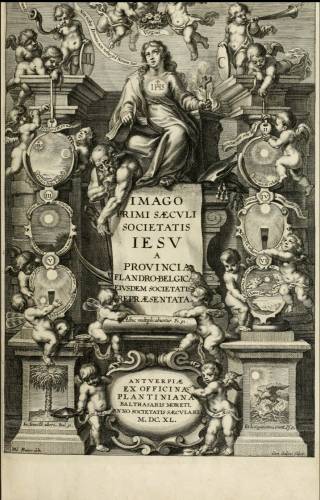 | Baroque Rome in Maffeo Barberini's Verse Letter to Lorenzo Magalotti 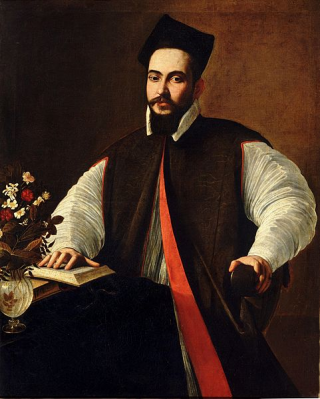 Portrait of Maffeo Barberini by Caravaggio, 1598
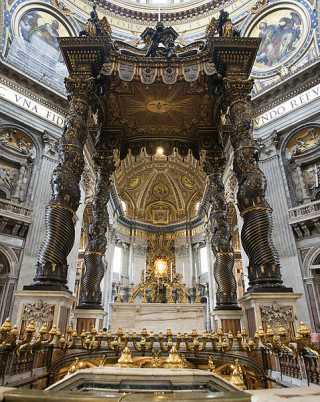 The famous Baldacchino (altar canopy) in St Peter’s Basilica, Rome, commissioned from Gianlorenzo Bernini by Pope Urban VIII, 1623-44 [https://commons.wikimedia.org/wiki/File:St._Peter%27s_Baldachin_by_Bernini.jpg] |
Poems and Pipelines: Latin Verse on the Fountains in and round Baroque Rome
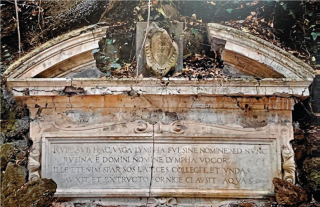 [Inscription above the ruined grotto at Villa La Rufina (photo author)] | Epidemic, Saint, and Epic Poetry: Verse Hagiography in the Baroque Period
[A reproduction of the painting San Carlo’s Procession of the Holy Nail by Pietro da Cortona (1667) from the church San Carlo ai Catinari in Rome] |
'Decollation of John the Baptist' from Reginald Scot's The Discoverie of Witchcraft (1584). |
[Willem van Swanenburg (c 1581-1612), Portrait of Daniel Heinsius, librarian and professor of Poetry, Greek and History at Leiden University, at the age of 26] by Jan Bloemendal | Baroque Latin or Broken Latin? The Case of Bonaventure Baron
[Portrait of Bonaventure Baron from St Isidore's College, Rome] | Latin Love Elegy: A Baroque Genre?
[Giovanni Ghisolfi (1623–1683), Figures conversing among ruins, a pyramid in the distance (detail)] |
The 16th Century's Knock on the Baroque [A history of Cicero owned by Gabriel Harvey, held at Trinity College Cambridge Library] |
| Polyhistor (1st edition, Lübeck 1688)
|
An Exhibition of Baroque Books and Prints from the Collections of our Project Partners
Cave, Scriptorum ecclesiasticorum historia literaria
(Merton College Library, Oxford)
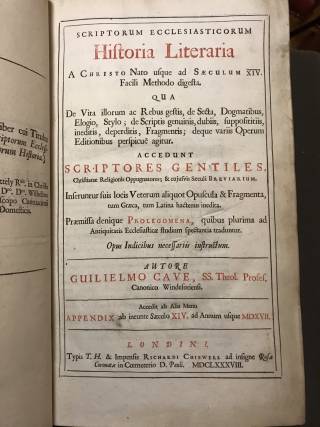
William Cave (1637–1713) was an Anglican cleric and a church historian, who was vicar of St Mary’s, Islington (1662–91), rector of All-Hallows, Upper Thames Street (1679–89), and vicar of Isleworth, Middlesex (from 1690). Cave was also chaplain to Charles II, and in 1684 was made a canon of Windsor, which allowed him to carry out research in the library and archives of the College of St George’s. With degrees from both Cambridge and Oxford, he was exceptionally learned and studious. Cave’s Scriptorum ecclesiasticorum historia literaria [London, 1688–89, 1698–99; Geneva, 1693–99, 1705, 1720; Cologny, 1720; Oxford, 1740–43 (2nd ed.); Basel, 1741–45 (2nd ed.)] is a biographical dictionary of ecclesiastical writers from the time of Christ to the sixteenth century, and was considered, even into the nineteenth century, as the best and most complete work on the literary history of the Church. Cave’s book is one of only two works on historia literaria (the history of scholarship) – an important European intellectual movement of the late seventeenth-century – to be published in England (the other being Thomas Pope Blount’s Censura celebriorum authorum).
Blount, Censura celebriorum authorum
(Merton College Library, Oxford)
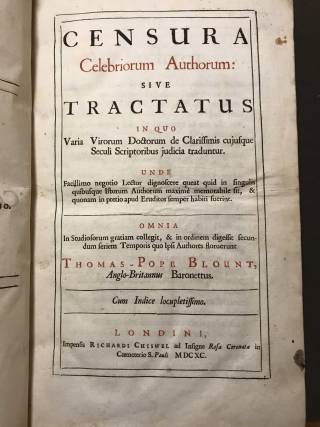
Sir Thomas Pope Blount (1649–1697) was a lawyer (member of Lincoln’s Inn from 1668), who served as the Member of Parliament for St Albans (1679–1681) and Hertfordshire (1689–1697), and was a Commissioner of Public Accounts (1694–1697). In December 1678 he inherited the estate of Tittenhanger in Hertfordshire from his mother, and in January 1679 was made baronet. The details of his education are sketchy, but among Blount’s few philosophical writings and works of literary criticism, his Censura celebriorum authorum (London 1690; Cologny/Geneva, 1694; Geneva, 1710) is remarkable for the breadth of learning that it contains. In this book, Blount gives brief biographies of authors – from Hermes Trismegistus to Tanneguy Le Fèvre – with critical opinions of their work and a guide to the best editions. As a result, the Censura, one of the largest collections of critical opinion published in the period, can be considered a survey of the common literary inheritance of early modern Europe.
Camden, William. Britannia. London, 1611
(Merton College Library, Oxford)
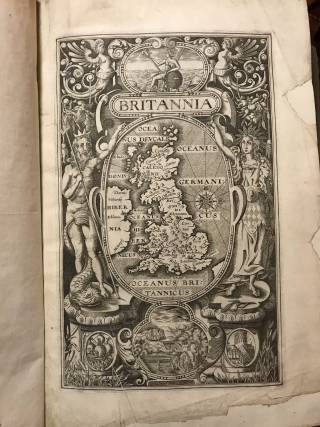
The first chorographical, county-by-county description of the British Isles, begun in 1577 and first published in 1586, it went through many editions in both Latin and English and was a major influence upon subsequent geographical and antiquarian writing. William Camden (1551-1623) became headmaster at Westminster School in 1593, where he had taught since the early 1570s. Ben Jonson was among his many famous pupils.
Laet, Joannes de. Novus orbis seu Descriptionis Indiæ Occidentalis libri XVIII. Leiden, 1633
(Merton College Library, Oxford)
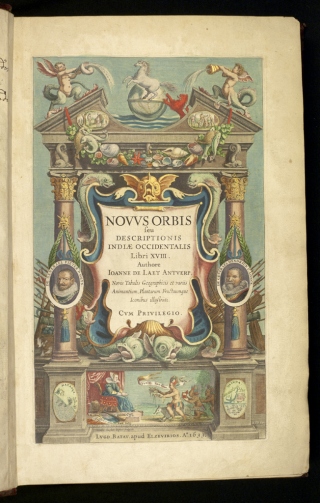
One of the most important seventeenth-century histories of the New World, written by Joannes de Laet (1581-1649), one of the founding directors of the Dutch West India Company. The volume is particularly renowned for its double-page maps, but contains a great wealth of information on many topics. Abraham Cowley’s Plantarum Libri Sex (1668), for instance, relied on it significantly for descriptions of the plants of the Americas.
[Masekhet Midot me-Talmud Bavli] hoc est ... = Talmudis Babylonici codex Middoth ... . Leiden, 1630
(Merton College Library, Oxford)
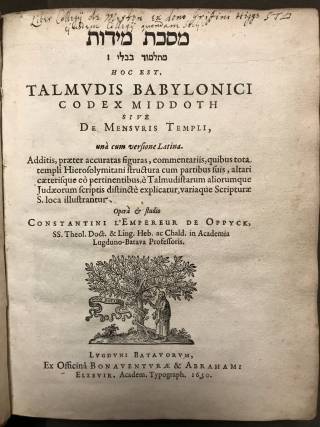
This impressive edition of the Talmud is a good example of the quality materials available for the study of Hebrew and Aramaic by the early seventeenth century, a period in which Hebrew was widely taught in the last years of school and at university in Protestant countries. Commentaries and explanations of the Book of Psalms and the Song of Songs were particularly common; though the poetic Hebrew of these books is difficult, they were frequently taught, probably because those Biblical books were particularly familiar to students.
Browne, Isaac Hawkins. Poems upon various subjects, Latin and English. London, 1768
(Welcome Institute Library, London)
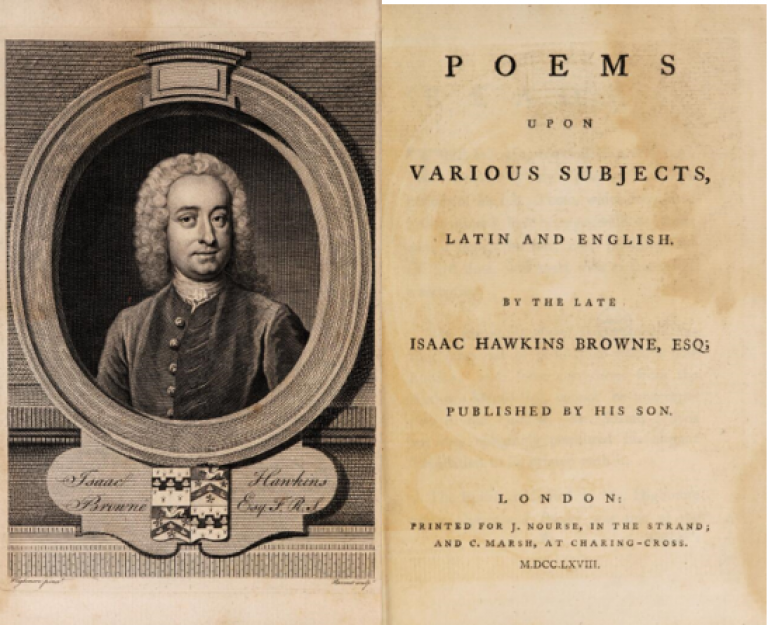
Cowley, Abraham. Abrahami Couleii Angli, Poemata Latina: in quibus continentur sex libri plantarum. London, 1678
(Wellcome Institute Library, London)
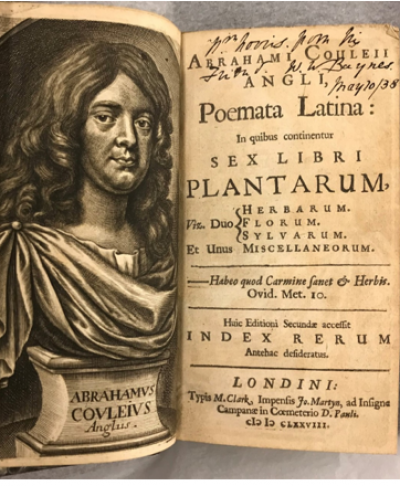
Cowley, Abraham. The Third Part of the Works of Mr. Abraham Cowley, Being his Six Books of Plants. London, 1689
(Wellcome Institute Library, London)
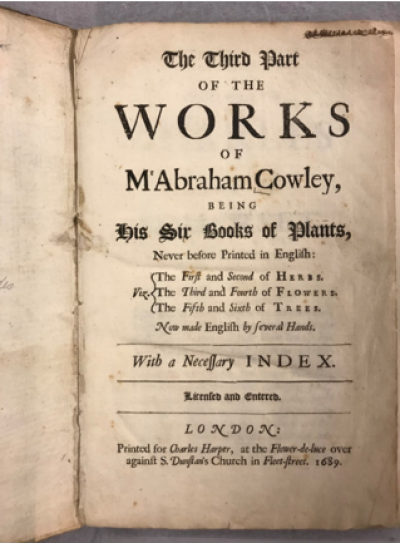
Harvey, William. Exercitationes de generatione animalium. London, 1651
(Merton College Library, Oxford)
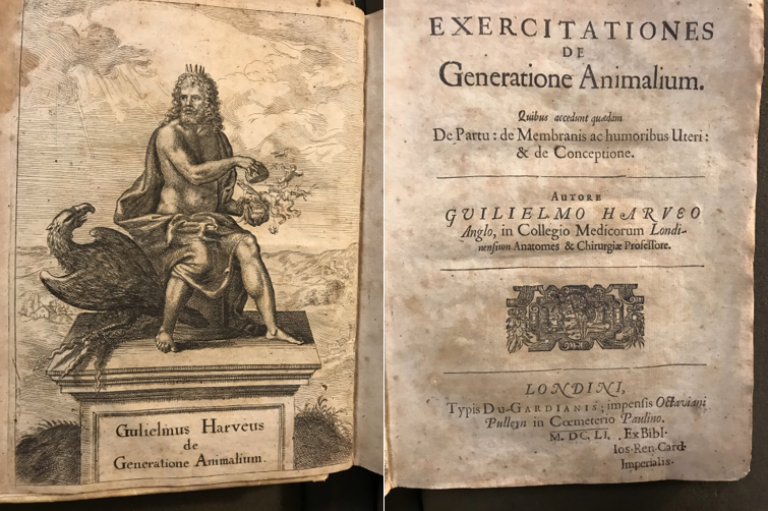
Milton, John. Paradisus amissus. Oxford, 1750–1753
(Merton College Library, Oxford)
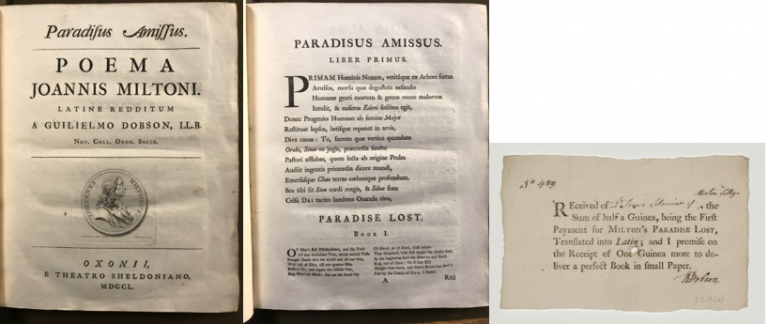
Morhof, Daniel Georg. Polyhistor, literarius, philosophicus et practicus. Lübeck, 1747
(Wellcome Institute Library, London)
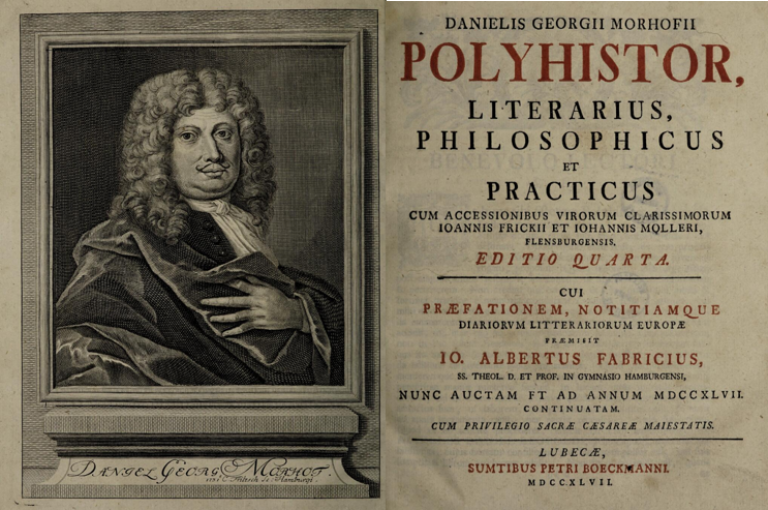
Pius II, Pope. Epistole & varij tractat[us] Pij Secu[n]di Po[n]tificis Maximi: : ad diuersos in q[ua]druplici vite …. Lyon, 1518
(Merton College Library, Oxford)
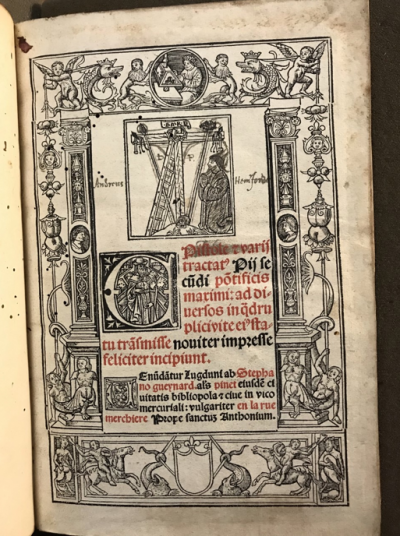
Saint Bernardino of Siena. Line engraving by J. Sadeler after F. Vanni
(Wellcome Collection, London)
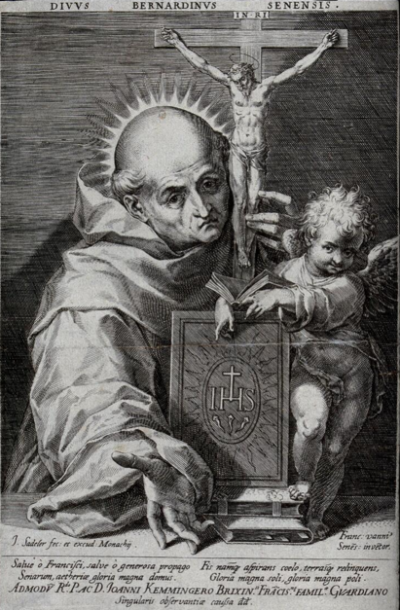
Pietro Testa (Lucca 1611-Rome 1650)
(Wellcome Collection, London)
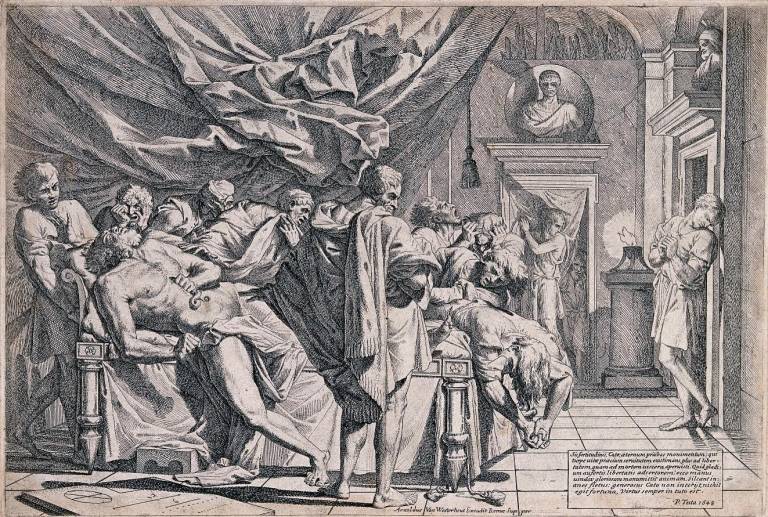
The suicide of Cato, following the description by Plutarch: Cato removes his own intestines. On the floor is the "little mathematical table that stood by", that fell to the floor and alerted Cato's attendants by its noise.
Etching by Pietro Testa, Rome 1648.
Pietro Testa (Lucca 1611-Rome 1650)
(Wellcome Collection, London)
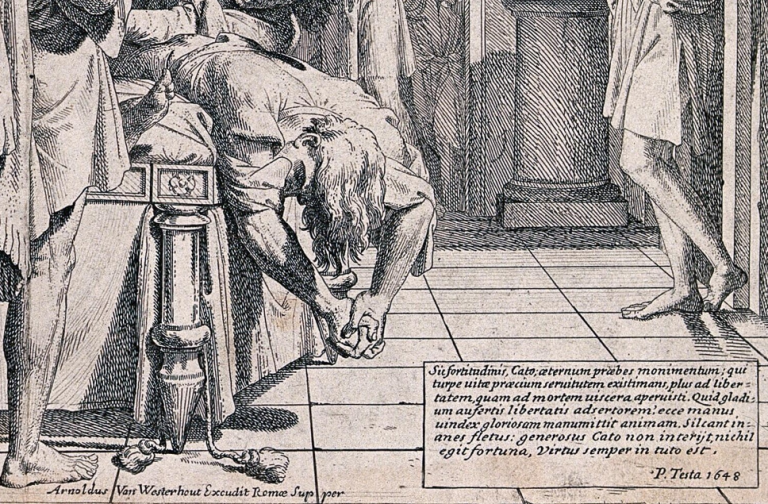
The suicide of Cato. Etching by P. Testa, 1648.
Detail: the tribute to Cato, engraved by Testa in 1648.
"Sileant inanes fletus: generosus Cato non interiit, nichil egit fortuna, virtus semper in tuto est."
Two years later, Testa drowned in the river Tiber, either by accident or by suicide: accounts vary.
Pietro Testa (Lucca 1611-Rome 1650)
(Wellcome Collection, London)
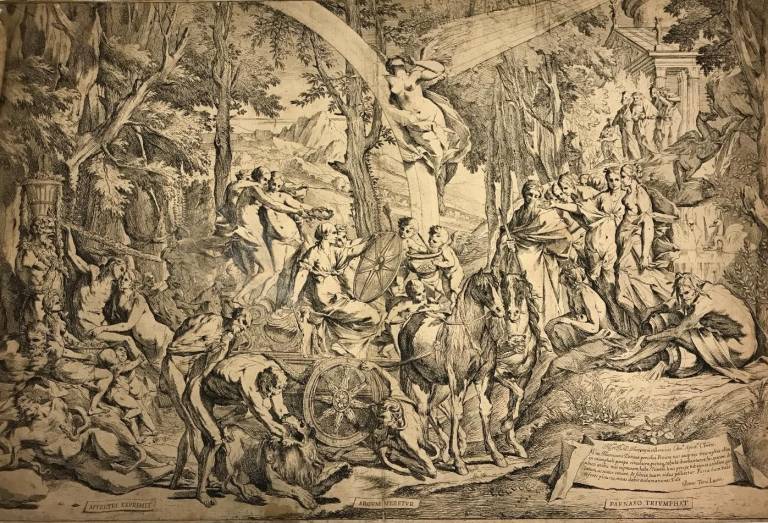
The personification of the art of painting, supported by Girolamo Buonvisi, arrives on a triumphal car at Mount Helicon where she is greeted by the muses. Etching by P. Testa, ca. 1644.
In the centre, a horse-drawn carriage proceeds under a rainbow created by rays of the sun shining on Iris. In the carriage, Pictura, the personification of painting, rides towards Mount Helicon. Pictura is painting a shield with the arms of Girolamo Buonvisi of Lucca (1607-1677).
In 1644 Buonvisi and other clerics in the Barberini faction at the Vatican lost power when Innocent X was elected Pope, a member of the Pamphili family. Buonvisi retired temporarily to Lucca, and Testa here marks his return to the native city of both of them.
Pietro Testa (Lucca 1611-Rome 1650)
(Wellcome Collection, London)
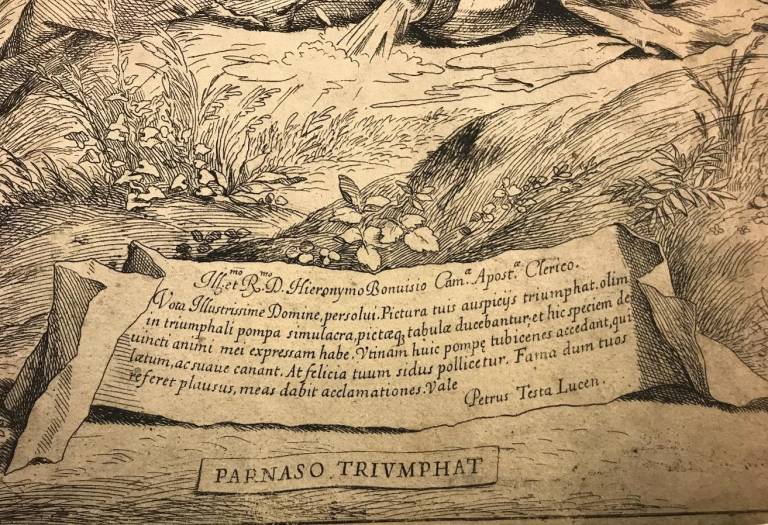
The personification of the art of painting, supported by Girolamo Buonvisi, arrives on a triumphal car at Mount Helicon where she is greeted by the muses. Etching by P. Testa, ca. 1644.
Detail: the dedication to Buonvisi, engraved by Testa, comparing Buonvisi's return to Lucca with an ancient triumphal procession, and regretting the lack of trumpeters to accompany the etching with "joyful and pleasant music".
Pietro Testa (Lucca 1611-Rome 1650)
(Wellcome Collection, London)
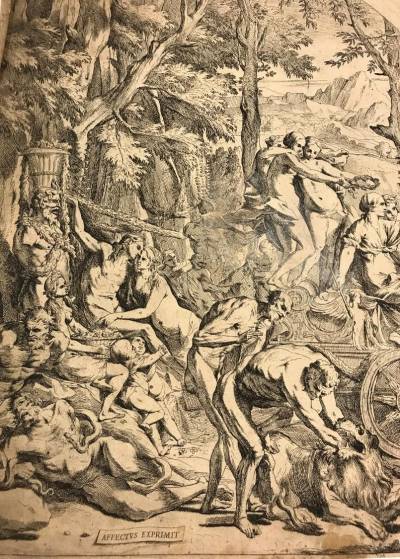
The personification of the art of painting, supported by Girolamo Buonvisi, arrives on a triumphal car at Mount Helicon where she is greeted by the muses.
Etching by P. Testa, ca. 1644.
This detail shows actions and expressions which have been recorded with the aid of painting, such as Laocoon being strangled by a snake, Pan, Flora, Samson fighting a lion, and Adam and Eve.
Romeyn de Hooghe (Amsterdam 1645-Haarlem 1708)
(Wellcome Collection, London)
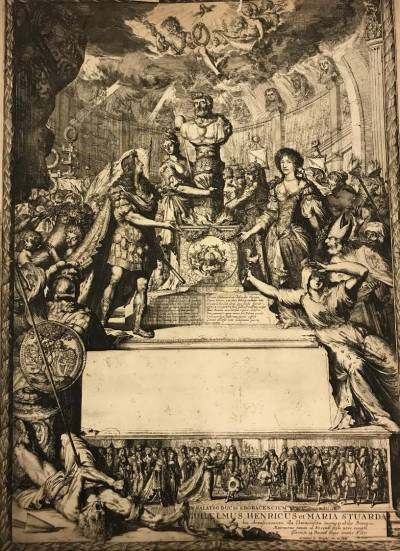
The dynastic marriage of William of Orange and Mary Stuart: above, they are brought together before a bust of Hercules; below, their wedding in London on 4 November 1677.
Etching by Romeyn de Hooghe, 1678.
Romeyn de Hooghe (Amsterdam 1645-Haarlem 1708)
(Wellcome Collection, London)

The inscription refers to the houses of Orange and York (Arausionenses et Eboracenses) as Aurea et Eburea (gold and ivory).
Detail of etching by Romeyn de Hooghe (Amsterdam 1645-Haarlem 1708)
(Wellcome Collection, London)
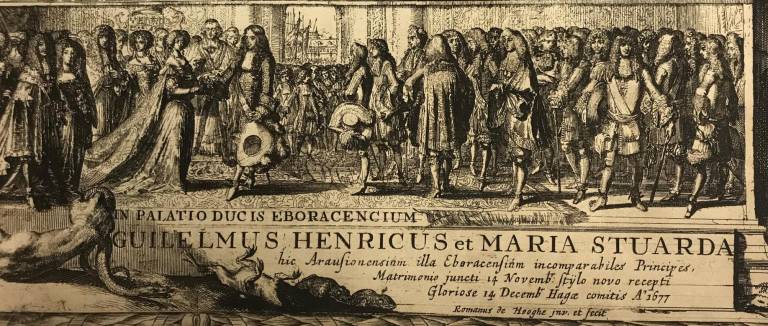
William and Mary being married by the bishop of London in St James's Palace. Beyond, through a window, the Banqueting House and Whitehall Palace are shown.
Flanders gladly receives Ferdinand of Spain, 1642. Etching by T. van Thulden after Sir P.P. Rubens
(Wellcome Collection, London)
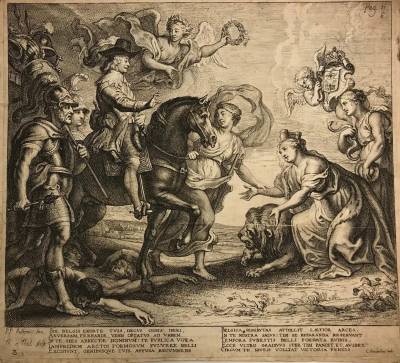
Latin verses by Jean-Gaspard Gevaerts (Caspar Gevartius) describe the scene. The woman with a city on her head, representing Flanders, revives the war-damaged Flemish cities: "Belgica semirutas attollit laetior arces."
Athanasius Kircher (Fulda 1601-Rome 1680)
(Wellcome Collection, London)
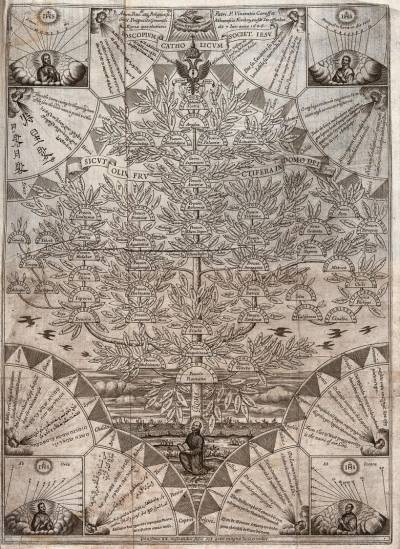
Horoscopium Catholicum Societ. Iesu.
"Sicut oliva fructifera in domo Dei"
A family tree of the provinces and colleges of the Jesuit order, with times and activities in each location at times relative to noon in Rome.
Engraving based on a clockwork automaton devised by Athanasius Kircher, 1646.
Engraving by J. Frey, Rome, 1725, after D. Zampieri, il Domenichino
(Wellcome Collection, London)
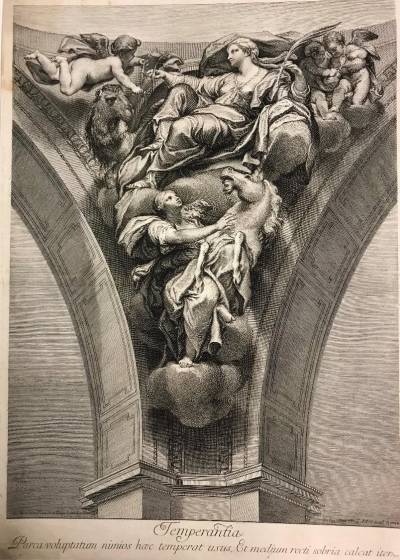
Temperance receives a bit in order to control a camel; below, she restrains a unicorn.
One print in a set of four prints of the four cardinal virtues by J. Frey after murals by Domenichino in the church of San Carlo ai Catinari in Rome. One of the prints (Justice) bears the date 1725.
Why a camel?
Francesco de Padoanis. Line engraving by Aegidius Sadeler (1568-1629)
(Wellcome Collection, London)
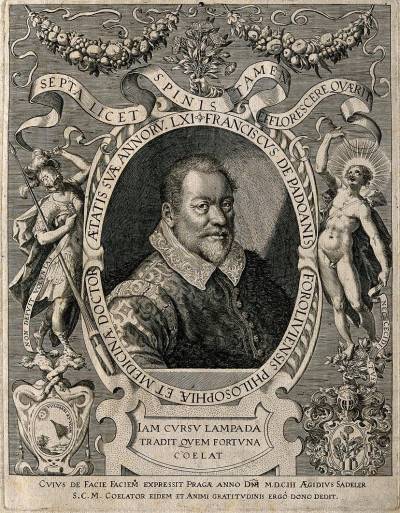
A portrait of one of the natural philosophers at the court of Rudolph II at Prague, in the characteristic style of Aegidius Sadeler, distinguished by Latin mottoes, allegories, scrollwork, pagan deities, emblems and devices.
Johannes Henisius (Johann Heins) (1585-1666)
Line engraving by W. Kilian after L. Kilian, 1638
(Wellcome Collection, London)
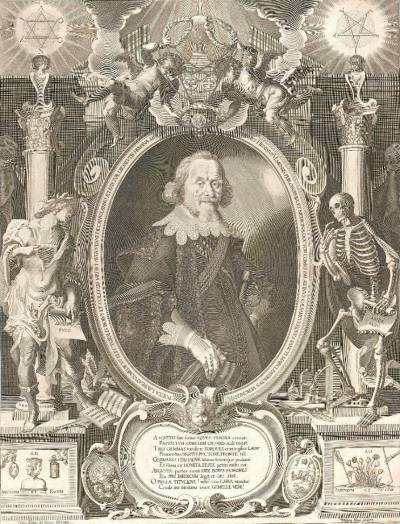
Lukas Kilian (1579-1637) worked at the court in Munich, where Heins was a physician to the Elector of Bavaria and dean of the college of physicians. Following the example of Aegidius Sadeler at Prague, Kilian includes a rich collection of attributes in the form of Latin mottoes, devices and figures.
Engraving by F. Spierre after Pietro da Cortona, Rome, 1666
(Wellcome Collection, London)
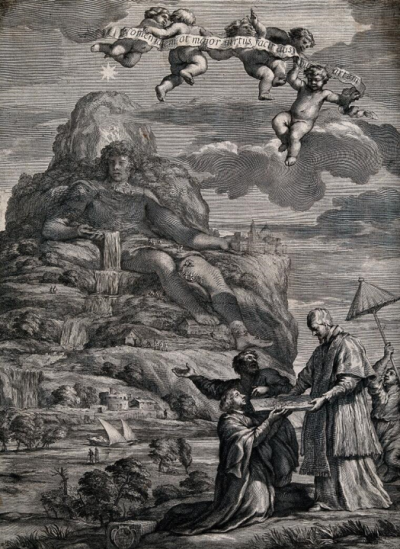
Cristobal Lozano presents to Pope Alexander VII an engraving of a mountain transformed into a statue of a man.
An allegory of Lozano's thesis Orandriansis hoc est montium in statuam transformatio (Rome 1666), in which Vitruvius's story about Alexander the Great is applied to Pope Alexander VII. The banderolle motto says, "Nomen idem, at maior virtus" (the name is the same, i.e. Alexander, but his virtue is greater).
Pietro da Cortona (1597-1669)
(Wellcome Collection, London)
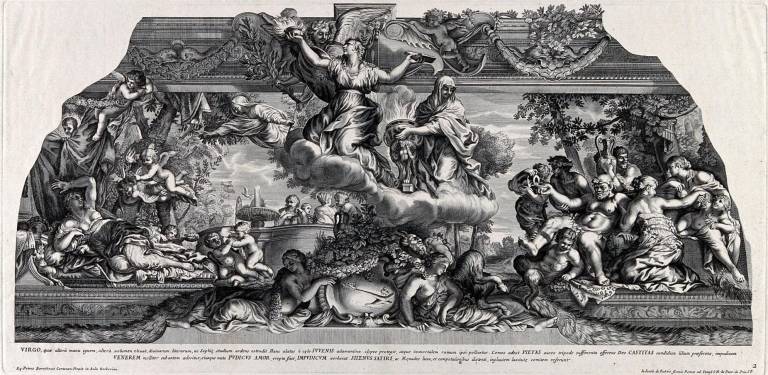
The love of divinity and wisdom and its effects on shameful love and indulgence. Engraving after Pietro da Cortona, Rome.
A fresco by Pietro da Cortona in the ceiling of the Palazzo Barberini, Rome
Ludovico Carracci (1555-1619)
(Wellcome Collection, London)
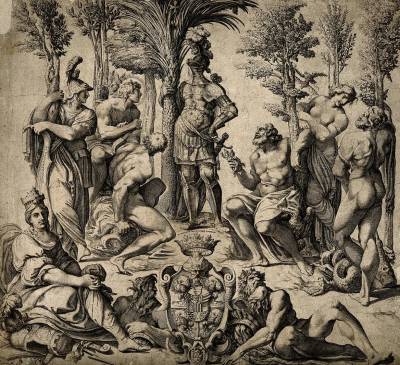
Federico Gonzaga, Duke of Mantua, on Mount Olympus, with pagan deities who hold the trees dedicated to them. Engraving by Oliviero Gatti after L. Carracci.
The trees have Latin mottoes. According to Bartsch, the print was known as 'The conclusion of the deities'; meaning "conclusion" of a thesis?
Federico was awarded the device of Mount Olympus by Charles V in 1522.
Saint Augustine of Hippo
(Wellcome Collection, London)
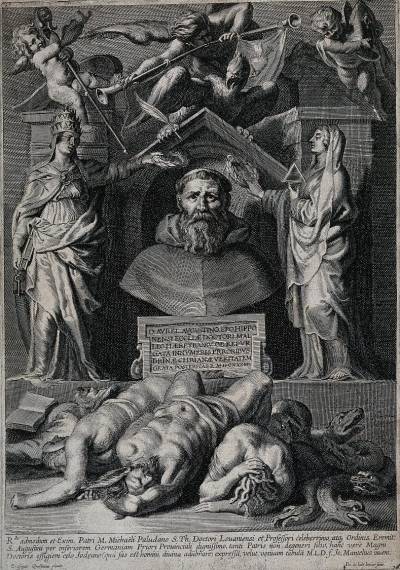
Line engraving by P. de Jode the younger, 1634, after a painting by Erasmus Quellinus II (1607-1678), using iconography suggested by Johannes Mantelius (1599-1676).
This Antwerp print foregrounds heretics defeated by Augustine, with his other attributes around a portrait bust depicting him in the habit of his own order.
Mantelius (Jan Mantels), who devised the iconography, was a senior member of the Augustinian order in Flanders.
Simon Vouet (1590-1649)
(Wellcome Collection, London)
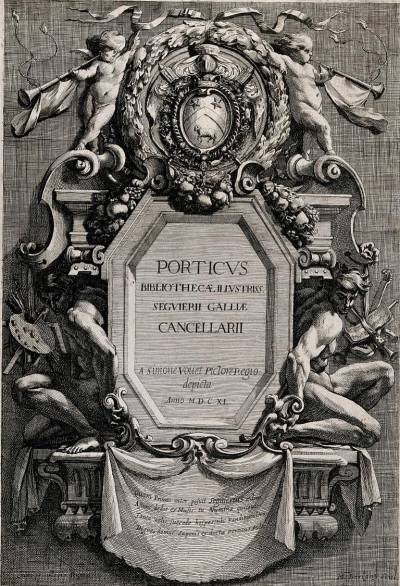
The "gateway" to the library of Pierre Séguier (1588-1672), chancellor of France and patron of the Académie française. Painting and music support putti trumpeting the fame of the library, which was elaborately decorated by Simon Vouet. The library contained a large number of manuscripts; a catalogue of the Greek manuscripts was published by Bernard de Montfaucon in 1715.
Engraving by Michel Dorigny after Simon Vouet, 1640.
Conclusions for a doctoral thesis submitted in Paris by Stephanus Landais, 1678
(Wellcome Collection, London)
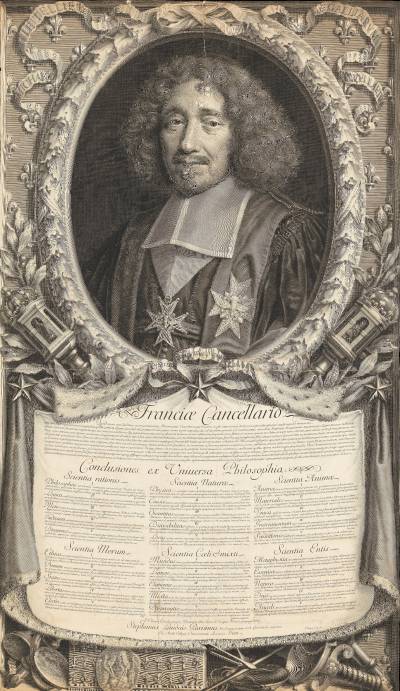
A thesis print, engraved as usual on a large scale (this one 107 x 62 cm) for a presentation of a doctoral thesis in the Jesuit Collège de Clermont in Paris, by one Etienne (Stephanus) Landais, 1678.
The honorific portrait, engraved by Robert Nanteuil, shows Michel Le Tellier (1603-1685), Chancellor of France under Louis XIV.
Thesis prints were also produced in Milan, Rome, Augsburg, and elsewhere in the 17th and 18th centuries, sometimes with portraits of university grandees, sometimes with allegories.
With thanks to members of the Baroque Latinity Network, who wrote the descriptions, and to the project partners, The Wellcome Collection and The Warden and Fellows of Merton College Oxford, who provided the images and gave permission for reproduction.
A Bibliography of Useful Sources
Andersen, L. | Baroque and Rococo Art | London and New York | 1969 | |
Angyal, A. | Die slawische Barockwelt | Leipzig | 1961 | |
Antony, J. R. | French Baroque Music | London | 1973 | |
Barner, W. | Der literarische Barockbegriff | Darmstadt | 1975 | |
Baur Heinhold, M. | Baroque Theatre | London | 1967 | |
Bazin, G. | The Baroque: Principles, Styles, Modes, Themes | London and Greenwich, CT | 1968 | |
Bazin, G. | Baroque and Rococo Art | London | 1964 | |
Binns, J. W. | Intellectual Culture in Elizabethan and Jacobean England: The Latin Writings of the Age | Leeds | 1990 | Specifically discusses Latin style - but NB only up to c. 1625 |
Binns, J. W. | The Latin poetry of English poets | London | 1974 | Includes discussion of Latin poetry within the 'baroque' period though does not necessarily engage directly with definition of 'baroque' re: Latin |
Birrel, T. A. | ‘Sarbiewski, Watts, and the Later Metaphysical Tradition’ | English Studies 37 (1956) | Includes discussion of Latin poetry within the 'baroque' period though does not necessarily engage directly with definition of 'baroque' re: Latin | |
Bradner, L. | Musae Anglicanae: A History of Anglo-Latin Poetry 1500-1925 | New York and London | 1940 | Includes discussion of Latin poetry within the 'baroque' period though does not necessarily engage directly with definition of 'baroque' re: Latin |
Buck, A. | Renaissance und Barock | Frankfurt a.M. | 1972 |
|
Bukofzer, M. F. | Music in the Baroque Era | London | 1948 | |
Burkard, T. | ‘Frühbarocker Manierismus?’ In: Würzburger Humanismus, ed. T. Baier and J. Schultheiss, 209–44 | Tübingen | 2015 | Attempts to delineate and define Latin mannerism (in restrictive stylistic terms) |
Busch, H. and Lohse, B. | Baukunst des Barock in Europa | Frankfurt | 1961 | |
Cohen, J. M. | The Baroque Lyric | London | 1963 | |
Coles, P. | The Ottoman Impact on Europe | London | 1968 | |
Davidson, P. | The universal baroque | Manchester | 2007 | Specifically discusses role of Latin style - one of few 'baroque' books to do so - essential to engage with this |
Dubois, Claude-Gilbert | Le Baroque en Europe et en France | Paris | 1995 | A good introduction to baroque writing all over Europe, with sections on the theory of the baroque and on descriptions of trends according to period; refers to writing in Latin |
Falkus, C. | The Life and Times of Charles II | London | 1972 | |
Friedrich, C. J. | The Age of the Baroque 1610-1660 | New York | 1952 | |
Gillespie, G. E. P. | Daniel Casper von Lohenstein's Historical Tragedies | Columbus, OH | 1965 | |
Greg, W. W. | Pastoral Poetry and Pastoral Drama | London | 1906 | |
Griffin, R. | ‘Agrippa D’Aubigné’s Le Printemps and Early French Baroque Poetry’ | Symposium 19.3 (1965): 197–213 | ||
Hager, W. | Baroque Sculpture | London | 1964 | |
Hall, A. R. | From Galileo to Newton 1630-1720 | London | 1963 | |
Hardie, P. (ed.) | Augustan Poetry and the Irrational | Oxford | 2016 | |
Hardie, P. (ed.) | Paradox and the marvellous in Augustan literature and culture | Oxford | 2009 | |
Hausenstein, W. | Vom Genie des Barock | Munich | 1962 | |
Hempel, E. | Baroque Art an Architecture in Central Europe | London | 1965 | |
Hill, J. P. and Caracciolo-Trejo, E. | Baroque Poetry | London and Totowa, NJ | 1975 | |
Hook, J. | The Baroque Age in England | London | 1976 | |
Howell, Wilbur Samuel | ‘Baroque Rhetoric: A Concept at Odds with its Setting’ | Philosophy & Rhetoric 15 (1982): 1-23 | ||
Hoyles, John | The Waning of the Renaissance 1640-1740 | The Hague | 1971 | Useful for fixing end-limit of phenomenon? Discusses Henry More, John Norris and Isaac Watts. Relates developments in poetry to those in philosophy, religion and wider aesthetics |
Huyghe, R. | Larousse Encyclopedia of Renaissance and Baroque Art | London and New York | 1964 | |
Kitson, M. | The Age of Baroque | London | 1966 | |
Klecker, E. | ‘Episches Theater im Barock’ | Wiener Studien 113 (2000): 335-358 |
|
|
Kubler, G. and Soria, M. | Art and Architecture in Spain and Portugal and their American Dominions 1500-1800 | London | 1959 | |
Lees-Milne, J. | Baroque in Spain and Portugal | London | 1960 | |
Leone, M. | Geminae voces. Poesia in latino tra Barocco e Arcadia | Lecce | 2007 |
|
Loftis, J. | The 'Revels' History of Drama in English. Vol. 5: 1660-1750 | London | 1976 | |
Martin, J. R. | Baroque | London | 1977 | |
Martz, L. | The Wit of Love | Notre Dame, IN | 1969 | |
Martz, L. | The Poetry of Meditation | New Haven, CT | 1954 | |
Mathieu-Castellani, G. | Mythes de l’Eros baroque | Paris | 1981 | |
Mathieu-Castellani, G. | Éros baroque: anthologie de la poésie amoureuse baroque, 1570- | Paris | 1986 | |
Mirollo, J. | Mannerism and Renaissance Poetry: Concept, Mode, Inner Design | New Haven | 1984 | |
Mirollo, J. | The Poet of the Marvelous | New York | 1963 | |
Money, D. | ‘Aspects of the Reception of Sarbiewski in England’. In: Pietas humanistica, ed. P. Urbański | Frankfurt | 2006 | Includes discussion of Latin poetry within the 'baroque' period though does not necessarily engage directly with definition of 'baroque' re: Latin |
Money, D. | The English Horace: Anthony Alsop and the tradition of British Latin verse | Oxford | 1998 | Alsop is usually considered classical in style, but the intro has important summary of earlier British Latin poetry, and covers some of the post-Binns gap |
Morgues, Odette De | Metaphysical Baroque and Précieux Poetry | Oxford | 1953 | Still v. useful in my opinion (VM) |
Nash, J. M. | The Age of Rembrandt and Vermeer. Dutch Painting in the Seventeenth Century | London | 1972 | |
Orozco Díaz, E. | El teatro y la treatralidad del Barroco | Barcelona | 1969 | |
Petersson, R. T. | The Art of Ecstasy: Teresa, Bernini and Crashaw | London | 1970 | |
Pinder, W. | Deutscher Barock | 1961 (rev. ed.) | ||
Robertson, A., and Stevens, D. | Renaissance and Baroque | London | 1963 | |
Rosa, A. A. | Il Seicento. In: La letteratura italiana; storia e testi, Vol. V. | Rome | 1974 | |
Rousset, J. | La littérature de l’âge baroque en France: Circé et le paon | Paris | 2002 (repr.) | |
Schoolfield, G. | ‘Propertius and Opitz: A Compound Footnote’ | Daphnis 21.1 (1992): 27–43 | ||
Sewter, A. C. | Baroque and Rococo Art | London | 1967 | |
Shepard, J. C. | Mannerism and Baroque in Seventeenth-Century French Poetry: The Example of Tristan L’Hermite | Chapel Hill | 2001 | |
Skrine, Peter | The Baroque: Literature and Culture in Seventeenth-Century Europe | New York | 1978 | |
Smit, W. A. P. and Brachin, P. | Vondel | Paris | 1964 | |
Spahr, L. B. | Problems and Perspectives. A Collection of Essays on German Baroque Literature | Frankfurt a.M. | 1981 |
|
Stamm, R. | Die Kunstformen des Barockzeitalters | Berne | 1956 | |
Stoye, J. | Europe Unfolding 1648-1688 | London | 1969 | |
Tapié, V. L. | The Age of Grandeur. Baroque Art and Architecture | New York | 1960 | |
Tapié, V. L. | Le Baroque (Que sais-je? No. 923) | Paris | 1974 | |
Testi, F. | La musica italiana nel seicento | Milan | 1972 | |
Vincent, Robert Hudson | ‘Baroco: The Logic of English Baroque Poetics’ | Modern Language Quarterly 80.3 (2019): 233-259 | ||
Warnke, F. J. | Versions of Baroque: European Literature in the Seventeenth Century | New Haven, CT and London | 1972 | |
Warnke, F. J. | European Metaphysical Poetry | New Haven and London | 1961; 1974 | Verse anthology with v. interesting introduction |
Waterhouse, E. | Italian Baroque Painting | London | 1969 (rev. ed.) | |
Wellek, R. | ‘The Concept of Baroque in Literary Scholarship’ | The Journal of Aesthetics and Art Criticism 5.2 (1946): 77–109 | ||
Wilson, M. | Spanish Drama of the Golden Age | London | 1969 | |
Wittkower, R. | Art and Architecture in Italy 1600-1750 | London | 1958 | |
Wolf, A. A. | A History of Science and Technology in the 16th and 17th Centuries | New York and London | 1935; 1962 (3rd ed.) |
 Close
Close


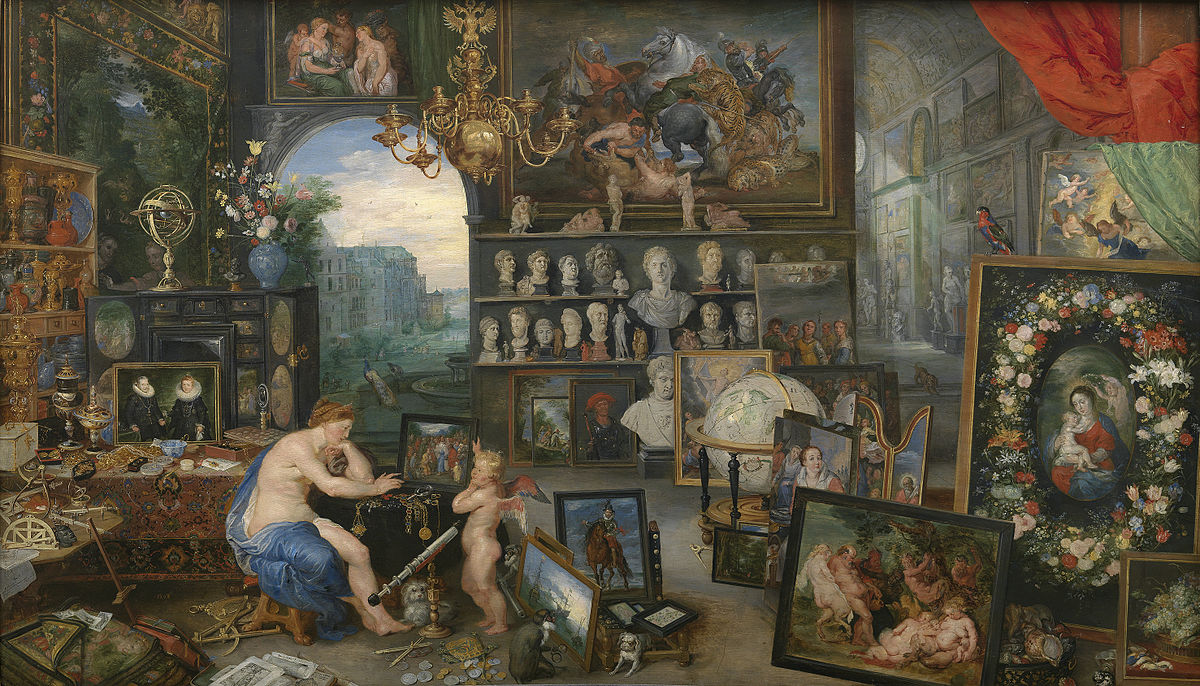 (Jan Brueghel I & Peter Paul Rubens, ‘Allegory of Sight’, Museo del Prado)
(Jan Brueghel I & Peter Paul Rubens, ‘Allegory of Sight’, Museo del Prado)